July 31, 2016
Prom 20: Berlioz, Romeo and Juliet
Berlioz’s Roméo et Juliette was inspired by the ‘supreme drama’ of the composer’s life when, in 1827, he first saw the actress Harriet Smithson performing with Charles Kemble’s theatrical troupe in Paris. The score is suffused with passion and tenderness: for Smithson, who five years later would become his wife; for the playwright, whose ‘poetic thread whose golden tracery enfolds his marvellous ideas’ left Berlioz stunned, penetrated by ‘Shakespearean fire’; and for Juliet, Ophelia and Desdemona whose tragic pathos became inextricably fused with his love for Smithson - leading Berlioz to write to a friend in 1833, in anticipation of seeing Smithson again, ‘I am mad, dearest I am dead! Sweetest Juliet! my life, my soul, my heart, all, all, ’tis the heaven, oh!!!!!! … parle donc, mon orchestre’.
Gardiner, who recorded the work with these ensembles in 1998, summoned a performance from his large forces which was similarly flushed with sensitivity and care, supported by the conductor’s encyclopaedic familiarity with the score’s richly variegated details. He made sure that we recognised just how remarkable Berlioz’s independence and invention truly are, and he gave us some novelties too, reinstating the second Prologue, after the Queen Mab Scherzo and before the Capulets’ Convoi funèbre upon the discovery of Juliet’s death, which itself included inserted material setting the Requiem mass.
For those who are still inclined to associate Berlioz, that most misunderstood of composers, with massive musical tempests, dissonant disturbances, and platoons of brass and percussion, this performance will have been a revelation. Not for nothing did his Treatise on Orchestration establish his reputation as a master of instrumentation and the founder of the modern orchestra. We had a full battery here including five trombones, four bassoons, ophicleide and enough percussion instruments to keep six players busy. But, while he made the most of the dramatic climaxes, subtlety was Gardiner’s watchword. He showed that the work is ‘monumental’ not because of the sheer size of sound conjured, but because of the meticulousness of the way the kaleidoscopic ‘narrative’ details are married with formal necessities in a work where volume is superseded by sonority.
In his preface to the score, Berlioz made it clear that he viewed the work as ‘a symphony, and not a concert opera’, believing that Romeo’s meditation, the Capulets’ ball the Scène d’amour could be better depicted without the limiting specificity of words. Of the three solo voices, only the bass - who takes the role of Friar Lawrence in the Finale - embodies an individual character, and it is the ‘symphonic’ music which bears the burden of expression and dramatic development.
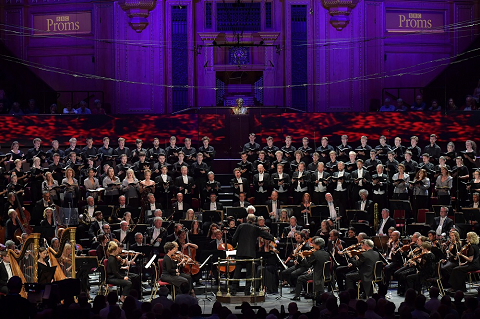 Sir John Eliot Gardiner conducts. Photo Credit: Chris Christodoulou.
Sir John Eliot Gardiner conducts. Photo Credit: Chris Christodoulou.
The Orchestre Révolutionnaire et Romantique gave us a stirring performance and a wide expressive palette. The brass had a dark coloration which was perfect for establishing the stature of the tragedy at the start and the full, homophonic chords of the trombones, horns and ophicleide were menacing in depicting the hot anger of the Prince who subdues the muttering of the rowdy rabble-rousers in Verona’s streets. There was scrupulous attention to the strings’ timbre and articulation with only light vibrato employed; in particular, Gardiner repeatedly quelled the sound to the barest whisper, the bows barely brushing the string but the large complement of players ensuring that the merest breaths of sound had softness and fullness. Cello and double bass pizzicatos were by turn astonishing agile - there must have been some sore right fore-fingers as Berlioz puts the players through their paces - and beguilingly harp-like. String tremolos shivered, shimmered and glimmered. Spiccatos were as light as butterflies’ wings, and the muted saltato bows combined with chattering woodwind, harp harmonics and the ting of antique cymbals in the Queen Mab scherzo to magical effect.
In the ball scene the high-registered strings and woodwind brought radiance and vivacity to the celebration. Berlioz’s woodwind divulge the protagonists’ hearts: oboist Michael Niesemann painted a sensuous portrait of Juliet as she lives in Romeo’s erotic fantasy while in the Part 3 Scène d’amour softly sustained horns, and clarinet and cor anglais in octaves sang beautifully above the exquisite richness of the quiet divided strings.
There were a few slips, mind. Gardiner set off at a recklessly frenetic pace, and while the period-instruments’ tone added an authentic touch of roughness to the patrician rioting, it was a bit too fast and furious, even disordered, and we weren’t able to enjoy the full originality of Berlioz’s rhythmic conversations in the Allegro fugato.
Gardiner did not always judge the acoustic effectively either. Yes, Berlioz does distinguish between p, pp and ppp - but surely he did want us to hear the notes he’d written? At times the diminuendos drew the delicacies into niente, and I doubt those seated in the furthest reaches of the Hall, and standing in the Gallery, could hear some of the most fragile details, including the cheeky chimes of the antique symbols which close Queen Mab - which is a pity as the percussion player had walked to the front of the stage to deliver them.
Another aspect of the performance that gave me pause for thought was the ‘choreography’. The stage began bare of singers and the Monteverdi Choir semi-chorus walked onto the stage during Part 1 to deliver their expressive narration - sung with meditative beauty and exemplary French phrasing, and accompanied by harp, cor anglais and obbligato cello - to set the dramatic scene. Placed in front of Gardiner, at the very front of the stage (middle to left) they were conducted by an unnamed conductor who was standing in the Arena. (I've subsequently learned that this was Dinis Sousa.) This seemed unnecessarily fussy (the conductor was kept busy, racing up to the Gallery for the off-stage chorus of Young Capulets) and became more irritating when the semi-chorus then walked off stage during the Prince’s stern intervention, distracting us from the tragic overtones of the brass’s disapproving dismissal of the bickering citizens.
The sense of disruption was unfortunately made worse by noisy late-comers at the opening of Part 2: with so much shuffling, seat-banging and fidgeting, Romeo seemed far from ‘alone’ as the strings descended through the chromatic, ppp, sinuous line which embodies the young lover’s melancholy solitude - and Gardiner’s determination that the strings should diminish to the point of vanishing didn’t help. Later, during the funeral cortege, the National Youth Choir of Scotland literally brought the sombre procession to life, walking onto the raked choir-seating - in perfectly rehearsed formation but with less than silent footsteps - just as the accumulating textures and harmonies in the orchestra developed their fugal lament.
But, these were minor blots in a performance that on the whole cohered impressively, aided by some fine singing from three French soloists. Mezzo-soprano Julie Boulianne brought star-quality to her Act 1 narration with the semi-chorus: her rich voice had real presence and weight in the Hall, even in the most intimate and understated melodic gestures, and the long vocal lines unwound compellingly.
Jean-Paul Fouchécourt (who performed on the 1998 recording) used his agile high tenor and strong colour to good effect in the Part 1 Scherzetto in which the tenor mocks Romeo’s love. Bass-baritone Laurent Naouri presented the heartfelt, honourable pleas of Friar Laurence in beautifully elegant French declamation and found a nobility of line that gave moral stature to the recitative in which he unveils the truth. He was a little lacking in weight, however, and at times was almost overwhelmed by the angry choral condemnations of the duplicitous cleric. The young voices of the NYCS were vibrant if rather polite, but the strength of the choral finale - the women’s voices eventually joining those of the men, added a sort of beneficent glow - gave conviction to Berlioz’s apparent intent that at the final reckoning reconciliation triumphs over tragedy.
In its communication of Berlioz’s intense individualism and subjectivity, and obsessive feeling, this performance was truly Romantic.
Claire Seymour
Berlioz: Romeo and Juliet (sung in French)
Julie Boulianne (soprano), Jean-Paul Fouchécourt (tenor), Laurent Naouri (bass-baritone), Sir John Eliot Gardiner (conductor), Monteverdi Choir, National Youth Choir of Scotland (chorus-master, Christopher Bell), Orchestre Révolutionnaire et Romantique (leader, Kati Debretzeni).
Royal Albert Hall, London; Saturday 30th July 2016.
image=http://www.operatoday.com/Julie%20Boulianne%20Christodoulou.png
image_description=Prom 20: Berlioz, Romeo and Juliet
product=yes
product_title=Prom 20: Berlioz, Romeo and Juliet
product_by=A review by Claire Seymour
product_id=Above: Julie Boulianne, with the Monteverdi Choir
Photo credit: Chris Christodoulou
Prom 18: Mahler, Symphony No.3
He showed that again here, and how - with a London Symphony Orchestra on outstanding form. Haitink did not seem to offer a particular point of view on the work, but nor did he conduct with anonymity: something that could, on occasion, prove a problem in this music, during his later years, for Claudio Abbado - or at least a problem for me. Rather, one had a sense, even though one knew it to be unfounded, even nonsensical, that this was somehow the music ‘itself’ we were hearing.
Haitink opened the first movement briskly, but the opening phrase’s subsiding both told of possibilities ahead in this movement and beyond (the prefigurement of the fourth movement’s ‘O Mensch’ as clear, as telling, as I can recall). There was no doubt that this was a march: how could there be with the LSO drummers on such magnificent form? But there was far more to the LSO’s performance than military might: this was Mahler with great warmth and unanimity of attack. It was post-Wagnerian Mahler, with equal emphasis on the ‘post-’ and the ‘Wagner’. The huge orchestra notwithstanding, Mahler’s ability to conjure up a miraculous array of chamber ensembles - always, be it noted, directed by Haitink - never ceased to amaze. When those phantasmagorical flutes began their chorale-like passage - and, again, when it returned - Haitink held the tempo back slightly, hinting perhaps that summer marching in might not all be good; it might even be bad, although undoubtedly irresistible, as leader Carmine Lauri’s sinuous solo suggested. The gravity of the trombones seemed to reach back across the centuries, past Mozart’s Requiem, to ancient (relatively speaking) Habsburg equale. Tempi shifted with infinite subtlety; this was no ‘look at me, the conductor’ Mahler, for Haitink wanted us to look at Mahler. Marching onward, the woodwind in particular seemed almost to threaten metamorphosis into the deathly marionettes of the Sixth Symphony; equally crucial, though, that metamorphosis never happened. For this was marching that could be enjoyed too, almost as if we were paying a decidedly non-Marschallin like visit to the Prater. But then, there came disintegration: it was not just, or even principally shattering; it was perhaps closer to Mendelssohnian exhaustion. Attempts at rejuvenation or resuscitation were thereby rendered all the more ambiguous. The loudest offstage percussion I can recall (up in the Gallery, I think) heralded the recapitulation: it was as before, yet utterly transformed. And how the differences in the material were now revealed - or, so it seemed, revealed themselves! The end, when it came, was not lingered over; whatever Haitink may be, he is no sentimentalist. There was, indeed, a touch of Haydn to it.
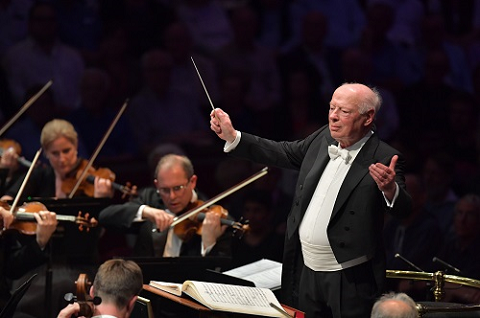 Bernard Haitink conducting the London Symphony Orchestra. Photo Credit: Chris Christodoulou.
Bernard Haitink conducting the London Symphony Orchestra. Photo Credit: Chris Christodoulou.
A graceful oboe solo (Oliver Stankiewicz) and gracious second violins’ response set the tone for the second movement. Except soon it became clear that it had not; it was not long before unease set in, from within the music, nothing appliqué. Indeed, there was as much unease in ‘beauty’, whatever that might be, as in dissonant corrosion thereof. Thematic profusion seemed almost to rival Mozart - and this music is perhaps still more difficult to hold together. (So many conductors, often praised to the rafters, fail here.) Haitink’s rubato was expertly judged: again there was nothing self-regarding to it, but rather it always made a musical point; so did his ritenuti. He revealed to us all manner of connections, intra- and extra-musical, whether intentionally or otherwise. Not the least of them was the sweetness, inviting yet not without malignance, of Alt-Wien, that malignance ever more present towards the close.
We heard, almost stepped into, a city dweller’s countryside in the third movement: its nightmares as well as its dreams. This was, it seemed, Mahler exploring the terrain of Hänsel und Gretel, only with more overt nastiness. Internal coherence was just as striking: at times, we seemed close to Webern’s Bach. Until, that is, we could not be more distant from it. Cross-rhythms were as disconcerting as those of Brahms, whatever the gulf that might otherwise separate the two composers (in both of whose music Haitink has long excelled). The trumpet’s presentiments of the posthorn solos have never registered so strikingly to me. And how wondrous that sounded, from afar, in Nicholas Betts’s flugelhorn rendition. Again, there was more than a hint of modernist Mendelssohn. Above all, though, it moved: with dignity, with nobility, rather than pleading for us, Bernstein-like, to shed tears. Instrumental scurrying also had something of A Midsummer Night’s Dream to it: Mendelssohn and Shakespeare. With that ‘Nocturne’ in mind, it seemed especially fitting that the French horns as well as the posthorn should have us hold our collective breath once again. We flitted around a weird liminal zone, combining Webern and Mendelssohn; on reflection, is that not often what Mahler is? A hint of balletic Tchaikovsky was swiftly banished by parodic ‘triumph’. And then, everything, or so it seemed, was to be heard that had gone before: together and eternally separate, alienated.
Sarah Connolly brought equal sincerity and subtlety to her vocal part in ‘O Mensch!’ Indeed the different colourings of the first statement of those words and her repetition of them spoke volumes; likewise the ensuing ‘Gib acht!’ The orchestral backdrop, if one can call it that, sounded again close to Webern in its shifting colours. Haitink’s strength of symphonic purpose was, however, quite different in nature (which is not, of course, to imply that Webern has not strength of purpose!) I have heard more contralto-like performances, but there was no denying the excellence of Connolly’s blend of Wort and Ton, nor the strength of the emotional response provoked. Indeed, perhaps not coincidentally, given her recent performances of the role, there was something Brangäne-like to her warnings, the deepness of Nietzschean midnight already in danger of disruption.
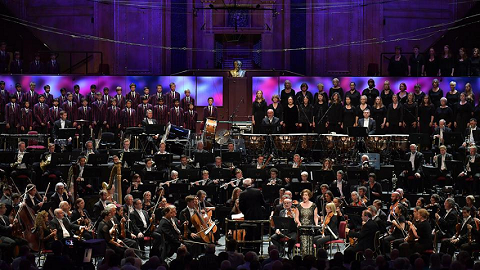 Bernard Haitink, Sarah Connolly and the London Symphony Orchestra and Chorus. Photo Credit: Chris Christodoulou.
Bernard Haitink, Sarah Connolly and the London Symphony Orchestra and Chorus. Photo Credit: Chris Christodoulou.
The boys’ calls of ‘Bimm bamm’ - I have heard dull people decry this wondrous moment as ‘silly’, when nothing could stand further from the truth -came as a fifth-movement, quite heavenly wake-up call from such Tristan-esque reverie. Connolly, intriguingly, continued to warn; it was certainly not only Haitink who understood how the two movements are connected. The women’s chorus and the LSO stood somewhere in between: mediators, perhaps even sainted mediators.
Quiet, infinite warmth marked the hymnal intensity of the LSO strings at the opening of the finale. I thought of - and felt - Communion. ‘What God tells me’, indeed! There was an almost Nono-like imperative to listen, as the strings spoke to us not just corporately, not just sectionally (what viola playing!) but, so one fancied, from individual desks and individual positions at those desks too. Fragility and strength were partners as the movement gathered pace, as something or Something revealed itself or Itself. There was, moreover, a well-nigh Beethovenian benevolence of spirit, albeit more vulnerable, to be experienced, perhaps even a little neurosis aufgehoben. And how Haitink guided the unfolding of that long line of unendliche Melodie; how he and his players communicated that echt-Romantic Innigkeit, so close to Schumann and yet alienated from him as modernity must be! For there was a Lied-like simplicity to what we heard and felt. This is difficult music, but its difficulty is accessible to anyone with a heart - and a mind. Unlike, alas, the idiot who disrupted the silence-that-never-was by shouting ‘Yeahhhhhhhhh!’ How can people be quite so inconsiderate? Still, that was an irritation rather than a catastrophe; the performance, both then and in recollection, rose far, far above it.
Mark Berry
Sarah Connolly (mezzo-soprano); Tiffin Boys’ Choir (chorus master: James Day); London Symphony Chorus (chorus master: Simon Halsey); London Symphony Orchestra/Bernard Haitink (conductor). Royal Albert Hall, London, 29 July 2016.
image= http://www.operatoday.com/Prom%2018%20Sarah%20Connolly%20Chris%20Christodoulou.png image_description= Prom 18: Mahler, Symphony No.3 product=yes product_title=Prom 18: Mahler, Symphony No.3 product_by=A review by Mark Berry product_id=Above: Sarah ConnollyPhoto credit: Chris Christodoulou
Munich Opera Festival Baroque Concert: Music from the Court of Louis XIV
Music from the court of Louis XIV covers, after all, a good number of years, the king having reigned between 1643 and 1715. The works by Marais and Couperin at the close were probably the latest, both dated 1711, four years before Louis’s death. Rather to my surprise, although not without exception, it was the first half that proved more compelling as a performance to me. Perhaps that was partly a matter of having tired a little; although this repertory certainly interests me, I can lay no claim to great expertise. One has to listen intently to appreciate its subtleties and its variety, just as one does with, say, the music of Luigi Nono. Maybe, then, I am - perhaps unusually - more accustomed to listening to Nono.
For there was certainly variety in the programming, within its chronological and courtly framework. Its French title - ‘Au bord d’une fontaine - Airs et Brunettes’ - alluded nicely not only to one of the Charpentier works and implicitly to Versailles itself, but also to the celebrated 1721 collection of songs arranged for flute by Jacques Hotteterre, ‘ Airs et brunettes a deux et trois dessus pour les flutes traversieres tirez des meilleurs autheurs, anciens et modernes, ensembles les airs de Mrs. Lambert, Lully, De Bousset, &c les plus convenables a la flute traversiere seule, ornez d'agremens par Mr. Hotteterre Ie Romain et recueillis par M. ++++.’ And so, rather than arrangements, we heard ‘originals’, mostly vocal, with Claire Lefilliâtre as soprano, but with instrumental interludes, from viola de gamba (Friederike Heumann), theorbo (Fred Jacobs), and the two instruments in concert. We also heard a couple of recitations, Lefilliâtre reading from Corneille and La Fontaine.
What I think I missed most of all, especially during the second half, was something more outgoing in Lefilliâtre’s vocal performances. Now there is much to be gained from intimacy, which I valued greatly in the vocal music of Etienne Moulinié and Michel Lambert in particular, and not all of this music, indeed not much of it, is ‘operatic’, whether in a seventeenth- or a more modern sense. By the same token, however, there were times when, despite trying to listen as I could, I missed a greater sense of variation both within and between pieces.
The Italianate style of some of the first-half performances - more than once, I thought of Cavalli - initially surprised me, until I reflected on Cavalli’s own Ercole armante, commissioned by Mazarin for the 1662 wedding of Louis to Marie-Thérèse. As the harpsichordist Luke Green reminded me afterwards, the roots go back further, however: to the influence of Marie de’ Medici. Such tendencies are not absent, of course, even in Charpentier and Couperin; not only did I miss them being brought to the vocal foreground more strongly, however; I missed much of what made those composers different, more modern. Their music looks forward to Rameau as well as back to the earlier years of Louis’s reign. A further oddity was the inconsistency in Lefilliâtre’s ‘historical’ pronunciation, whether in the declamatory Corneille or the vocal items. I have no particularly strong feelings either way about the practice as such, whether in my own language or another, but it was unclear to me why some word endings should be pronounced and others not. Details matter in most music, but they certainly do here. Diction and intonation could sometimes be a little wayward too.
There was, though, a moving sincerity to Lefilliâtre’s performances at their best - enhanced for me by the warmth of the church acoustic, although others . Tales of love and death - are they not often one and the same? - drew one in. So too, very much, did not only the ‘accompaniments’ but the instrumental items. Heumann’s gamba playing proved her not only mistress of her instrument but above all a deeply sensitive musician, responding to it just as a fine pianist would to Chopin. The pieces from Marais’s Pièces de viole sounded not only as justly acclaimed summits of this still little-known (at least beyond certain circles) repertory, but as instrumental music fully fit to hold its own with more celebrated successors. Likewise Jacobs’s theorbo playing, pulse always clear, and for that reason capable of meaningful rather than arbitrary modification. I do not think I had heard the music of Robert de Visée before; it emerged in Jacobs’s hands as something clearly worthy of further exploration. And that, whatever certain reservations regarding vocal performances, is surely the point.
Mark Berry
Etienne Moulinié: Si mes soupirs sont indiscrets; Bien que l’Amour; O che gioia; Charles Hurel: Prélude; Nicolas Hotman: Allemande; Pierre Corneille: Psyché: ‘A peine je vous vois’; Michel Lambert: Ombre de mon amant;Vos mépris chaque jour; Sieur de Sainte-Colombe - Les Couplets; Sébastien le Camus: Laissez durer la nuit;Ah! Fuyons ce dangereux séjour; Amour, cruel Amour; Michel Lambert - Rochers, vous êtes sourds; Robert de Visée: Prélude;La Mascarade: Rondeau; Chaconne; Jean de La Fontaine - Fables, Livre XII, 14: ‘L’Amour et la Folie’; Charpentier - Profitez du printemps; Celle qui fait tout mon tourment; Au bord d’une fontaine; Sans frayeur dans de bois; Marin Marais - Pièces de viole, 3ème livre: Prélude and Grand ballet; Couperin - Zéphire, modère en ces lieux. Claire Felliâtre (soprano); Friederike Heumann (viola da gamba); Fred Jacobs (theorbo). Klosterkirche St Anna im Lehel, Munich, Monday 25 July 2016.
image= http://www.operatoday.com/Claire%20Lefilliatre.png image_description=Munich Opera Festival Baroque Concert product=yes product_title=Munich Opera Festival Baroque Concert product_by=A review by Mark Berry product_id=Above: Claire LefilliâtrePhoto credit: Sébastien Brohier
July 29, 2016
Les Indes galantes, Bavarian State Opera
Yet, whilst there has been much Handel, Monteverdi, Cavalli, et al., in recent years, the French Baroque in general and Rameau’s music in particular seem to have been a closed book - as so often in the world outside France. Let us leave aside for the moment debates concerning whether ‘Baroque’ should be a suitable designation, merely noting that Rameau’s music seems to have provoked the word’s first artistic usage. An anonymous letter to the Mercure de France, occasioned by the 1733 Paris premiere of the composer’s first opera, Hippolyte et Aricie, printed in the Mercure de France, dismissed the opera’s novelty as ‘du barocque’; its melody was incoherent, its harmony unduly dissonant, and its metre chaotic.
[Click here for a review of a streamed performance of this production.]
That was certainly not how Rameau sounded on this occasion, quite the contrary. Indeed, I should not have minded a little more truculence - if not incoherence! - from Ivor Bolton’s conducting. Its fluency was admirable, but I could not help notice - and, at times, become a little tired by - a tendency remarked upon by a friend beforehand: namely the conductor’s penchant for turning everything into a dance. There is much dance music, of course, in this opéra-ballet, but that is not to say that everything must be. I know that many ‘authenticke’ musicians will argue to the contrary, even, God help us, in Gluck and Mozart, but the declamatory French of Rameau’s recitatives - here, admirably, indeed often thrillingly, supported by a continuo group involving Luke Green (harpsichord), Fred Jacobs and Michael Fremiuth (theorbo), and Werner Matzke (cello) - is not necessarily to be confined to them. The ravishing airs, duets, and above all, ensembles, would have benefited, at least to my ears, from greater - dare I say, quoting the writer to the Mercure de France, more ‘chaotic’? - variation.
That said, and that said perhaps at too great a length, there was otherwise much to relish from the Munich Festival Orchestra. Even I did not find myself missing modern instruments. (This is, I learned afterwards, the Dresden Festival Orchestra on location.) Indeed, the woodwind in particular very much offered their own, splendidly Gallic justification. Moreover, strings (twelve violins, five violas, seven cellos, two bass viols, one violone) were certainly not parsimonious with their vibrato, quite from it; this was an enlightened as well as an Enlightened performance from all concerned. Rameau’s love of orchestral sound, its implications for Gluck and, via him, for Mozart too (think of Idomeneo!) was vividly and, above all, dramatically, communicated.
Sidi Larbi Cherkaoui’s direction, choreography included, treads a
judicious line between various competing elements. If I were a little surprised
that Munich chose this Rameau work as its first - for me, a tragédie
lyrique, such as Hippolyte, would have been a more obviously
compelling choice - then the voguish (for the 1730s, that is!) amalgam of opera
and ballet offered opportunities to ravish other of the senses too.
Cherkaoui’s dancers never disappointed, their movements - do these people
have no bones in their bodies? - not merely responsive to the music, to the
drama, but intensifying its possibilities, above all visual-dramatic tension at
points of decision. If one wished to visualise a Rameau flute line, for
instance, one could have done far worse than watch the movement on stage.
Without pressing his point too far, Cherkaoui probes what might hold this
prologue and four entrées - as in Rameau’s definitive version -
together. Opening in a classroom, the teacher, Hébé, leading her children in
conjugation of French verbs, the unified drama takes them - and us - on a tour
of different civilisations, and shows them, not the war personified by Bellone,
often to have as much to teach us as we have to teach them. That is not to say
that Rameau’s work, still less Louis Fuzelier’s libretto, can or
should be understood in twenty-first century terms; however, its ambiguity, its
insistence upon asking ‘who actually is the barbarian here?’
reminds us that we - and, looking at the world around us, how could we doubt
this? - have no monopoly on multicultural virtue.
Yet there are differences too. The homosexual love denied by the Incan Huescar (here in European clerical carb) in Cherbaouki’s funeral-turned-wedding setting for the second entrée also finds its fulfilment; L’Amour, for us today, does not discriminate, heterosexual and homosexual love are, ultimately, after a struggle, equally valued. Moreover, for an English visitor, more than unusually embarrassed by his nationality at the moment, Munich’s ecumenism offered hope that Europe and indeed the world beyond it will survive. National flags, favoured by Bellone and a visiting American President, are not banished, but there is a vision of something greater to be glimpsed, in the European flags - and, indeed, in the exquisite blue and yellow of many of the children’s outfits. (The Kinderstaterie of the Bavarian State Opera were well trained and delightful in their roles.) And so, the young men who forsake Hébé and Europe for the ‘Indies’ (an all-purpose, ‘exotic’ Orientalism or Occidentalism!), learn through experience that conflict is not the way to prosper; the realisation of the peace-pipe ceremony at the close strikingly fulfils the work’s strikingly internationalist sentiment, dancers and vocalists as one.
The singing was, without exception, wonderful. Words were as clear as Rameau’s lines, whether in solo, duet, ensemble, or choral numbers. The Balthasar-Neumann Chor was certainly not the least impressive aspect of the performance. Lisette Oropesa and Ana Quintans set the scene splendidly in the Prologue, Hébé and L’Amour carefully differentiated, with Goran Jurić a strikingly successful general-in-drag. Tareq Nazmi’s sensitive bass offered wisdom and humanity; Cherbaouki’s skilful comparison between the roles of Osman and Ali was given sympathetic life, as were other such doublings of roles (more than mere doublings). Mathias Vidal and Anna Prohaska shone likewise as Carlos/Damon and Phani/Fatime. Both imparted depth in lightness, and lightness in depth, as graceful on stage as of voice. Cyril Auvity’s unerringly stylish tenor, François Lis’s deep yet never bluff bass, and Elsa Benoit’s sparkling yet variegated soprano offered other highlights; so too did the highly attractive chiaroscuro of John Moore’s baritone. Above all, there was a true sense of collaboration, rendering the performance as well as the work substantially more than the sum of its parts. As we once hoped - and perhaps may one day hope again - for a Europe too often divided, indeed torn apart, by Bellone…
Mark Berry
Cast and production details:
Hébé, Zima: Lisette Oropesa; Bellone: Goran Jurić; L’Amour/Zaïre: Ana Quintans; Osman, Ali: Tareq Nazmi; Emilie: Elsa Benoit; Valère, Tacmas: Cyril Auvity; Huascar, Alvar: François Lis; Phani, Fatime: Anna Prohaska; Carlos, Damon: Mathias Vidal; Adario: John Moore. Dancers: Navala ‘Niku’ Chaudhari, Kazutomi ‘Tzuki’ Kozuki, Jason Kittelberger, Denis ‘Kouné’ Kuhnert, Elias Lazaridis, Nicola Leahey, Shintaro Oue, James Vu Anh Pham, Acacia Schachte, Patrick Williams ‘Twoface’ Seebacher’, Jennifer White, Ema Yuasa. Director, Choreography: Sidi Larbi Cherkaoui (director, choreography); Set designs: Anna Viebbrock; Costumes: Greta Goiris; Lighting: Michael Bauer; Dramaturgy: Antonio Cuenca Ruiz, Miron Hakenbeck (dramaturgy); Choreographic Assistance: Jason Kittelberger. Balthasar-Neumann-Chor, Freiburg (chorus master: Detlef Bratschke)/Munich Festival Orchestra/Ivor Bolton (conductor). Prinzregententheater, Munich, Sunday 24 July 2016.
image=http://www.operatoday.com/Les%20Indes%20Galantes.png image_description=Les Indes galante, Bavarian State Opera product=yes product_title=Les Indes galates , Bavarian State Opera product_by=A review by Mark Berry product_id=Above: Elsa Benoit (Emilie) and Dancers of the Eastman CompanyPhoto credit: Wilfried Hösl
July 28, 2016
Don Giovanni, Bavarian State Opera
At any rate, whilst not every aspect might have been the ‘very best ever’ - how could it be? - all was of a very high standard, and much was truly outstanding. I even began to think that the wretched ‘traditional’ Prague-Vienna composite version might for once be welcome; it was not, yet, given the distinction of the performances, the dramatic loss was less grievous than on almost any other occasion I have experienced.
If Daniel Barenboim’s Furtwänglerian reading in Berlin in 2007 remains the best conducted of my life, there was nothing whatsoever to complain about in James Gaffigan’s direction of the score. It was certainly a far more impressive performance than a Vienna Figaro last year, which led me to wonder how much was to be ascribed to other factors, not least the truly dreadful production; perhaps, on the other hand, Don Giovanni is just more Gaffigan’s piece. The depth and variegation of the orchestral sound was second, if not quite to none, than only to Barenboim’s Staatskapelle Berlin. This was far and away the best Mozart playing I have heard in Munich. Even if the alla breve opening to the Overture were not taken as I might have preferred, and certain rather rasping brass concerned me at the opening, I find it difficult to recall anything much to complain about after that; nor do I have any reason to wish to try. Tempi were varied, well thought out, and above all considered in relation to one another. Terror and balm were equal partners: on that night in Munich, we certainly needed them to be.
This was, I think, Stephan Kimmig’s first opera staging, first seen in 2009. I shall happily be corrected, but I am not aware of anything since. If so, that is a great pity, for the intelligence of which I have heard tell in his ‘straight’ theatre productions - alas, I have yet to see any of them - is certainly manifest here. There are, above all, two things with which an opera staging cannot survive: a strong sense of theatre and a strong sense of intellectual and dramatic coherence. Equally desirable is, of course, at least something of an ear for music, and coordination between pit, voices, and stage action seemed to me splendidly realised too.
A perennial lament of mine concerning Don Giovanni productions concerns refusal or inability to understand it as a thoroughly religious work. Here, there is certainly some sense of sin; its relationship to atheistic heroism is, just as it should be, complex. And the reappearance of the Commendatore and (excellent) chorus at the end, some, including the Stone Guest himself, in clerical garb, reminded us, without pushing the matter, that authority is at least partly religious here. There are other forms of authority too - Don Ottavio’s ever-mysterious reference to the authorities perhaps intrigues us more than it should, or perhaps not - and they are also represented: military berets, business suits, and so forth. A libertine offends far more than the Church; and of course, the Church as an institution has always been many things in addition to Christian (to put it politely).
Katja Haß’s set designs powerfully, searchingly evoke the liminality of Da Ponte’s, still more Mozart’s Seville. The drama is not merely historical, although it certainly contains important historical elements. But above all, there is a labyrinth - one I am tempted to think of as looking forward to operas by Berg, even Birtwistle, perhaps even the opera that Boulez never wrote - in which all manner of masquerading may take place. Social slippage and dissolution - above all the chameleon-like abilities of the (anti-)hero - need such possibilities, which are present here, in abundance, in a setting that both respects traditional dramatic unities and renders them properly open to development. A warehouse, containers revolving, opening and closing, changing and remaining the same, provides the frame. Yet we are never quite sure what will be revealed, languages of graffiti transforming, never quite cohering, Leporello’s catalogue - and, more to the point, its implications - foreseen, shadowed, recalled. There is butchery - literally - to be seen in the carcasses from which the Commendatore emerges. There is glitzy - too glitzy - glamour in the show Giovanni puts on to dazzle the peasantfolk; but it does its trick, coloured hair and all.
And there is an Old Man, observer and participant, sometimes there, sometimes not. Everyman? The nobleman, had he outstayed his welcome, not accepted the invitation? He is clearly disdained, even humiliated (what a contrast, we are made to think, almost despite ourselves, between his naked body and the raunchy coupling - or more - around him). That is, when he is seen at all: and that is, quite rightly, as much an indictment of the audience as of the characters onstage. Part of what we are told, it seems, is that this is a drama of the young, who have no need of the elderly. Not for nothing, or so I thought, did Alex Esposito’s Leporello exaggerate his caricatured sung response to Giovanni’s elderly women.
It is, then, an open staging: suggestive rather than overtly didactic. In a drama overflowing with ideas, that is no bad thing at all. Coherence is, whatever I might have implied above, always relative; the truest of consistency will often if not always come close to the dead hand of the Commendatore. For this was a staging that had me question my initial assumptions: again, something close to a necessity for intelligent theatre. (I assume that the bovine reactions from a few in the stalls were indicative of a desire for anything but.)
If religion lies at the heart of the opera, too little acknowledged, perhaps at least a little too little here too, then so does sex. Sorry, ‘Against Modern Opera Productions’, but there you have it; this really is not an opera for you, but then what is? Don Giovanni and Don Giovanni ooze - well, almost anything and everything you want and do not want them to. They certainly did here, which is in good part testament to this superlative cast. Erwin Schrott’s Giovanni may be a known quantity - I have certainly raved about it before, more than once - but it was no less welcome and no less impressive for that. ‘Acting’ and singing were as one. He held the stage as strongly as I have ever seen - which means very strongly indeed - and his powers of seduction were as strong as I have ever seen - which means, as I said… His partnership with Esposito’s Leporello was both unique and yet typical of the dynamically drawn relationships between so many of the characters on stage. Leporello was clearly admiring, even envious of his master; their changing, yet not quite, of clothes and identities was almost endlessly absorbing its erotic, yet disconcerting charge. Esposito brought as wide a range of expressive means to his delivery of the text as any Leporello, Schrott included, I remember. Their farewell was truly shocking, Giovanni picking up his quivering servant from the floor, kissing him for several spellbinding seconds, then wiping his mouth clean on his sleeve and spitting contemptuously on the floor. It was time finally to accept the Commendatore’s invitation, issued with grave, deep musicality by the flawless, excellent Ain Anger.
I had seen Pavol Breslik as Don Ottavio before. There could have been no doubting the distinction of his performance in Berlin, under Barenboim, although neither artist was helped by the non-production of Peter Mussbach. Here, however, Breslik presented, in collaboration with the production, perhaps the most fascinating Ottavio I have seen - and no, that is not intended as faint praise. This was a smouldering counterpart to Giovanni, unable to keep his hands off Donna Anna, and frankly all over her during her second-act aria. Their pill-popping - he supplied the pills - opened up all manner of possibilities, not least given the frank sexuality of their, and particularly his, reactions. The beauty of Breslik’s tone, silken-smooth in his arias, added an almost Così fan tutte-like agony to the violent proceedings. In Albina Shagimuratova, we heard a Donna Anna of the old school: big-boned, yet infinitely subtle, her coloratura a thing of wonder. Combined with the uncertainty of her character’s development - again, most intriguingly so - this was again a performance both physically to savour and intellectually to relish.
So too was that the case with Dorothea Röschmann’s Donna Elvira. Her portrayal - Kimmig’s portrayal - would certainly not have pleased, at least initially, those for whom this is in large part a misogynistic work. (It seems to me that they misunderstand some, at least, of what is going on, but that is an argument for another time, and I am only too well aware that it is not necessarily a claim that I, as a man, should be advancing anything other than tentatively.) Downtrodden, yet beautifully sung, in the first act, she nevertheless came into her defiant own in the second, above all through the most traditionally operatic of means: sheer vocal splendour. What a ‘Mi tradì’ that was!
Eri Nakamura gave the finest performance I have heard from her as Zerlina, seemingly far more at home in Mozart than when I heard her at Covent Garden. This was a Zerlina who both knew and did not know what she was doing - as a character, of course, not as a performance. And finally, Brandon Cedel’s portrait in wounded, affronted, unconscious yet responsive masculinity proved quite a revelation: I do not think any Masetto has made me think so much about his role in the drama. Nor can I think, offhand, of any Masetto so dangerously attractive - again, like Ottavio, in some sense an aspirant Giovanni, but one still more incapable of being so. Morally, of course, that is to the character’s credit - but in this most ambiguous of operas, and in this most fruitfully ambiguous of productions, one was never quite sure.
Mark Berry
Wolfgang Amadeus Mozart: Don Giovanni
Don Giovanni: Erwin Schrott; Commendatore: Ain Anger; Donna Anna: Albina Shagimuratova; Don Ottavio: Pavol Breslik; Donna Anna: Dorothea Röschmann; Leporello: Alex Esposito; Zerlina: Eri Nakamura; Masetto: Brandon Cedel; Old Man: Ekkehard Bartsch. Director: Stephan Kimmig; Set Designs: Katja Haß; Costumes: Anja Rabes; Video: Benjamin Krieg; Lighting: Reinhard Traub; Dramaturgy: Miron Hakenbeck: Chorus of the Bavarian State Opera (chorus master: Stellario Fagone)/Bavarian State Orchestra/James Gaffigan (conduct0r). Nationaltheater, Munich, Saturday 23 July 2016.
image= http://www.operatoday.com/Erwin-Schrott_Don-Giovanni_c-Wilfried-H%C3%B6sl.jpg image_description=Don Giovanni, Bavarian State Opera product=yes product_title=Don Giovanni, Bavarian State Opera product_by=A review by Mark Berry product_id=Above: Erwin Schrott as Don GiovanniPhoto credit: Wilfried Hösl.
A dance to life in Munich’s Indes galantes
Such to my mind was the world premiere of Sidi Larbi Cherkaoui’s staging of Rameau’s Les indes galantes for this summer’s opera festival at the Bavarian State Opera in Munich.
M. Cherkaoui, a Belgian of Moroccan descent, has been dancing since he was 13; he won his first major prize as a performer when he was 21 and has received awards for his choreography—the Kouros in 2009, two Oliviers (in ’11 and 14) with almost monotonous regularity. He is a handsome, personable, articulate media magnet, whose work, immediately accessible seamlessly blends classical steps, modern dance intensity, and street moves.
He is also an insanely talented choreographer, probably the most gifted and distinctive to emerge since the American Mark Morris burst onto the international dance scene on the stage of Belgium’s Theatre de la Monnaie a quarter century ago. With his first operatic staging, he has established himself a master of this most difficult of dramatic arts, and done so with a work from the French opera-ballet repertory, arguably the most challenging form for a stage director or choreographer in all the lyric theater repertory.
The society that gave birth to the French operatic repertory is as dead-and-gone as Akhnaten’s Egypt. The grandeurs and absurdities of Parisian grand opéra swept away the huge repertory of tragèdie lyrique and comèdie ballet and all but ground to dust the performing tradition upon which the depended. The “comeback” of this repertory over the last 40 years is even more astonishing in light of the plain fact, widely recognized though rarely acknowledged, that many revivals of works of the period 1660–1750 productions have succeeded on purely musico-dramatic grounds, with their huge choreographic element either unsupportive of or actively discordant with the overall experience.
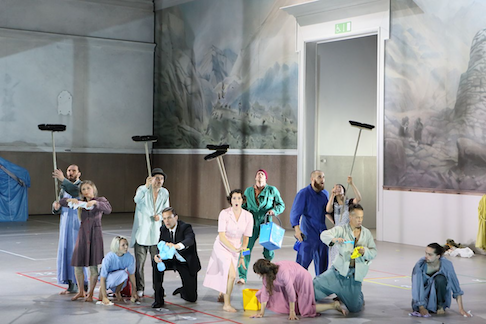 John Moore (Adario), Lisette Oropesa (Hébé/Zima), Tänzer der Compagnie Eastman, Antwerpen
John Moore (Adario), Lisette Oropesa (Hébé/Zima), Tänzer der Compagnie Eastman, Antwerpen
There are good reasons that so many of these stagings found themselves so artistically conflicted. The most powerful choreographic trends of the period, particularly in the Francophone nations of Europe, were indifferent to or actively hostile toward the old values of grace and musicality in dance: rough, spasmodic, angular, abstract movement was all but compulsory for a dance-maker to be considered serious and important.
Anybody who has come to love the dance-operas of Lully, Charpentier, and Rameau can also recall the embarrassment, anger, and boredom occasioned by stagings in which dance and music and drama were, if not in open war, at most grudging and awkward collaborators.
And the same lovers of this repertory can recall moments when suddenly the warfare ceased: when all the elements melted together and if only for a little while, released the intoxicating perfume of this art at its most elevated.
It is fitting that M. Cherkaoui hails from the anti-beauty heartland of modern dance. His work in Les indes galantes embraces every dance fashion and trend of the last 40 years and harmonizes them because he’s not thinking about them but about the ever-passing moment of the music. His movement exalts the human figure, celebrates human interaction, energizes the stage picture from back wall to apron, wing to wing, flies to floor.
M. Cherkaoui’s approach to librettist Louis Fuzilier’s string of loosly-connected illustrations of true love in exotic climes is to melt them together, retaining the amorous spirit but making the individual tales of pasha and slave-girl, Inca prince and temple-maiden etc. fragments floating on a continuous spate of images.
The setting is a drably furnished école élémentaire: uniformed students in their battered desks, informative maps and charts on the wall, hard-working teachers and staff going about the pedestrian essentials of creating new citizens for France.
And that is the only moment is the show that might be called pedestrian. Rameau’s music blows through this space, suggesting and supporting a flickering series of visions of a world in flux, peoples displaced, cultures in conflict. The overall effect is to portray a universal struggle for stability, safety, repose. And at every moment the tone is set by Rameau. The movement seems only the inevitable consequence: the touchstone of great choreography in any age.
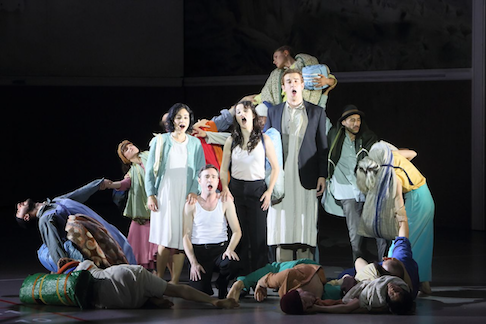 Ana Quintans (L’Amour/Zaire), Cyril Auvity (Valère), Anna Prohaska (Phani/Fatime), Tareq Nazmi (Osman/Ali), Tänzer der Compagnie Eastman, Antwerpen
Ana Quintans (L’Amour/Zaire), Cyril Auvity (Valère), Anna Prohaska (Phani/Fatime), Tareq Nazmi (Osman/Ali), Tänzer der Compagnie Eastman, Antwerpen
The use of contemporary popular dance forms is not new in this repertory: José Montalvo’s 2004 staging of Rameau’s Les paladins for the Châtelet was non-stop hip-hop, visually dazzling but utterly failing to provide anything but dazzle.
The difference from the Munich Indes galantes could not be more striking. Cherkaoui has found a movement synthesis which moves: the dazzle is just a delightful extra. What seems at first a high-handed way with the dramaturgy of the work proves to be the best way I have ever encountered in this repertory to break through to its enduring essence.
I believe that soon this exemplary staging—all hail the Bavarian State Opera for its courage and dedication in mounting it—will soon be seen as a milestone in the revival of French baroque theater on a par with the 1987 Atys of Jean-Marie Villégier and William Christie. One of the commonest tropes of Baroque dramaturgy is the ever-troubled alliance between the arts of music and dance (the first act of the Molière-Lully Bourgeois gentilhomme is the locus classicus). M. Cherkaoui appears like a god from the flies to join their hands once more after too long a divorce.
Roger Downey
Cast and production details:
Musikalische Leitung
Ivor
Bolton
Inszenierung und Choreographie Sidi
Larbi Cherkaoui
Bühne Anna
Viebrock
Kostüme Greta
Goiris
Licht Michael
Bauer
Dramaturgie Antonio
Cuenca , Miron
Hakenbeck
Chor Detlef
Bratschke
Hébé Lisette
Oropesa
Bellone Goran
Jurić
L'Amour Ana
Quintans
Osman Tareq
Nazmi
Emilie Elsa
Benoit
Valère Cyril
Auvity
Huascar François
Lis
Phani Anna
Prohaska
Don Carlos Mathias
Vidal
Tacmas Cyril
Auvity
Ali Tareq
Nazmi
Zaire Ana
Quintans
Fatime Anna
Prohaska
Damon Mathias
Vidal
Don Alvaro François
Lis
Zima Lisette
Oropesa
Adario John
Moore
Tänzerinnen Jennifer
White ,
Niku Navala Chaudhari,Acacia
Schachte,Ema
Yuasa, Nicola
Leahey
Tänzer Elias
Lazaridis ,
Kazutomi “Tsuki” Kozuki,Shintaro
Oue,Patrick
Williams "Twoface" Seebacher,Denis
Kooné,James
Vu Anh Pham, Jason
Kittelberger
Tänzer der Compagnie Eastman, Antwerpen
Balthasar-Neumann-Chor, Freiburg
Münchner Festspielorchester
Photos courtesy of Bayerische Staatsoper
July 26, 2016
Il barbiere di Siviglia, Glyndebourne Festival Opera at the Proms
Annabel Arden's production, designed by Joanna Parker, was adapted by Sinead O'Neill. Enrique Mazzola conducted the London Philharmonic Orchestra, placed to the rear of the stage, with Danielle de Niese as Rosina, Alessandro Corbelli as Dr Bartolo, Taylor Stayton as Count Almaviva, Björn Bürger as Figaro, Christophoros Stamboglis as Don Basilio, Janis Kelly as Berta, Huw Montague Rendall as Fiorello and Adam Marsden as an Officer, plus the men of the Glyndebourne Chorus.
I have not seen Annabel Arden's production at Glyndebourne, but Sinead O'Neill had successfully created a vibrant and all-encompassing staging (there was little that was semi- about it) which involved both the orchestra and conductor. The evening was full of laugh out loud moments which seemed to fill the Royal Albert Hall (no mean feat with a comedy designed for a far smaller space).
The problem was that Arden seemed to have taken her cue from the staging of the Act One finale. In most productions I have seen, this is given in a highly stylised and choreographed manner. It was no different here, Arden (and director of movement Toby Sedgwick) created an almost hyper-active physical commentary on the music, creating a very funny ensemble. But Arden transferred this style to the whole opera, each solo and each ensemble was highly choreographed and the whole evening became a long sequence of physical theatre. The addition of three actors to the cast (Tommy Luther, Maxime Nourissat and Jofre Caraben van der Meer) emphasised this as the three were rarely absent from the stage, either as carnival figures in the opening and closing scenes or as three extra servants in Doctor Bartolo's house
I have great admiration for the performers because all concerned brought off the conception superbly, combining fine musicianship with brilliant theatre. The problem for me was that somewhere along the line, Rossini's sense of character seemed to disappear. One of the reasons why the opera has remained so popular is that Rossini manages to combine a sense of fun with a real feeling of drama so that the comedy and the music arise out of the situation. By the end of the opera I was no clearer who these characters really were. For all Taylor Stayton's charm in performance, without a feeling of dramatic context we had little idea who the Count really was.
To take a couple of examples. In the Act One where the Count first encounters Figaro (a scene culminating in the duet 'All'idea di quel metallo') we received no sense of the social hierarchy, that Figaro had once worked for the Count. Instead Björn Bürger and Taylor Stayton interacted as equals. And in the climactic Act Two trio when Figaro and the Count climb up the ladder into Rosina's room in order to rescue her, Rossini sends up opera seria convention so that the Count and Rosina have a classically structured duet complete with the necessary repeats, whilst Figaro must wait impatiently on the sidelines hurrying them up and sending up their music. Here all three performers were highly physical and we had no sense of the two worlds meeting.
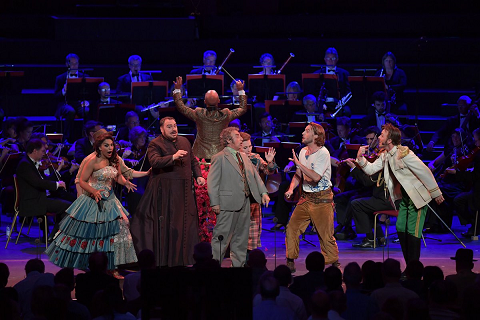 Danielle de Niese (Rosina), Christophoros Stamboglis (Don Basilio), Alessandro Corbelli (Dr Bartolo), Björn Bürger (Figaro) and Taylor Stayton (Count Almaviva). Photo credit: Chris Christodoulou.
Danielle de Niese (Rosina), Christophoros Stamboglis (Don Basilio), Alessandro Corbelli (Dr Bartolo), Björn Bürger (Figaro) and Taylor Stayton (Count Almaviva). Photo credit: Chris Christodoulou.
For all its use of Alberto Zedda's critical edition, and the presence of a forte piano in the continuo, this was a rather traditional version of the opera. The Count did not get his final aria, alas, and Rosina was sung by a soprano (rather than mezzo-soprano) complete with the alternative aria 'Ma forse, ahimè' in Act Two.
Changing Rosina from mezzo-soprano to soprano usually means the character moves from rich-voiced spitfire to pert charm. Danielle de Niese successfully re-made the role in her own image, using her lustrous eyes to great expressive effect and emphasising both Rosina's great personal charm and her physical attraction. De Niese also seems to have got first go at the dressing up box, with a series of striking costumes. Overall, I felt that Danielle de Niese's Rosina was perhaps a little too pleased with herself and we could have done with more of the spitfire. 'Una voce poco fa' was sung with confident style though the aria sat a little low in De Niese's voice and could have done with an upward transposition. As it was, on the repeat her ornamentation pushed the tessitura up significantly. De Niese has a great sense of style in this music, but her execution of the fioriture was a little uneven. Sometimes she produced passages of pin-sharp coloratura such as the duet with Björn Bürger's Figaro, but too often her delivery was rather vaguer in outline and lacked the sense of precise detail which was ideal in the role. 'Ma forse, ahimè' which was written by Rossini for a soprano and which prizes line over coloratura, De Niese really showed what she can do.
Taylor Stayton made a highly personable Count Almaviva, combining physical charms with a strong technique. His opening aria 'Ecco, ridente in cielo' demonstrated a slim-line tenor which he used elegantly, with a superbly confident sense of style in the ornamentation. My only real complaint was that we could have done with a greater variety of colour. Stayton showed himself capable of lyric beauty too in the Count's second serenade. He had a nice sense of comic timing in the disguise scenes, and in the Act Two trio with De Niese and Björn Bürger, Stayton and De Niese really made the Count and Rosina's duet sparkle, adding some rather steamy action.
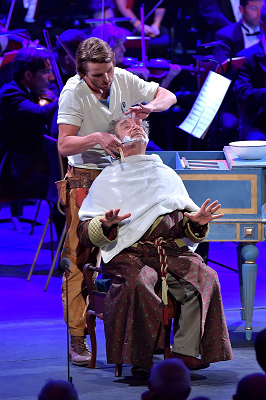 Björn Bürger as Figaro and Alessandro Corbelli as Dr Bartolo. Photo credit: Chris Christodoulou.
Björn Bürger as Figaro and Alessandro Corbelli as Dr Bartolo. Photo credit: Chris Christodoulou.
Björn Bürger was a name that was new to me; he is a young German baritone and is a member of the ensemble at Opera Frankfurt. He has an attractive, narrow-bore baritone which he used with great bravura and a lovely ease at the top of the range. His 'Largo as factotum' combined musical elan with a great sense of character, as well as being very funny. Bürger confidently combined a highly physical performance with a musically appealing one. This was a Figaro who seemed easily in control, yet Bürger's Figaro was also a delight to listen to.
Alessandro Corbelli is a veteran as Doctor Bartolo, and his combination of comic timing and musical felicity was effortless. He had the audience in the palm of his hand whenever he was on stage, yet there was no pulling of focus, this was very much an ensemble performance. Perhaps his performance was a little more one-sided than usual, thanks to the highly physical nature of the production, this was a Doctor Bartolo who was very funny throughout, and there was less of the sense of feeling sorry for the old fool that can happen in some performances. But there was so much to delight, whether it was the over-done charm in the arietta 'Quando mi sei vicina' or his lovely way with the recitative.
Christophoros Stamboglis was somewhat disappointing as Don Basilio. His tuning was not ideal in his calumny aria, but then transferring from Glyndebourne Opera House to the Royal Albert Hall with minimal rehearsal cannot be easy. He made Don Basilio delightfully pompous, and though 'La calunnia' was also somewhat effortful, he brought the piece to a great climax.
Janis Kelly was rather luxury casting as Berta, and she made her single aria into a wonderfully show-stopping number. Huw Montague Rendall and Adam Marsden (both from the Glyndebourne Chorus) contributed strong performances as Fiorello and the Officer.
This was very much an ensemble production, and the cast's sense of communal timing and great physicality made it a lovely piece of theatre. The recitative was done very vividly, though sometimes I would have liked a greater feeling of pace. The continuo from Alessandro Amoretti and Pei-Jee Ng was supportive without drawing attention to itself.
Enrique Mazzola and the London Philharmonic Orchestra gave a suavely characterful account of the overture, though it was not the most comically pointed of performances. Here and elsewhere Mazzola seemed to rather like a lot of percussion (mainly drum) in the mix. Throughout the evening the balance was not ideal and though the orchestra was behind the singers, there were too many moments when the balance favoured the orchestra.
The high musical values of the production make it well worth seeking out on BBC iPlayer (where it will be around for 30 days), but in the theatre the over-busyness of the production became a little too much and I felt rather self-defeating. In the end though, I had to admire the entire cast for their energy and commitment, and the superb way they combined the physical with the musical.
Robert Hugill
Rossini: Il barbiere di SivigliaRosina: Danielle de Niese, Dr Bartolo: Alessandro Corbelli, Count Almvaviva: Taylor Stayton, Figaro: Björn Bürger, Don Basilio: Christophoros Stamboglis, Berta: Janis Kelly, Fiorello: Huw Montague Rendall, Office: Adam Marsden, actors: Tommy Luther, Maxime Nourissat, Jofre Caraben van der Meer, original director: Annabel Arden, conductor: Enrique Mazzola, designer: Joanna Parker, stage director: Sinead O’Neill, London Philharmonic Orchestra, Glyndebourne Chorus.
Glyndebourne Festival Opera at the BBC Proms at the Royal Albert Hall, London; 25 July 2016.
image=http://www.operatoday.com/Danielle%20Niese%20Figaro%20Glyndebourne%20Prom.png image_description=Il barbiere di Siviglia, Glyndebourne Festival Opera at the Proms product=yes product_title=Il barbiere di Siviglia, Glyndebourne Festival Opera at the Proms product_by=A review by Robert Hugill product_id=Above: Danielle de Niese as RosinaPhoto credit: Chris Christodoulou
July 25, 2016
Béatrice and Bénédict at Glyndebourne
Laurent Pelly’s new production for Glyndebourne is certainly capricious: updated to a vague and varying period during the first half of the 20th century, the costumes embrace Edwardian elegance, ’40s Dior ‘new look’ radicalism, and de Gaullian militarism. But, Pelly’s surreal, monochrome hinterland, constructed of wedding-gift boxes - a sort of posh ‘cardboard city’ - from which characters emerge like jacks-in-the-box, offers none of the golden warmth of Shakespeare’s Sicily.
Instead, we have a ‘Fifty (at least) Shades of Grey’ palette worthy of a Farrow & Ball marketing catalogue. At the opening, when the Chorus burst from two large boxes and fling forth a joyful sicilienne to celebrate the arrival of peace, even their vigorously flapping Tricolores are tint-less, deprived of their revolutionary colour symbolism. Arriving at the wedding ceremony which concludes the opera, the guests look as if they’ve been dragged down a Dickensian chimney-stack.
Colour, as Pelly explains, ‘emerges from the music’, but his design and concept betray no awareness of the Sicilian balminess that is built into the score by way of the distinctive orchestration and native dance rhythms. There is no bitterness in Berlioz’s opera but Pelly gives us a storm-cloud back-drop which offers no intimation that the apparently imminent tempest will give way to the clear blue skies of nuptial bliss. Visually, this production presents not a ‘merry war’ but mirthless gloom.
Pelly imagines the bickering protagonists as ‘two rebellious people who refuse to fit into a mould and live in a “box”’, and the characters as ‘puppets’ within a ‘slightly unreal social ritual’. But, how are we to believe in these characters? The romantic dilemmas and dramas, conflicts and conciliations, of Beatrices and Benedicks have been box-office sure-fire hits since Shakespeare created his originals precisely because we can empathise with their emotional upheavals and appeasements.
Pelly puts all his eggs in one basket - or, dare I say it, box. The Glyndebourne Chorus - in wonderful voice - clamber in and out of these boxes, which Pelly conceives as containers of, and conduits to, conformity and domesticity. But more direction is needed for an opera which has hardly any plot - even though its spoken dialogue is drawn directly from Shakespeare - and the arias of which are largely static. The incessant re-arranging of the towers of teetering boxes assumes the choreographic complexity of a shipping dock in a busy freight port, but the human interplay gets lost in the carousel of cartons and chests.
In this opera, so much depends upon Béatrice, and how she is dramatically conceived: fortunately, Stéphanie d’Oustrac (last year’s Carmen) blends Gallic hauteur with elegance of wit and attire, and possesses a mezzo which can explode fierily, brood portentously and float contemplatively.
She made her mark dramatically in Act 1, but it was not until her Act II aria, ‘Il m’en souvient’, in which Béatrice recognises the nature and extent of her hitherto repressed feelings, that the range of d’Oustrac’s vocal expression was fully exhibited: tenderness sat side-by-side with strength, though the sound was never forced; there was diversity of colour and an impressive sense of the long line of Berlioz’s phrases. As the armour protecting her heart was pierced by Cupid’s stubborn arrow, d’Oustrac conveyed Béatrice’s real sense of fear: where will the release of repressed sentiments lead her? When the truth revealed itself, the shocked Béatrice grabbed a chair to defend herself from the alarming emotional onslaught - a melodramatic gesture which was at once comical, charming and touching. Then, as the off-stage wedding hymn wafted dreamily, d’Oustrac was a portrait of contemplative serenity as graceful supernumeraries balletically removed the detritus of the incompetent music-master Somarone’s feast in a beguiling silent charade around the seated dreamer. Yet, Béatrice’s impetuosity was as much a part of her submission as of her opposition: she recklessly dashed off a signature on the wedding contract which tied her in matrimonial subservience, embracing love as impulsively as she had resisted the amorous dart.
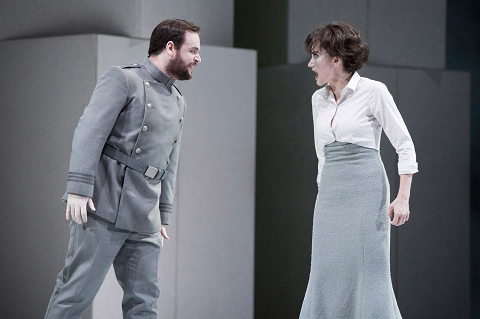 Paul Appleby as Bénédict and Stéphanie d’Outrac as Béatrice. Photo credit: Richard Hubert Smith.
Paul Appleby as Bénédict and Stéphanie d’Outrac as Béatrice. Photo credit: Richard Hubert Smith.
As Bénédict, American tenor Paul Appleby just about held his own in the face of d’Oustrac’s dramatic intensity, parrying her acerbic verbal thrusts with pointedness, if not much clout in Act 1. At times he seemed under-directed: Bénédict lurked unresponsively when he overheard his buddies speaking of Béatrice’s love for him. But, if Appleby demonstrated little sense of French style, his tenor is sweet-toned, ardent and flexible, and he offered masculine arrogance a-plenty. Bénédict’s exuberant aria, ‘Ah! je vais l’aimer,’ was vigorous and clear. Unfortunately, in Act 1 the skirmishes between the sceptical pair lacked an enervating frisson, though there were some piquant touches, as when, ordered to leave by her contra-amour, Béatrice stomped off in the opposite direction. But, as the proportion of music to spoken dialogue increased in Act 2, the rapport between the warring lovers became more absorbing, and the final Scherzo-Duetti, ‘Oui, pour aujourd’hui la trêve est signée; Nous redeviendrons ennemis demain’ (Yes, for today a truce is signed, We’ll become enemies again tomorrow) was delightfully sparky.
Sophie Karthäuser, replacing Hélène Guilmette, took a while to settle into the role of Héro, and didn’t capture the excitement or splendour of her Act 1 aria ‘Je vais le voir, je vais le voir!’ But, the end-of-act moonlit serenade, ‘Nuit paisible et sereine!’, in which she was partnered by Katarina Bradić's dulcet Ursule, was exquisite. I was torn between admiring Pelly’s coup de théâtre, as the two excited girls drew back the walls of yet another box to reveal a Dior wedding gown bathed in golden light - some colour at last to counter the pitch-black sky and glaring pendant globes of ‘star-light’ - and regretting that the visual spectacle distracted, and detracted, from the poignant mingling of pain and pleasure in Héro’s heart as she contemplates the bitter-sweetness of true love.
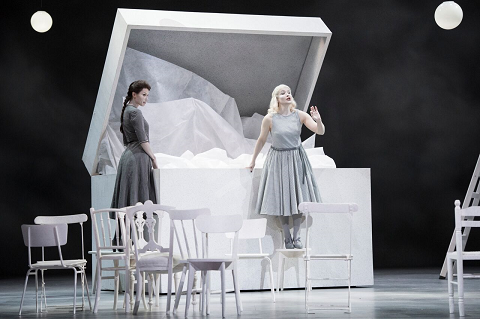 Katarina Bradić as Ursule and Sophie Karthäuser as Héro. Photo credit: Richard Hubert Smith.
Katarina Bradić as Ursule and Sophie Karthäuser as Héro. Photo credit: Richard Hubert Smith.
Berlioz replaces Shakespeare’s Dogberry with the asinine music-master Somarone, and the latter’s involvement in the wedding plans is perhaps better integrated into the action than the Master of the Watch’s malapropisms and mishaps. Lionel Lhote was a portrait of puffed-up, pedantic mediocrity, and his exhibitionism injected some much needed levity, if at times it strayed into farce - Somarone’s drinking song, ‘Le vin de Syracuse, Accuse, Une grande chaleur’, ended with a perfectly-timed exit atop the banqueting table, narrowly avoiding decapitation. As Lhote conducted his grotesque epithalamium with pompous self-absorption, flinging out furious commands at the orchestra and urging his singers to ‘milk the ecstasy’, the musical jokes reminded us of the artifice of the plot.
Philippe Sly has little to do as Claudio - except provide Héro with her sole topic of conversation - but his warm baritone made a strong contribution to the Act 1 trio, and Frédéric Caton was an authoritative Don Pedro. As Léonato, Georges Bigot was characteristic of all the cast in delivering the French text idiomatically.
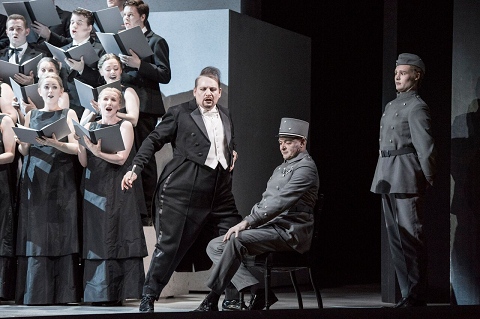 Lionel Lhote (Somarone), Frédéric Caton (Don Pedro) and Philippe Sly (Claudio). Photo credit: Richard Hubert Smith.
Lionel Lhote (Somarone), Frédéric Caton (Don Pedro) and Philippe Sly (Claudio). Photo credit: Richard Hubert Smith.
Replacing Robin Ticciati (who is recovering from back surgery), Antonello Manacorda made an auspicious Glyndebourne début in the pit. The overture didn’t quite tease and delight as it should, but once things got going he revealed a sure sense of the nuance and detail of Berlioz’s gossamer score.
Berlioz concluded that the opera shows us that ‘madness is better than stupidity’. Béatrice’s conversion is inspired not, as in Shakespeare’s play, by Bénédict’s defence of Héro’s honour and virtue but by Love - ‘a torch, a flame, a will o’the wisp, coming from no one knows where, gleaming then vanishing from sight, to the distraction of our souls’. Perhaps Pelly’s surrealism does capture this sense of strangeness, but while the singing offers much joy, visually this defeat of romantic scepticism is a melancholy affair.
Claire Seymour
Béatrice et Bénédict continues until 27th August: http://www.glyndebourne.com/tickets-and-whats-on/events/2016/beatrice-et-benedict/
The performance on 9th August will be screened in cinemas and online: http://www.glyndebourne.com/tickets-and-whats-on/events/2016/watch-beatrice-et-benedict/
Hector Berlioz: Béatrice et Bénédict
Béatrice - Stéphanie d’Oustrac, Bénédict - Paul Appleby, Héro - Sophie Karthäuser (23, 27, 30 July; 3, 5, 9 August; Anne-Catherine Gillet will sing Héro on 12, 15, 19, 22, 25, 27 August), Claudio - Philippe Sly, Somarone - Lionel Lhote, Don Pedro - Frédéric Caton, Ursule - Katarina Bradić; Director - Laurent Pelly, Conductor - Antonello Manacorda, Set Designer - Barbara de Limburg, Costume Designer - Laurent Pelly, Lighting Designer - Duane Schuler, Dialogue adapted by Agathe Mélinand, London Philharmonic Orchestra, The Glyndebourne Chorus.
Glyndebourne Festival Opera, Saturday 23 July 2016.
image= http://www.operatoday.com/BandB1.png
image_description=Béatrice and Bénédict, Glyndebourne
product=yes
product_title=Béatrice and Bénédict, Glyndebourne
product_by=A review by Claire Seymour
product_id=Above: Stéphanie d’Oustrac as Béatrice
Photo credit: Richard Hubert Smith.
July 24, 2016
Der fliegende Holländer, Bavarian State Opera
Although the Bavarian State Opera eschewed Wagner’s Tristan-esque revision - rightly, in my view, that working better for Tannhäuser than The Flying Dutchman - this was not Götterdämmerung. Moreover, the end, as we experienced it, came more as silence and alienation than a whimper; close, then, but probably not quite the same. More important still, in retrospect - hindsight was inescapable on this particular occasion - the real catastrophe, or rather news of it, came after the end of the performance, the ‘real world’, as is far too often the case at the moment, offering the keenest of tragedy. So perhaps I should start again; I shall not, however, since I should like to start at the end, indeed feel compelled to do so, lest tales of Mrs Lincoln and her critique of the evening’s dramatic proceedings hover too close for comfort. For this was an evening - thank God - never to be repeated, one that even the most ambitious of stage directors would have struggled to envisage, let alone to create. Without in any sense wishing to minimise Peter Konwitschny’s achievement in this typically arresting, provocative, yet ultimately deeply, if not unrelievedly, sympathetic production, only Karlheinz Stockhausen, and before him Richard Wagner himself, might have come anywhere near this - and even then, not so very near.
The music stopped, then, just before the final bars; the lights fell. Silence fell too, the singers looking uneasily at each other: splendidly acted, I remember thinking. Then, following that caesura - inevitable memories of Konwitschny’s celebrated Meistersinger, even for those of us who only heard tell - we heard the final bars, albeit from what sounded like a distant, wind-up gramphone. I even wondered whether it might have been Konwitschny père’s recording, rendered more ancient, not that that matters. Redemption, then, was undercut not only by Wagner’s Tristan-less ending. (I am skating over the more complex issues of earlier versions, but that is not really the point here.) It was ironised - few directors manage to ironise Wagner successfully; Konwitschny does - by hearing it as something we all knew, all expected, were more or less hearing in our heads anyway, and yet then did not hear as we should. It was a little like King Marke’s appearance in Die Meistersinger: meaningful, consequential, a modernist rather than a post-modernist quotation.
Then we spilled out onto the Max-Joseph-Platz, quite unaware of Munich’s terrorist lockdown. My telephone had no reception; I could not contact a friend, to see whether he had been there or not. (It later transpired that he had not.) Many of my fellow opera-leavers seemed puzzled. We could not, for instance, enter a restaurant on the other side of the square; although a few people in there were eating, the doors were locked. Whilst trying to find out what was going on, I eventually received a call from my father, to check that I was safe; he began to explain, and armed police came into view. I learned after that those who were less quick on their feet than I had been were unable to leave the Nationaltheater for quite some time. I, however, had little choice but to try to walk back to where I was staying, armed police and other advisors pointing me and others first in one direction, then in another, often seeming to disagree with each other. Meanwhile, so far as I was aware - this was not the case, but it was what everyone seemed to think at the time - the U-Bahn was closed, since one of several gunmen (there was, of course, only one) had gone down there, armed. Walking past Odeonsplatz station was a little frightening, then; but it was the eeriness of the evacuated beer festival in the square - when I had walked to the opera, it had been full of beer, music, Dirndls, Lederhosen - that, if anything, chilled more. Having spoken to my brother too, I made it back to my host’s, who filled me in on events unfolded and unfolding - and immediately poured me a much-needed drink.
I learned much later that what I ‘should’ have seen and heard - Barry Millington had sent me his review of the production, but I had not read it at the time - was Senta, clearly furious with the Dutchman for not having trusted enough, setting one of the quayside barrels ablaze and mount her own act of terror. The explosion I ‘should’ have heard - unlike Wagner’s music, I did not know it - never came; darkness and alienation, nevertheless curiously, chillingly effective, did. No wonder so many onstage ‘acted’ confused; they had not, it seems, been acting at all. Presumably many had suspected a technical problem. The Bavarian State Opera had, it seems, decided to pull the explosion. For those in the know, was this perhaps a bit like ‘hearing’ Mahler’s missing third hammer-blow in the Sixth Symphony? (Thank goodness this was not a Mahler evening: that really would have been too much.) And so, the business of interpreting, reinterpreting, a particularised version of Konwitschny’s staging - never, let us hope, to be repeated - truly got under way; or at least it did in the odd couple of seconds between replying to anxious Facebook and Twitter messages from friends. (Why, they wondered, had I not replied? Most of them had no idea, of course, that I had been in the theatre for nearly two-and-a-half hours, without an interval.) I shall never forget the non-bang and the gramophone whimper, nor the further step our wretched world made towards Götterdämmerung.
Let me turn, though, to what I had seen and heard before. My memory and my experience are doubtless coloured by the ‘other’ events of that night. Nevertheless, what I saw and heard was impressive indeed, on its own terms. Our friends at Against Modern Opera Productions - how chilling it was to see, that very night, them railing, as if Hitler had never fallen, against ‘degenerate’ artists - might even have liked, had they not seen the word ‘Konwitschny’, the realistic designs from Johannes Leiacker, with which the mise-en-scène opens. For it is a (German) Romantic, even Gothic landscape that provides the backdrop. Apart from anything else, this is a ghost story: every one of us, every society, is overwhelmed by ghosts from our pasts. So too, of course, is opera. Nevertheless, ships are definitely ships; the sea and sky are definitely the sea and sky. The Dutchman’s crew, moreover, are most definitely Golden Age Dutchmen. The painterliness is, in one sense at least, ironic. AMOP would not have ‘got’ that; representations and their deconstruction would have gone unnoticed, uncomprehended. They would surely, though, have noticed the heightened venality not only of Daland, but his crew too (modern Norwegians, but as yet, not with an overwhelming Wagnerian clash between ghostly visitors and the ‘present’). Daland’s pockets of a few golden chains; the Steersman crowns himself with a golden crown; the other lads eagerly join in the bonanza: there is much jewellery to be had from the new ship’s Cardillac-like cargo, unless, as one of Wagner’s less-eagerly acknowledged forebears might have advised him, ‘L’or est une chimère’. A chimera of another variety haunts the Dutchman: the Angel in white who visits the stage. This Dutchman is a man, with sexual fantasies of his own; they distract him, pave the way for tragedy; they lead us to the second act.
Our opera-as-Pegida acquaintances would certainly have started screaming degeneracy, at the deliberate scenic contrast when the curtain rose upon that act. This is a swish health club, in which the wheels that spin are those on the exercise bicycles. Mary leads the class, the girls engaged in the uneasy camaraderie and rivalry of the mindless heteronormative pursuit for an ‘ideal’ physical form to please ‘the’ men they have either hooked or would like to hook. (Or is it the other way round?) Spinning, one might say, takes more than one guise: old visiting new, new visiting old; connections abound. Senta does not fit in; she arrives late for the class, and is far more interested in her Romantic painting. Erik is a creepy yet impatient voyeur: no mere innocent he. Yet it is Senta’s disruptive presence, encouraged by the reappearing Angel, that ultimately, prophetically, proves the turning point. It sets in process the Brechtian - house lights on - lecture to the audience she and the Dutchman give at the close of the act. ‘Romantic love? Yeah, right…’ Everything, then, is set up to fail, as it increasingly does during the third act, modernity and caricatured Old Dutchmen engaging in violent combat, the past, as it so often is, victorious - not least because the present refuses to learn from it. And then - well, you have heard the rest. Explosion there comes - on this occasion, came there not.
The cast was distinguished. Catherine Naglestad trod to powerful, even searing effect the line between, on the one hand, twin incitement to Verfremdung and terror, and on the other, heartfelt, Romantic or neo-Romantic ‘feminine’ suffering. Her top notes - and not just her top notes - thrilled; we were reminded that the female redemption problematized by Konwitschny, by us more generally, is, not only in Wagner but in so much opera, often effected through vocal presence. Johan Reuter traced this complex Dutchman’s mood swings with great skill; we sympathised with, even followed, his distractions and his demons. Matti Salminen’s final Daland - so, at any rate, I was informed - was a bluff yet knowing performance, a fine tribute to a great artist. Wookyung Kim came close to stealing the show with his sensitively sung, far-from-pushover Erik. Okka von der Damerau imparted dramatic as well as ‘merely’ musical meaning to the role of Mary, and Dean Power proved as appealing and as intriguing a Steersman as I can recall having heard. Choral singing was wonderfully full-blooded too. All, then, engaged with Wagner’s work as living drama.
The Bavarian State Orchestra was, unsurprisingly, in its element here. Its playing encompassed all manner of shades from darkest, grimmest of musical tragedy to echoes of Mendelssohn and Weber, apparently - if only apparently - more blithe, even fairy-like. This was orchestral Wagner as outstanding as one might hear from Daniel Barenboim’s Staatskapelle Berlin. Asher Fisch might have benefited from a more Barenboim-like sense of the work’s melos ; or at least he would have done for me, my preference being very much for a more ‘musico-dramatic’, less ‘number-opera’ approach to the work. The latter is, of course, perfectly justifiable in theory, but it tends, unless more strongly incorporated into a sense of an unbroken whole, to make parts of the work drag - especially when, as here, numbers such as Senta’s Ballad, are taken so slowly. Fisch undoubtedly knew what he was doing, though; he had me, on more than one occasion, rethink, rehear. The waltzing at the end of the first act - perfectly in keeping with fantasies venal and sexual, visually as well as musically realised - pointed far into the musico-dramatic future, to Strauss as well as to the integrative tendencies of later Wagner. The Flying Dutchman is in some ways the most difficult Wagner drama of all to bring off musically; no one would have been seriously disappointed, if at all, by this performance.
The rest was silence; until, that is, it became the noise of chaos.
Mark Berry
Cast and production details:
Daland: Matti Salminen; Senta: Catherine Nagelstad; Erik: Wookyung Kim; Mary: Okka von der Damerau; Steersman: Dean Power; Dutchman: Johan Reuter. Director: Peter Konwitschny; Deisgns: Johannes Leiacker; Lighting: Michael Bauer; Dramaturgy: Werner Hintze; Chorus and Extra Chorus of the Bavarian State Opera (chorus master: Søren Eckhoff)/Bavarian State Orchestra/Asher Fisch (conductor). Nationaltheater, Munich, Friday 22 July 2016.
image=http://www.operatoday.com/RichardWagner.png image_description=Der fliegende Holländer, Bavarian State Opera product=yes product_title=Der fliegende Holländer, Bavarian State Opera product_by=A review by Mark BerryJuly 21, 2016
Evergreen Baby in Colorado
The piece premiered here of course, so there is significant resonance to experiencing it anew in such an invigorating, immensely moving realization. The company covered itself in glory starting with the casting of the title role.
Anna Christy is born to play Baby Doe. Diminutive and appealing, blessed with a limpid, silvery soprano, the role seems to have been tailored to her significant gifts. While she can certainly easily encompass the spunk and grit of the determined heroine, where Ms. Christy uniquely excels is in the incredible legato flights above the staff.
It is not often one encounters such total ease of vocal production, seamless phrasing, and alluring timbre. She also thoroughly understands the full range of emotions in Baby’s journey, and she communicates them with an honest simplicity. I have often marveled at Anna Christy’s achievements in the past, but with this role assumption she is at the height of her powers, an utterly perfect marriage of artist and material.
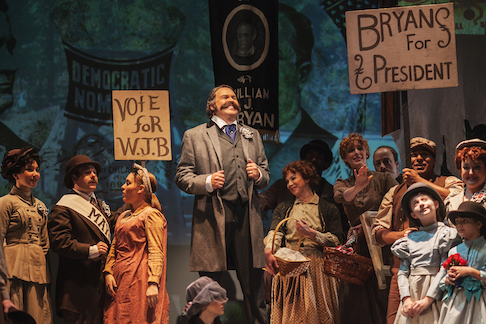 Grant Youngblood as Horace Tabor
Grant Youngblood as Horace Tabor
As the object of her affection, Grant Youngblood, too, was a splendidly apt choice for Horace W. Tabor. His physical stature and self-assured bearing were matched by a dependable, rich baritone of considerable import. Mr. Youngblood perfectly balanced the public swagger of the successful businessman-politician with the pathos of his personal longings and shortcomings.
His version of Warm as the Autumn Light was luxurious in its outpouring of burnished tone. As he ultimately descended inexorably into a state of drunken despair, he infused his voice with such pathos and anguish that no one could have been unmoved. The final pages of the score with his compelling, unaffected enactment of Tabor’s death, followed by Ms. Christy’s crsytalline performance of Always Through the Changing were unbearably moving. There can’t have been a dry eye in the house.
As the third part of the story’s love/power triangle, Susanne Mentzer emphatically held her own as the determined, staunch, till-death-do-us-part wife Augusta Tabor. To her great credit, Ms. Mentzer finds every cranny of nuance in an often unsympathetic personage. She wisely invests the role with as much dignity as outrage, balancing the overt self-righteousness with an abiding sense of loss.
She is an attractive woman, her handsome bearing able to suggest severity as well as noble suffering. She has an incisive, throbbing mezzo-soprano, and her technique is rock solid, reveling in a freely ringing top and upper middle, while wisely negotiating lower passages with savvy dramatic flair. Ms. Mentzer also excels portraying the character’s physical deterioration, dramatically and vocally. When she appears as her youthful self in Horace’s final hallucination, she is stunningly renewed: sassy and fresh-voiced.
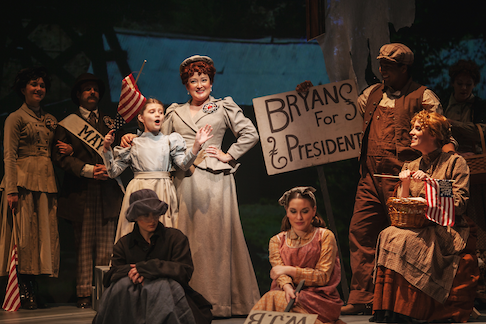 Bryan for President (Anna Christy and ensemble)
Bryan for President (Anna Christy and ensemble)
The featured character William Jennings Bryan was served up with gusto by bass-baritone Donald Hartmann. His characterful, sonorous singing boomed out in the house and his take-no-prisoners campaign persona was the riveting focal point of his scene, as was required. As Baby Doe’s near harridan of a mother, Sarah Barber dominated her scenes with potent stage presence and a highly-charged, brilliantly aggressive vocal delivery of penetrating power.
The large cast of featured roles was so uniformly excellent, it seems a shame not to have space to single all of them out for praise. These dynamic cameos were mostly peopled by the outstanding corps of Apprentice Artists, and the entire laudable cast list is enclosed for your perusal. Moreover, Chorus Master Aaron Breid has molded these talented artists into a precise and finely-honed ensemble.
Conductor Timothy Myers seemed to be having a ball in the pit, and his skillful orchestra responded with a reading that was by turns heady, colorful, atmospheric, driving, introspective and sweetly sentimental. Maestro Myers wrung every bit of variety from this popular score, managing a perfect combination of folksy Americana and profound operatic expression.
If this is not the year that Central City Opera discovered the possibilities of scenic projections, then mark it as the year they perfected them. Is there a show with as many different locations as this one? (Gypsy, maybe?) The over-achieving David Martin Jacques devised a truly wondrous design for sets, lighting and projections juggling all three duties with consummate skill. This achievement was so virtuosic that I suspect the talented Mr. Jacques could have done it all while still clanging a pair of cymbals between his knees like a consummate busker.
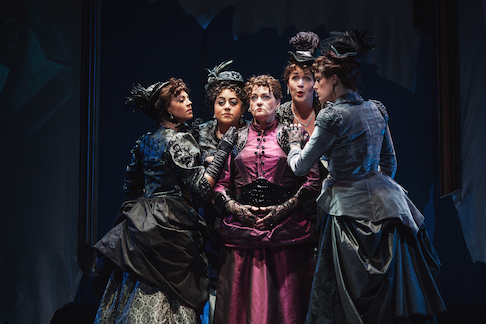 What Do You Intend to Do Augusta Tabor? (Susanne Mentzer)
What Do You Intend to Do Augusta Tabor? (Susanne Mentzer)
The scenery was largely scrim panels and painting frames that flew in and out in various combinations. These frames were stretched with ‘canvases’ that were also scrim, spookily ragged, trailing downward as the bottom crosspiece of the frames was missing. On these shifting surfaces were projected real images of the locations and personages of the story. Highly effective.
The few pieces of furniture were chosen with great care and specificity, and it did not hurt that the actors were clad in Sarah Jean Tosetti’s spot-on period costumes. The sweep of the story and the definition of the characters and their stations in life were inestimably aided by Ms. Tosetti’s fine work. The icing on the cake was a beautifully judged wig and make-up design from Liz Printz.
Ken Cazan’s loving and knowing direction was so effective as to almost not be noticeable. The movement was natural and made good use of the space. He brilliantly peopled the stage with inevitable pictures and well-motivated crowd control. Mr. Cazan seems to have created highly productive subtext with his performers since their relationships were so connected and meaningful.
He also had great skill crafting powerful images, none more so than when Augusta is firmly planted center stage, with her lady ‘friends’ buzzing around her with unwanted advice. That they appeared and disappeared from behind a quintet of scrim projections of Horace’s ‘portraits’ was even more powerful, and the complete stasis of the upright, uptight Augusta made the visual startlingly impactful.
I also very much liked having a mute Baby Doe ambling on stage at the beginnings of the acts and other selected times, all buttoned up and moving stiffly as the eccentric recluse she would become after Tabor’s death. Indeed, the show started with her older self, standing in the middle of a snowy ground cloth, soon pulled away as the opera started. At the opera’s close, the same austere cloth was drawn around the dying Horace, and his grieving wife. Touching and meaningful.
This enduring company seems to return to celebrate its ‘signature opera,’ The Ballad of Baby Doe, every ten years. Based on this year’s loving and beautifully rendered landmark production, I can’t wait for the 70th anniversary edition.
James Sohre
Cast and production details:
Old Silver Miner: Justin Berkowitz; Bouncer: Chad Sonka; Kate, Saloon Girl: Ashley Fabian; Meg, Saloon Girl: Tatiana Ogan; Horace W. Tabor: Grant Youngblood; Sam: John David Nevergall; Bushy: Daniel Ross; Barney: Leroy Y. Davis; Jacob: Samuel Hinkle; Augusta Tabor: Susanne Mentzer; Sarah: Danielle Palomares; Mary: Marlen Nahhas; Emily: Anna Laurenzo; Effie: Megan Case; Mrs. Elizabeth (Baby) Doe: Anna Christy; Samantha, a Maid: Micaëla Aldridge; Clarendon Hotel Clerk: Peter Lake; Albert, a Bellboy: Michael Floriano; Mama McCourt: Sarah Barber; Washington Dandies: Terence Chin-Loy; Nathan Ward, Christopher Kenney, Cody Müller; Father Chapelle: Peter Lake; Footman: Michael Floriano; President Chester A. Arthur: Justin Berkowitz; Elizabeth (child): Lucy Crile; Silver Dollar (child): Carly Crile; Mayor of Leadville: Justin Berkowitz; William Jennings Bryan: Donald Hartmann; Stage Doorman: Peter Lake; Denver Politician: Stephen Clark; Silver Dollar (adult): Kaileigh Riess; Conductor: Timothy Myers; Director: Ken Cazan; Set, Lighting and Projections Design: David Martin Jacques; Costume Design: Sarah Jean Tosetti; Wig and Make-up Design: Liz Printz; Chorus Master: Aaron Breid.
image=http://www.operatoday.com/2016%20CCO%20BOBD%20Baby%20Doe%27s%20Wedding%20%28Anna%20Christy%29%20Photo%20Amanda%20Tipton.png image_description=Anna Christy in the title role [Photo by Amanda Tipton] product=yes product_title=Evergreen Baby in Colorado product_by=A review by James Sohre product_id=Above: Anna Christy in the title rolePhotos by Amanda Tipton
July 20, 2016
Lean and Mean Tosca in Colorado
This seeming limitation instead proved a liberation for ingenious director Joachim Schamberger. The mutli-talent Herr Schamberger also designed the effective set and the non-stop, virtuosic projections. The unit set is intended to be an overall suggestion of a prison, a metaphor of how society in trapped in certain behaviors, and unable to break cycles of oppression.
As such, it consisted of a semicircle of latticed metal doors above which rose a prison ‘wall’ that served as a perfect receptacle for the combination of still image and film projections. These most often began as structurally accurate suggestions of the actual physical locations, then morphed into artwork of the period relative to the topic, and finally included some very telling psychological reflections.
When Scarpia lusts after Tosca as the parishioners intone the Te Deum, the video above the prayer services is of the imagined conquest of Tosca, wherein a chat room-like close up of the actual actress is languidly undoing her bodice as she projects inviting glances. This was the most profane juxtaposition I have ever seen of Scarpia’s morally bankrupt character balanced against sincere religious fervor.
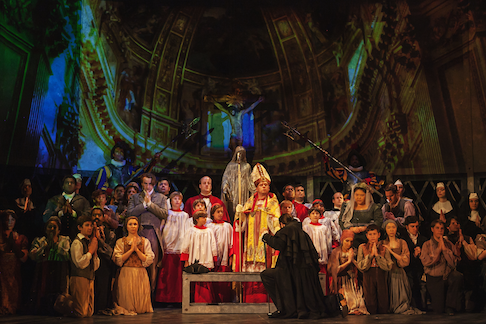 The Te Deum
The Te Deum
There were other startling images as well, such as blood running over cityscapes during Cavaradossi’s torture. But my favorite might have been the serenity of the imposing Castel Sant’Angelo, projected on the show scrim, which got invaded by a herd of sheep as the Shepherd was picked up in a spot behind the scrim jangling the bells he carried in his hand. What wonderful, telling imagery!
If this sounds highly stylized, it was. Another large part of the show’s success is the dynamic lighting design by David Martin Jacques. As expected, there were well-executed pools and areas of lighting, with good uses of color and textures. But Mr. Jacques also took some real chances: during moments of crisis and decision for major characters he punctuated them with schizophrenic bouncing of spots that were an apt comment on the emotional turmoil of the situation.
The final moments of the show were perfectly calibrated. On this flat floor, one level set, I was wondering how on earth Tosca was going to jump to her death. Well, Team Tosca had a stupendous effect in mind: Tosca parted the center walls floor to ceiling, revealing a white shaft of light, ran a few feet onto a short platform, turned and hurled her final phrase. . .and fell backwards into the abyss like Sigourney Weaver in Alien 3! A stunning surprise.
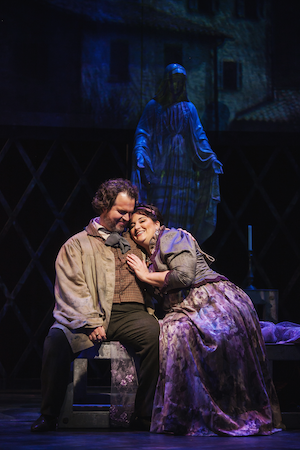 Jonathan Burton as Cavaradossi and Alexandra Loutsion as Tosca
Jonathan Burton as Cavaradossi and Alexandra Loutsion as Tosca
The costumes from Utah Opera looked handsome, and Tosca’s Act II gown, especially designed by Dana Tzvetkov was rich and effective, especially for its red, removable overlay, its flowing white under gown, and a diaphanous scarf. Set pieces were limited to multi-purpose, modular, industrial looking platforms, tables and chairs, a writing stand, and a white marble statue of the Virgin Mary.
I have to say, this was the funniest Tosca I have ever seen. You read that right. The director found willing participants with the Sacristan, Cavaradossi, and yes, even Tosca to create intentionally humorous interplay. I am not sure I liked it all, but I am not sure I didn’t. I can tell you that the premiere audience Ate. It. Up.
Perhaps, that initial humorous tone does not instill the usual nobility in the great tempestuous diva, nor does it presage the immense tragedies that are looming. The Sacristan suddenly kneeling to Scarpia with a pained ‘take,’ Mario playfully coming on to Tosca in their first duet, Tosca being restrained as she threatens to slash the l’Attavanti portrait (which she later does in fact do), all were played with comic sensibilities but also with commendable honesty. Would Floria and Mario actually start to get intimate on the floor of the chapel? Director Schamberger thinks so.
He does not shy away from the attempted rape in Act II, having Scarpia suggestively begin to disrobe as he defines Tosca’s prezzo. In the moments before Vissi d’arte, he actually forces himself atop her on the floor, tearing open the red over dress, leaving Tosca to begin the aria, flat on her back, legs tangled in her petticoats. Pretty intense stuff.
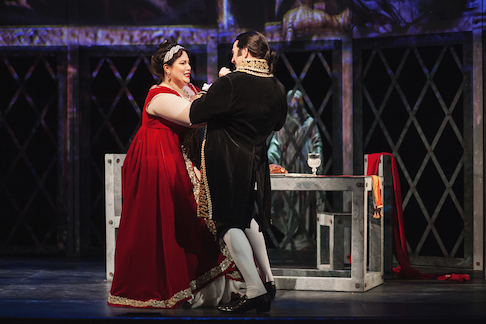 Alexandra Loutsion as Tosca and Michael Mayes as Scarpia
Alexandra Loutsion as Tosca and Michael Mayes as Scarpia
When Scarpia finally crosses down stage to have her, his white shirt open baring his handsome torso, she turns upstage and executes as fierce a stab as I have ever seen, jolting him into the air, before he sinks on bench to be slashed at again and again. Visceral excitement that is pure Puccininian ‘shock and awe.’
Not every idea lands. The Te Deum looked crowded with everyone center stage. And the show began in silence, with extras entering from the house to survey the stage and its pile of rubble. They decide to clean it up and reconfigure the elements to create the first scene. A woman sees a red scarf (Tosca’s) and picks it up, sending (Cavaradossi’s) paint brushes scattering from with it.
The first loud note then intones in the orchestra and they all run off in terror. This rubble turns out to have been the Act III set, and the red scarf was Tosca’s, that artistically fell from the fly loft after she jumped. The show ends with these contemporary extras coming back to the fringes of the action, looking confused. Who are these people? Tourists? Critics? The Puccini Police? Your guess is as good as mine. Or as good as the folks at the B and B where I stayed, who also were unable to suss it out over breakfast.
John Baril conducted a stylistically accurate, theatrically vivid account of this thrice-familiar score. The orchestra responded with real fire and commitment. The divisi celli were especially vibrant and pulsing with emotion. The clarinet solo work was impeccably haunting. Whether playing soli or tutti, Maestro Beril inspired these fine players to thrilling results. He did on occasion allow soloists to indulge in some held high notes that were long enough to give Corelli pause, but that is a minor consideration. His reading had veristic sweep as well as minute detail. Aaron Breid’s chorus was well-schooled and full throated.
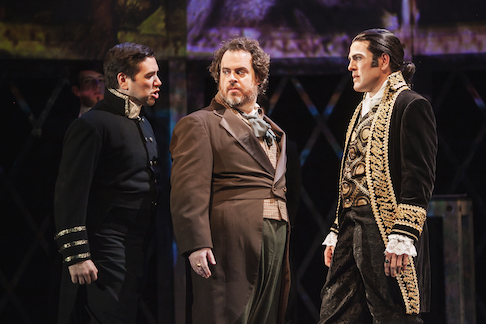 Peter Lake as Spoletto, Jonathan Burton as Cavaradossi, and Michael Mayes as Scarpia
Peter Lake as Spoletto, Jonathan Burton as Cavaradossi, and Michael Mayes as Scarpia
Alexandra Loutsion is making an auspicious role debut in the title role. She has a warm, round, plush sound, that has ample presence in all registers. Ms. Loutsion also has a secure, ringing high register that can ride the orchestra with impressive ease, but she can also scale back to regale us with meltingly beautiful sotto voce singing. Since there were some unorthodox elements to this character’s interpretation I will be interested to follow her development in the part. Although she is herself young, at the moment her vocal approach seems better served by the tortured, mature turns of events of Acts Two and Three, than the unusually coquettish girlishness of Act I.
I had greatly enjoyed tenor Jonathon Burton in last summer’s Fanciulla in Des Moines. Of course, Cavaradossi is a whole other kettle of fish, but Mr. Burton acquitted himself with distinction. He invests a great deal of meaning and emotional weight in his heartfelt singing. He certainly has all of the thrilling money notes, even though one or two lacked the ease of production that characterized his other vocalizing on this evening. It is when he sings in mezzo forte that he can grab your heart and not let go. O dolci mani was beautifully, winningly intoned.
Michael Mayes made an overwhelming impression in his debut as Baron Scarpia. His is a powerful, booming, dark baritone that has a searing presence. Mr. Mayes is also a highly imaginative singer capable of great diversity of effects. I have never experienced quite such a sinuous Va, Tosca, so laced with menace as he seemed to taste her name as he uttered it. He not only had the reserves for the Big Sell moments, but also could command a skillful legato. As a Las Vegan, I can paraphrase the Cosmopolitan’s promo when I say Mr. Mayes’ colossal Scarpia is just “the right amount of wrong.”
The thrilling, full-voiced sing of all three principals is laudable, applaudable, and admirable. I would only caution that sometimes, pressing volume for dramatic effect can invite strain or even errant pitch. When you strive to sing ‘balls-to-the-wall,’ well, in this theatre at least, the wall may be closer than you think!
Lanky Donald Hartmann was all gangly limbs and orotund delivery as he gave us a Sacristan that was all about the comedic core of the character. His was a well-rounded and thorough embodiment of the doddering meddler, although occasionally his histrionics stole focus. Stephen Clark’s stalwart baritone gave great urgency to a well-sung Angelotti. Peter Lake’s smooth, attractive baritone made us wish Puccini had given Sciarrone much more to sing. The fresh-scrubbed Adam Richardson lent his pleasing tenor to a sinister portrayal of Spoletta, and he made the most of his scenes. Ashley Fabian was the sweet-voiced, utterly natural sounding Shepherd.
James Sohre
Cast and production details:
Angelotti: Stephen Clark; Sacristan: Donald Hartmann; Mario Cavaradossi: Jonathon Burton; Floria Tosca: Alexandra Loutsion; Baron Scarpia: Michael Mayes; Spoletta: Peter Lake; Sciarrone: Adam Richardson; Shepherd: Ashley Fabian; Jailer: Eric McConnell; Condcuctor: John Baril; Director, Set and Projection Designer: Joachim Schamberger; Original Costume Design: Susan Memmott Allred; Costume Coordinator: Dana Tzvetkov; Lighting Designer: David Martin Jacques; Wig and Make-up Design: Liz Printz; Chorus Maste.
image=http://www.operatoday.com/2016%20Central%20City%20Opera%20TOSCA%20Baron%20Scarpia%20%28Michael%20Mayes%29%20Photo%20Amanda%20Tipton%2019.png image_description=Michael Mayes as Scarpia [Photo by Amanda Tipton] product=yes product_title=Lean and Mean Tosca in Colorado product_by=A review by James Sohre product_id=Above: Michael Mayes as ScarpiaPhotos by Amanda Tipton
Die Walküre, Baden-Baden
Eva-Maria Westbroek (Sieglinde), Evelyn Herlitzius (Brünnhilde), Ekaterina Gubanova (Fricka), René Pape (Wotan) and Mikhail Petrenko (Hunding) sung on a scorching summer sunday under the guidance of Valery Gergiev and his Mariinsky Orchestra. Every singer produced sensational showstoppers. With such a cast a production is better left away.
The magnificent tenor Andreas Schager charmed the disappointed audience expecting a sick Jonas Kaufmann. With a touch of theatrical flamboyance Schager includes the audience intimately in his performance. As a singer he gives each of his characters his all. I have seen him go at it as Tannhauser in Ghent, Max in Der Freischütz in Berlin, and he was a major high point in Leipzig’s Ring Cycle last May, where he blew up the stage as Siegmund. Schager has also tackled Tristan in St. Petersburg with Gergiev, this evening’s conductor. His debut at the Met in NY is already programmed for the near future.
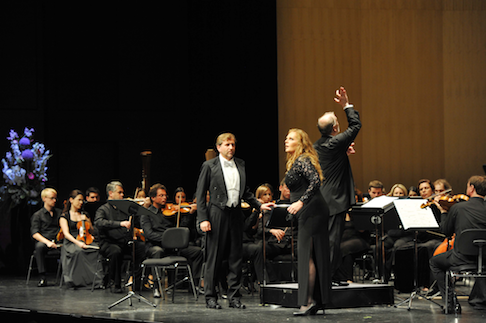 Andreas Schager and Eva-Maria Westbroek
Andreas Schager and Eva-Maria Westbroek
Tonight, he returned as Siegmund for the Festspielhaus Baden-Baden, who managed to steal him away from his rehearsals for Der fliegende Holländer in his debut at Bayreuth. He again convinced as the overconfident hero. His performances have the sense that it might be his last.
From the moment Schager arrived on stage, the Austrian Adonis turned on his charm and dazzled. He has a soulful voice and big personality always intent on seducing the audience. In Leipzig, the Gewandhaus Orchestra was located in the pit, so he did not have the challenge of overcoming orchestral volume, a challenge he overcame most of the time with Gergiev and the muscular intensity of his body-builder Mariinsky. The challenge of balancing the volume was one of the few things that could have been more refined. But that was in Gergiev’s hands.
Schager’s chemistry with Westbroek was extraordinary. They elevated their duet to more than the sum of its parts. Their subtle acting and minimal gestures added great drama to this first act. Add to that the rich strings, swooning in their romance, and you were truly swept away as a listener. Schager and Westbroek’s fiery, passion moved me to tears. Epic was the revelation of his true name as first Sieglinde and then her brother exclaimed “Siegmund!”. It sent shivers down my spine.
Ms. Westbroek displayed her captivating acting skills, presenting Sieglinde highly expressive with great emotional authenticity, including her rich, relentless vibrato. She infused her declaration of love for her brother with generous exuberance. Later she contrasted this mania as she exuded a fearful malaise before Siegmund’s confrontation with her husband Hunding. A complete natural, her entire performance seemed hardly difficult, adding an almost laidback quality to the performance. How does she do it?
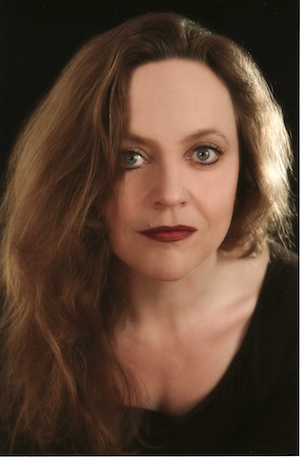 Evelyn Herlitzius
Evelyn Herlitzius
Mikhail Petrenko must be admired for his flawless diction in German. You couldn’t detect his Russian accent at any point during his portrayal of Hunding, full of disdain and anger.
In Act II, Ekaterina Gubanova stole the show as the elegantly puritan and utterly disgruntled Fricka. Her voice commanded the stage, and she put Wotan to shame, in the best of ways, as Pape held his own. The climax of Act II had five world class singers on stage, and made for one of the most star-struck moments in opera that I have experienced. And one subtle moment of if-looks-could-kill emerged as Fricka arrived and Brünnhilde’s cheer diminished. That slight moment of eye-contact expressed volumes.
René Pape formidably portrayed Wotan with a sad, almost hopeless, resignation, as a leader at the end of his rule. In his interaction with Fricka in Act II, he displayed an authoritarian vocal prowess, demanding respect, yet still deeply human, perhaps too much so as God.
In Act III, Brünnhilde’s eight sisters threw themselves into Wagner’s vocal acrobatics as Gergiev turned the first half into a fully blown adrenaline rollercoaster. Yet it was the interaction between Wotan and Brünnhilde that left me helplessly sobbing, as the father cast his favorite daughter out of Valhalla. Such devastation I have rarely experienced from a stage performance. And while Wotan remains a bit distant, Evangeline Herlitzius turned me into an instant fan. Her Brünnhilde convinced in her virtuous optimism, but also displayed great dread for Wotan’s retribution. The singers elevated the performance to mythic heights.
In Act II Evangelina Herlitzius gave hint of what was later to come. But in Act III with Wotan she switched with seeming ease from upbeat enthusiasm, to great despair and all without too much theatricality. Her interaction with her disappointed father turned out to be the heartbreaking, gut wrenching finale that was necessary to conclude such a superlative concert.
Gergiev brought out the exhilarating passages of Wagner’s score. Brass sounded consistently brilliant or subtle with finesse in their simmering, swampy passages. Gergiev sustained a suspenseful momentum. He built up the Wagner’s tension effectively and knew to release it at the right moments.
With air conditioning, comfortable seating and such a stunning cast and orchestra, the question becomes…do you really need to still go to Bayreuth? Probably, because with a cast like this, it will be a long time before I will hear another so superlatively sung Die Walküre.
David Pinedo
image=http://www.operatoday.com/Ekaterina_Gubanova.png image_description=Ekaterina Gubanova product=yes product_title=Die Walküre, Baden-Baden product_by=A review by David Pinedo product_id=Above: Ekaterina GubanovaDes Moines’ Elusive Manon
Full disclosure: I have seen more first tier productions of this piece with world class stars than perhaps any other opera. Every time the opening bars strike up, memories of Sills, or Netrebko, or Kabaivanska, or Swenson, or Malfitano, or Grigolo, or Villazon, or Kraus — my God, Kraus! — rush in. I have a deliriously happy history with this piece. As I settled in to my seat at DMMO, I resolved to let them make their own case for the redoubtable, delicate gem that is Massenet’s Manon.
It has to be said that Sydney Mancasola was luminous in the title role. She sports a secure, silvery soprano of enormous flexibility, wedded to an unfaltering musicality. There is a generous dash of humanity in her portrayal and she is possessed of a charismatic presence in her well-rounded assumption of a richly complex personality. Ms. Mancasola is completely believable as the young girl, in fact she is perhaps too giggly. It is as the developing adult that she confronts some limitations of vocal heft and coloring. She is not yet able to fully convey the womanly, seasoned maturity of the later scenes. But she is young, she is extremely gifted, and she will only grow.
As her lover Des Grieux, Joseph Dennis has the right sized tenor and he sings extraordinarily beautifully, especially at mezzo forte. When he presses the top and covers the tone, Mr. Dennis muscles up just a bit although he does get wholly acceptable pointed forte notes out. His lyrical, introspective Act II aria found him at his best, offering his most meticulously controlled singing all night. This is such a daunting role, and if Joseph has not quite yet mastered all the tricky gearshifts between voix-mixte and full throttle that this part demands, he nonetheless made a substantial impression.
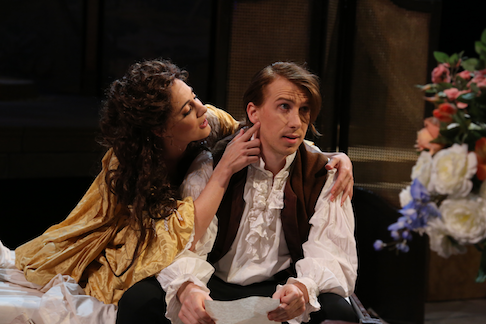 Sydney Mancasola and Joseph Dennis
Sydney Mancasola and Joseph Dennis
Michael Adams as Lescaut sported a naturally warm and engaging baritone, but he too, slightly covers so that when he goes up the voice has a tendency to fall back instead of pinging forward. Mr. Adams certainly cuts a handsome figure, although he mugged pretty shamelessly in Act II, and he seemed to really enjoy playing with his cascading hair. Maybe he was a little “too” much of a dandy to be as likable as he should/could be.
The securely sung trio of women, Pousette (Ashly Neumann), Javotte (Emma Sorenson) and Rosette (Antonia Botti-Lodovico) blended well and complemented each other beautifully. Troy Cook lavished De Bretigny with an exceptionally fine, suavely produced baritone that was cultivated, unctuous and persuasive. His acting was suitably unapologetic about winning Manon by all means necessary. As Guillot de Morfontaine, Brian Frutiger’s impersonation started out a somewhat annoying caricature, but then found some chilling malicious honesty in the gambling scene. As Comte des Grieux, seasoned pro Julien Robbins contributed a richly sung portrayal, his meddling paternal phrases poised on a cushion of mellifluous bass sound.
The accomplished conductor David Neely had a somewhat flat night in the pit. The opening statements were dry and correct, instead of sparkling and anticipatory. This rather clinical beginning thwarted stylistic engagement for a couple of acts but then began to settle into a more enthused, informed, expansive French style.
There is much about Manon that starts out heady and bubbling, but ultimately it is a rather gentle tragedy as things go, certainly not Offenbach’s La Grande Duchesse de Gerolstein. The broad generalities of the first fourth of the evening did not set-up (as they must) the powerful set pieces and confrontations in the following acts.
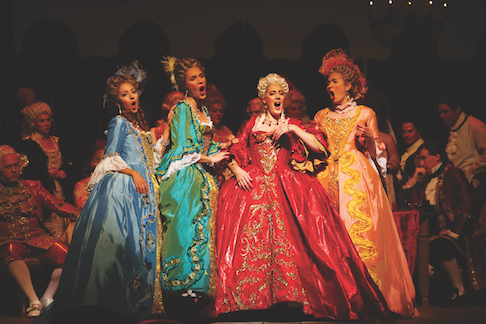 (Left to right) Antonia Botti-Lodovico, Ashly Neumann, Sydney Mancasola and Emma Sorenson
(Left to right) Antonia Botti-Lodovico, Ashly Neumann, Sydney Mancasola and Emma Sorenson
Director Kristine McIntyre’s blocking was often excellent, always competent, but sometimes just too darn’ clean as when the chorus sits down almost en masse in the Cours la Reine scene. Or, too vague as in the very opening when we can’t quite assess who is who, or what is where. The wonderfully detailed business of the lovers cavorting on the bed was preceded by an odd separation of the would-be lovers as they sing about going to run away together, all the while remaining resolutely apart.
Manon and Des Grieux are directed to do mostly all of the right things and Ms. McIntyre’s business has been very well thought out and conscientiously executed. But curiously, for all of Ms. Mansacola’s and Mr. Dennis’s strengths and hard work, for all of their going through very uninhibited romantic motions, no true sparks are ever really struck, just suggested.
I am a firm admirer of set designer R. Keith Brumley’s skills, but they seemed a bit muted on this occasion. The angled rows of painted screens were professionally executed, and the rotating of the panels allowed for swift changes. But they were oddly sterile considering the sumptuousness of the period and lushness of the score.
Indeed, in the beginning, it was difficult to define the space, and to know where the referenced elements were supposed to be imagined. The addition of drape panels in Act II were airy and diaphanous when it seemed that the lovers should be trapped in a garret or down at heel apartment. Thereafter, Mr. Brumley scored with some wonderful effects, never less so than with the beautiful grill and gate for St. Sulpice which provided a very effective environment.
Barry Steele’s lighting design was another curiosity. This gifted illuminator provided an uncharacteristically blunt design, with lighting cues mostly abrupt and lacking atmospheric specificity. This was obviously a choice, but arguably not often a well-considered one. One excellent effect was having white votive lights placed on the stage’s perimeters for the Cours la Reine scene, and then having them cross fade to blood red for the passions of St. Sulpice, augment by red hanging votives.
Conversely, Roger Kirk’s lavish, character-specific costumes were just what the piece required, and were the most wholly successful design element. I wondered if Manon’s loud, sequined gold Cours la Reine gown might have been just a bit on the gaudy side, but, hey, she does dominate the scene. Never you mind, Mr. Kirk provided wholly splendid attire.
Eh bien, mes amis, at the end of la nuit, this was a commendable convocation of top talent and good intentions. Manon was a concerted and admirably conscientious effort. It just ultimately seemed to be not quite the right one.
James Sohre
Cast and production details:
Manon Lescaut: Sydney Mancasola; Pousette: Ashly Neumann; Javotte: Emma Sorenson; Rosette: Antonia Botti-Lodovico; Chevalier des Grieux: Joseph Dennis; Comte des Grieux: Julien Robbins; Lescaut: Michael Adams; Guillot de Morfontaine: Brian Frutiger; de Bretigny: Troy Cook; Innkeeper: Spencer Reichman; Guardsmen: Lee Steiner, Nathaniel Mattingly; Maid: Aurelie Veruni; Sacristan: Chris Carr; Sergeant: Christian Sanders; Street Performers: Deborah Giddings, Steve Giddings, Rebecca Mauritz; Conductor: David Neely; Director: Kristine McIntyre; Set Design: R. Keith Brumley; Lighting Design: Barry Steele; Costume Design: Roger Kirk; Make-up and Hair Design: Brittany Crinson for Elsen and Associates; Chorus Master: Lisa Hasson.
image=http://www.operatoday.com/3X3A8494.png image_description=Sydney Mancasola and Joseph Dennis [Photo courtesy of DMMO] product=yes product_title=Des Moines’ Elusive Manon product_by=A review by James Sohre product_id=Above: Sydney Mancasola and Joseph DennisPhotos courtesy of DMMO
Falstaff in Iowa: A Big Fat Hit
Arguably the greatest asset of the performance was David Neely’s sure handed, fleet-footed, scherzo-like approach to the master’s final stage work. Maestro Neely drew extraordinary playing from his instrumentalist, and they reveled in every sparkling orchestral effect. Not to imply there was anything frivolous about his approach, for Mr. Neely also finds weightiness when required, lending even more pomposity to Va, vecchio John, more gravity to Ford’s tortured aria, and more sheen and shimmer to Nanetta’s forest arietta. Has that famous orchestral trill ever had more sparkle and fizz, that closing fugue more impetus and insouciance? Thanks, Maestro, for buoying our spirits and ravishing our ears.
It didn’t hurt his efforts to have a formidable cast on his team. Wayne Tigges, in a role debut, is already a tremendous Falstaff in every way. His imposing physicality houses a big, pointed voice that rang out in the house as he blustered, boasted, and bellowed with ample reserves of power. That said, Mr Tigges was also capable of a highly polished characterization that found nooks and crannies and nuances that he was able to convey with conviction and subtley. Indeed, his might just have been the most richly detailed Falstaff of my experience, summoning real pathos in his poignant Act III aria. Occasionally, his no holds barred approach may have caused the voice to rasp, and a few times some pauses and pacing may not have exactly been Verdi’s, but he is destined to become a much sought after Sir John.
As Ford, Edwards Parks revealed himself to be a fine Verdian indeed, and boy do we need him now. His secure technique and imposing, warm delivery were marked by good squillo and excellent legato. His delivery of E sogno was musically potent and dramatically rich. Mr. Parks also managed to find some variety in this tight-ass role, interacting playfully with his wife at selected instances. As said wife Alice Ford, the always winning, effortlessly beautiful Kelly Kaduce scored yet another success. Ms. Kaduce’s acting and especially, her comic sense are without peer on the operatic stage (as Beverly Sills might say: “Lucille Ball with high notes”). At the performance I saw, her upper voice began a little fuzzy in focus, but she soon warmed to her task finding the appealing, silvery glint I remember as the show went on.
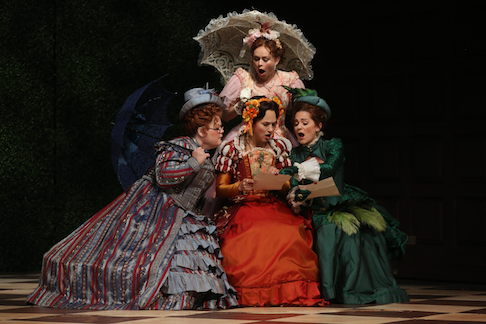 Seated: Maria Zifchak, Kelly Kaduce, Megan Marino. Standing: Deanna Breiwick.
Seated: Maria Zifchak, Kelly Kaduce, Megan Marino. Standing: Deanna Breiwick.
She was well paired with another youthful “merry wife,” Megan Marino as Mrs. Meg Page. Ms. Marino is a real company asset, her luxuriant mezzo and energetic participation for once made Meg an important and equal co-conspirator, not just a requisite space filler. I can’t tell you how often I have seen this role under-cast or under-performed, so it was a real pleasure to experience Ms. Marino’s solid achievement.
Maria Zifchak was a wonderful Mistress Quickly, with a wholly fresh take. Hers was not the chest-voiced, barrel-toned force of nature sometimes presented by mezzos “of a certain age.” No, Miss Zifchak prefers to be sexy and sassy over bossy and booming. Her poised, controlled, sinuous singing was in perfect service to a well-considered characterization that she served up with obvious relish.
Deanna Breiwick’s Nannetta represents a dream match-up of role and voice. Not since the great Benita Valente have I heard such melting singing in the part. Ms. Breiwick’s finely spun upper register was floated with utmost skill and effortless beauty. As Fenton, young Jack Swanson also has a pure, warm, lyric instrument, which he wisely does not try to push beyond its limit. His sweet vocalizing was somewhat at odds with Fenton’s urelenting horndog behavior, but we will get to that.
Both Bardolfo (Ryan Connelly) and Pistola (Matthew Scollin) were absolutely committed and over-the-top. Mr. Connelly is an imaginative and playful comprimario on the rise, and Mr. Scollin has a pointed bass-baritone used with solid conviction. Dr. Caius finds a worthy interpreter in Chris Carr, although he alone seemed trapped in a stereotypical, doddering physicality.
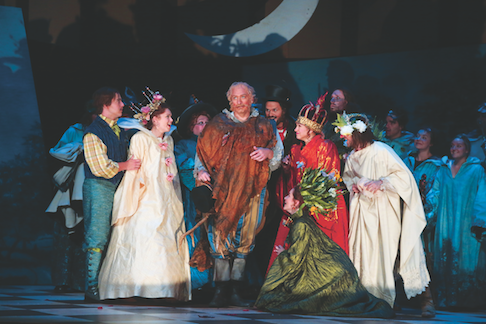 Jack Swanson, Deanna Breiwick, Maria Zifchak, Wayne Tigges, Edward Parks, Kelly Kaduce, Matthew Scollin, Ryan Connelly
Jack Swanson, Deanna Breiwick, Maria Zifchak, Wayne Tigges, Edward Parks, Kelly Kaduce, Matthew Scollin, Ryan Connelly
Director Tomer Zvulun achieved much to admire and the responsive audience clearly appreciated his efforts. I found the staging quite apt, often clever, and unusually carnal. And why not? The whole tale hinges on pursuit of love-making, and fears of wives being seduced into infidelity. If this overt physicality interestingly informs the older personages in the show, I found that by also imposing that on Fenton and Nanetta, their randiness deprived the show of its balancing sweetness.
Too, there were a few (but only a few) instances of lilies getting gilded. Or jokes being given away too soon. It is far funnier if we don’t get tipped off that Caius is inadvertently marrying Bardolfo. It also strained credulity that Ford and Caius mercilessly batted, pushed and bullied Fenton. These brief distractions were offset by moments of real brilliance like the chase scene in pursuit of Falstaff as he is caught mid-faux-seduction. The bustling stage was a riot of beautifully controlled movement. And the entrance of the fairies through the audience was a splendid effect.
Erhard Rom’s set design provides the piece with a handsome and atmospheric playing space, as adaptable as Shakespeare’s Globe Theatre. Two heavy, dark, oak-paneled walls flank the stage, able to close in or angle out as needed to create the interior of the inn (with addition of furniture), the exterior (with addition of the “Garter Inn” shingle), the Ford household (with emphasis on the upstage window) or the forest (with addition of three huge cockeyed oil paintings of stylized trees). I loved the placement of the double sided portrait that got changed out with Sir John on one side and Verdi on the other side. After the fat night is unceremoniously dumped in the river, a trashed version shows up in Act III. And the Advent calendar reveals of compartmentalized plotters was a delectable touch.
Mr. Rom also used a Fantastick’s-like act curtain on which was copied the title page of Verdi’s vocal score for Falstaff. This proved a clever touch and allowed the show to start with a silhouette of a backlit Fenton and Nanetta kissing, only to have them scatter when the curtain reveals them by dropping to the floor. Lighting designer Barry Steele repeated this effect perfectly timed when the two are caught kissing in the script. Throughout the evening, Mr. Steele deployed effective and subtle lighting shifts and made excellent use of tight specials, with the fairyland greatly enhanced by the starry lights. Vita Tsykun’s handsome, well-tailored, often highly colorful costumes seemed to belong to Maestro Verdi’s era rather than having the usual Elizabethan look. Nonetheless, they were lovely to look at, and defined the social strata of the participants. Sir John’s outlandish visiting costume was alone worth the price of admission.
This great opera reveals new delights and greater depth with each encounter, and Team Falstaff is to be commended for breathing yet more fresh air into this enduring masterwork.
James Sohre
Cast and production details:
Dr. Caius: Chris Carr; Sir John Falstaff: Wayne Tigges; Bardolfo: Ryan Connelly; Pistola: Matthew Scollin; Mrs. Alice Ford: Kelly Kaduce; Mrs. Meg Page: Megan Marino; Mistress Quickly: Maria Zifchak; Nannetta: Deanna Breiwick; Fenton: Jack Swanson; Ford: Edward Parks; Host at the Garter: Gretchen Krupp; Robin: Cameron Bennington; Conductor: David Neely; Director: Tomer Zvulun; Set Design: Erhard Rom; Costume Design: Vita Tzykun; Lighting Design: Barry Steele; Make-up and Hair Design: Brittany Crinson for Elsen and Associates; Scenery and Costumes created for the Wolftrap Opera Company; Chorus Master: Lisa Hasson.
image=http://www.operatoday.com/3X3A1964.png image_description=Wayne Tigges as Falstaff [Photo courtesy of DMMO] product=yes product_title=Falstaff in Iowa: A Big Fat Hit product_by=A review by James Sohre product_id=Above: Wayne Tigges as FalstaffPhotos courtesy of DMMO
Die Fledermaus, Opera Holland Park
Opera Holland Park have given us three smashing productions so far this season (Iris;La bohème;La Cenerentola) and this new production of Strauss’s champagne-fuelled Die Fledermaus, directed by Martin Lloyd-Evans, fizzes along like a glass of bubbly.
Lloyd-Evans pulls off the trick of balancing tongue-in-cheek farce with dramatic credibility. Rather than the inanities of a Carry-On caper, this show presents a romp with the wit and sparkle of an Ayckbourn farce enjoyed in a seaside theatre in mid-summer.
It’s true that there’s little of the ‘darkness’ which casts a subtle shadow over Strauss’s escapist fantasy. And, for those who remember Christopher Alden’s 2013 ENO production, which buried the fun beneath Freudian symbolism and envisaged the protagonists as psychiatric case-studies, that might be a good thing. But, there’s little sense of Viennese nostalgia either. Strauss may have recreated the debonair congeniality of aristocratic life in fin-de-siècle Vienna, but the world he presents was resting on a precipice: the ‘fall’ to come was swift and deep, and the operetta spares neither working-class ambition nor the apathy, frivolity and superciliousness of the Viennese elite in a time of economic and political uncertainty. Alfred’s seductive plaint to Rosalinde, ‘Happy are those who forget that which cannot be changed’, might be seen as a comment on bourgeois attitudes following the stock-market crash of 1873.
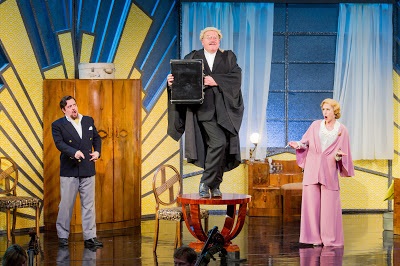 Act 1: Ben Johnston (Eisenstein), Robert Burt (Dr Blind), Susanna Hurrell (Rosalinde)
Act 1: Ben Johnston (Eisenstein), Robert Burt (Dr Blind), Susanna Hurrell (Rosalinde)
What we have instead is stunningly lit (Howard Hudson) Art Deco decadence. Designer takis replaces the curves of Art Nouveau with the angles of Art Deco, and in Act 1 uses elegant glass and metal screens to partition the stage, thereby creating the Eisensteins’ intimate but uncluttered boudoir and bathroom. With the extant walls of the Elizabethan Holland House visible in the background, the effect was the blend of medieval royal palace and cutting-edge modernity that one finds at Eltham Palace, the colour-schemes of which takis’ palette recalled. The design was economical too. The screens were swivelled to expose the Holland House portico and entrance steps, and a pyramid of champagne coupes, a trio of round gold pedestals, heaps of sumptuous pillows, and a sprinkle of some topless male waiters, bunny-girls and cross-dressing revellers transported us from private chamber to public ballroom. Prince Orlofsky’s palace was an ironic meeting-place of burlesque and Kubrick’s Eyes Wide Shut.
The Opera Holland Park Chorus were once again superb in this Act 2 ball scene, the vocal precision and vitality even more impressive as Adam Scown’s slick, detailed choreography kept them busy. They were naturalistic as party-goers and showman-like as whirling dancers. They were permitted a brief rest during the ballet sequence in which burlesque dancer Didi Derriere (yes, really) tickled their fancies with a beguiling ostrich-feather fan display.
After the carousing highs of Act 2, the final act always struggles to maintain momentum and a distinct hang-over pall descended in Act 3, as the glittering screens and colours faded to leave us in grey prison, sparsely adorned with desk and filing cabinets. Ingeniously, though, we were afforded a glimpse into the cells where the merrymakers slept off the excesses of the night: stage-right, a square-patterned frame which had lurked in the distance all evening, inconspicuously according with the general design, was now brought the fore and populated with inebriate-strewn mattresses.
Lloyd-Evans’ slapstick requires nimbleness and good comic timing from his cast, and they oblige. Prison governor Frank - sporting a Clousseau mac - can’t enter a room without tripping over the doorstep and ends up asleep with his head in a bucket; horse-play with cuff-links and overcoats repeatedly leaves the characters tied in knots. Alfred’s attempt to infiltrate his beloved’s bedchamber via a ladder is thwarted, time and time again, by a slamming of the window: what could have been hackneyed instead became the delightful fulfilment of expectation - was it my imagination, or was there a slightly longer, playfully teasing, delay before each successive crash? The ‘off-kilter choreography’ of the four Keystone Cops who accompany Frank to arrest Eisenstein is charming - as is the bashful smile of the fourth, and somewhat tardy, diminutive copper. Their bobbing and baton routines, their over-swift departure and sheepish return, last just long enough to tickle without irritating. And, it takes a lot of practice to get the sequences that ‘wrong’.
The farce is aided by Alistair Beaton’s rhyme-wielding translation. The verbal gags are engagingly modern but in keeping with the spirit of the original. And who could fail to be impressed by the blustering Dr Blind’s neologistic invention: ‘magnifying’, ‘modifying’, ‘ratifying’, ‘verifying’, ‘speechifying’, ‘simplifying’, classifying’, ‘disqualifying’ […] ‘alibi-ing’! The spoken dialogue came across well, the Eisenstein’s RP contrasting with Falke’s Irish brogue. Adele’s neat switch between Home Counties and northern working-class exemplified her social aspirations and get-up-and-go.
Indeed, as Jennifer France perched in Eisenstein’s bathroom excitedly poring over the invitation from her sister, Ida, to attend the Prince’s ball, it was clear that this was a chambermaid who knew her own mind and was going places. France negotiated the bravura coloratura with ease and the Act 2 ‘Mein Herr Marquis’ was a dramatic and musical delight: unceremoniously spun and dumped into a pile of cushions, Ben Johnson’s Eisenstein was no match for this sassy lass.
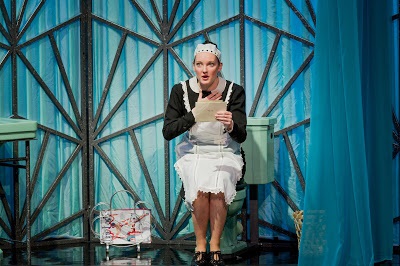 Jennifer France (Adele)
Jennifer France (Adele)
Johnson and Susanna Hurrell were a good comic duo in Act 1 and the Act 2 seduction-duet was fun, as Hurrell taunted her frustrated, belittled husband with his pocket-watch. Johnson has an elegant voice, but it is quite light, though nimble and warm; I’d have liked a bit more authority - after all he is the ‘master’ of the house - but he stamped his presence more forcefully when convincingly disguised as Dr Blind. Hurrell’s Rosalinde was glamorous in a rose-pink pyjama suit and exotic in a fabulous green-and-gold get-up as the Hungarian princess. This was a winning impersonation, full of disingenuous wile. Her voice is expressive and the tone beautiful, though at times I’d have liked a fuller sound: the final note of ‘Klänge der Heimat’ was a bit snatched - which was disappointing following such a charismatic rendition, though the tempo felt a bit ponderous.
Peter Davoren’s Alfred had a nice golden sound and despite his unintelligible Italian accent - his text is peppered with Italian - he successfully avoided the ‘Italian tenor’ stereotype. Alfred can be a bit wearing, but Davoren was more puppyish than preening; his willingness to suffer and spare his lover’s blushes won our sympathy, all the more so when he appeared from the cells in Act 3, trussed like a chicken, reduced to hopping feebly about in disorientated bewilderment.
Gavan Ring was excellent as a suave Falke, his baritone supple and smooth. Falke’s ‘Brüderlein, Brüderlein und Schwesterlein’ can be played quite hauntingly, but here his paean to brotherhood was so persuasive that the partyers instantly stripped to their underwear, fulfilling Falke’s observation that ‘pairs have formed, that many hearts in love are bound’ - as the macho waiters deftly swept up the discarded fineries.
I enjoyed Samantha Price’s Orlofsky: her mezzo is vibrant and assured, and she was the perfect party host - hospitable and indefatigable. Joanna Marie Skillett was a characterful Ida and as Dr Blind Robert Burt bluffed and puffed through his unmusical monotones.
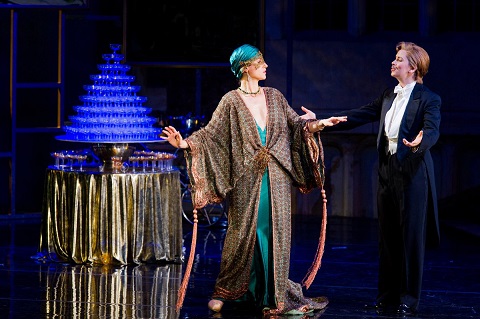 Susanna Hurrell (Rosalinde) and Samantha Price (Prince Orlofsky)
Susanna Hurrell (Rosalinde) and Samantha Price (Prince Orlofsky)
Ian Jervis was a curmudgeonly Frosch whose Act Three monologue spiked several Conservative MPs - Brexiteers, Remainer and Regrexiteers alike - prompting some belly laughs in the prison gloom.
Guiding the show, conductor John Rigby exhibited a no-nonsense approach borne of his experience in musical theatre, and the shirt-sleeved City of London Sinfonia served him well. Rigby’s West End credits include The King and I and Sinatra at the London Palladium, Marguerite at the Theatre Royal, Haymarket, Les Misérables at the Palace Theatre, The Phantom of the Opera at Her Majesty’s Theatre, and The Producers at the Theatre Royal, Drury Lane; and this was a wise conducting appointment for the score danced to a tight beat, while the woodwind players were allowed some slack for their expressive rubatos. The overture took off like a shot and the momentum did not flag - though I felt some empathy for the second fiddles and violas whose right elbows must have been drooping by the end of the sweltering evening - all that oom-cha-cha waltzing! Perhaps some of the orchestral details and tonal variety didn’t come across - more might have been made of the orchestration of the Czardas, all flutes, clarinets, and tambourines, which so differs from the prevailing string-dominated idiom - but the Straussian spirit was heeded.
Die Fledermaus is essentially an ensemble piece with the emphasis on dramatic interplay as much as on vocal sparkle. Here, the waltzes swirled, the corks popped and the pleasure-seekers rocked, as Lloyd-Jones and his team raised their glasses to this Dom Perignon of operettas.
Claire Seymour
Johann Strauss II: Die Fledermaus
Gabriel von Eisenstein - Ben Johnson, Rosalinde - Susanna Hurrell, Adele - Jennifer France, Ida - Joanna Marie Skillett; Alfred - Peter Davoren, Falke - Gavan Ring, Dr Blind - Robert Burt, Frank -John Lofthouse, Prince Orlofsky - Samantha Price, Frosch - Ian Jervis; Director - Martin Lloyd-Evans, Conductor - John Rigby, Designer - takis, Lighting Designer - Howard Hudson, Choreographer - Adam Scown, Chorus Master - Harry Ogg, City of London Sinfonia, Chorus of Opera Holland Park.
Opera Holland Park, Kensington, London; Tuesday 19th July 2016.
image=http://www.operatoday.com/Champagne.jpg image_description=Die Fledermaus, Opera Holland Park product=yes product_title=Die Fledermaus, Opera Holland Park product_by=A review by Claire Seymour product_id=Above: The champagne ariaNice, July 14, and then . . .
On July 15 the Arcanto Quartet, artists-in-residence at the Aix Festival, opened its program with the first and second four voiced fugues of the 14 fugues of the Art of the Fugue, the second fugue delighting in the dotted rhythms of French Baroque dance. This opening sequence of fugues concluded with the ninth fugue, a lively, double subject exercise rendered even more complex by invertible counterpoint.
In exquisite straight tone the four voices of the quartet fought elegantly for attention, converging finally and almost incidentally in the first fugue, then converging staunchly in the third fugue, these four consummate players in absolute control of the the most mature of fugal machinations.
The program continued with the 18 year-old Mendelssohn’s first string quartet that the composer prefaced "Is it true that you wait for me in the arbor by the vineyard wall?" The structures of this late-Beethoven inspired work dissolved into youthful sonic atmospheres of seasons, of light and shadow and plumbed the mysteries of nature and its magical forces in a myriad of colors and textures, the four voices of the quartet now one in infinite gestures of sentient sounds.
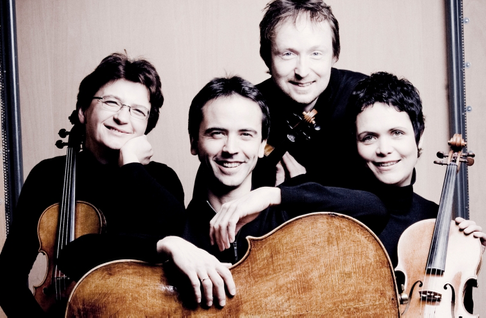 The Arcanto Quartet
The Arcanto Quartet
The program concluded with Alban Berg’s Lyric Suite. The quartet carefully and succinctly laid out the program of this six movement, late Romantic tone poem exploiting the composer’s fascination for his friend’s married sister. Here the sounds of the quartet delivered a monologue by a brilliant human psyche, no nuance of a very private drama overlooked in this journey into rarefied musical territory.
This concert was Western art at its most refined, its precious moments savored and self-consciously treasured.
On July 16 a magnificent theater of a dead civilization, the Théâtre Antique in Orange breathed death’s prayer, the requiem mass. It is Verdi’s most terrifying portrayal of any of his tortured souls. In this Orange requiem we were these souls, as indeed was all humanity.
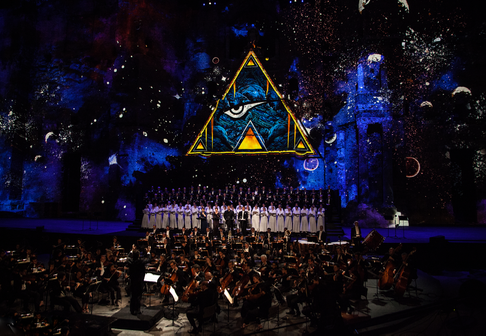 The Eye of Providence, Orchestre National du Capitole de Toulouse, soloists and the Orfeón Donostiarra. Photo copyright Kris Picart, courtesy of the Chorégies d'Orange
The Eye of Providence, Orchestre National du Capitole de Toulouse, soloists and the Orfeón Donostiarra. Photo copyright Kris Picart, courtesy of the Chorégies d'Orange
The acoustic of this massive theater is unforgiving, every voice of the awesome Toulouse Orchestra laid bare, the three flutes and two human voices of the Agnus Dei cutting into the hearts of the many thousands of spectators, the 60 centimeter high hammer stokes of the tympani mallets creating the deliberated havoc of an angry God, the huge bass drum thunderclaps burying us in eternal damnation.
The final prayer, the Libera Me, is intoned by the soul graveside who knows its guilt and begs the mercy of God for its salvation. It is delivered by the purist of voices, the soprano whose range belies the innocence of a child, whose warmth encompasses the heart of a woman, and whose primal ancestor was the Eve of original sin.
Russian conductor Tugan Sokhiev with his splendid players, the Orchestre National du Capitole de Toulouse sought universal humanity and not the particular sinner. The operatic drama of the individual soul was drowned by the hugeness of the theater, the one hundred five voices of the Orfeón Donostiarra from San Sebastion (Spain) and colossal, non-relevant, confusing and quite colorful iconography of the digital game-like images that were projected onto the huge scaenae frons of the Théâtre Antique. [This back wall is 61 meters wide by 31 meters high — 200 by 120 feet!]
In the late afternoon of July 17 the Aix Festival gave its final performance of a new opera entitled Kalîla wa Dimna (the names of a brother and sister), based on a Persian fable famous for its transcription by Ibn al-Muqaffa’ (executed in 759 AD) into narrative Arabic — a lion, jackal and raven trick a camel into sacrificing itself. In the opera a king is tricked into executing a poet whose song then posthumously reconciles populace with power.
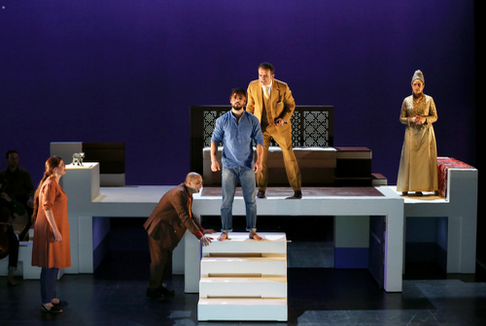 left to right: Kalîla (sister), Dinma (brother), the poet, the king, the queen mother, photo by Patrick Berger / ArtcomArt
left to right: Kalîla (sister), Dinma (brother), the poet, the king, the queen mother, photo by Patrick Berger / ArtcomArt
French/Palestinian composer Moneim Adwan combined elements of Arabic and Indian musical languages to create the 24 scenes that meticulously spell out deception and revelation. Five singers and five instrumentalists, all born and trained in the classical musical arts of north Africa or the Middle East, discovered many musical moods in richly melismatic singing and what seemed to be virtuoso levels of plucking, bowing, striking, and blowing mostly arabic instruments.
With lengthy narrations and perfunctory staging it was a theater piece with inserted songs more than an opera, and the heavily instructive intention of the story gave it the trappings of dogmatic oratorio. Most striking was the absence of relevance of its message to the Western world, and certainly its absence of relevance to the Arab world, civilizations shaken to their foundations in this twenty-first century. This 68th Aix Festival in particular was laden with social, intellectual and artistic complexities in which this opera was an island of innocence, an interesting and enlightening, too lengthy excursion into an alternative musical language.
The afternoon’s world of Arabic innocence, its innocuous play on power and pity gave way in the evening to the shattering intellectual proportions of an individual soul — the powerful Oedipus. The Grand Théâtre de Provence hosted Stravinsky’s opera-oratorio Oedipus Rex, the king of Thebes who confronts his blindness to know what he could not know, the savior of Thebes who must confess his sacrileges in searing melismas and become an object of pity.
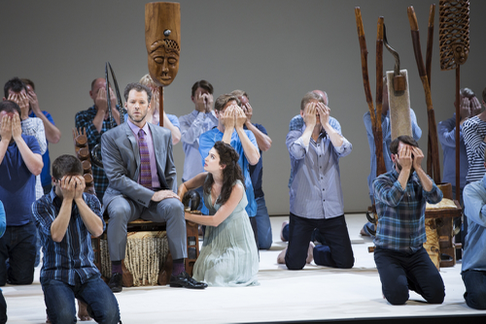 Oedipus and Antigone with singers of the Orphei Drängar, photo by Vincent Beaume, courtesy of the Aix Festival
Oedipus and Antigone with singers of the Orphei Drängar, photo by Vincent Beaume, courtesy of the Aix Festival
Shattering as well was the volume of sound pouring forth from the pit, Esa-Pekke Salonen’s magnificent Philharmonia Orchestra. The 75 voices of Orphei Drängar, the famed all male choir from Uppsula, Sweden shouted the glory of Oedipus’ power and their anger at his betrayal at unprecedented acoustic levels, and finally whispered their pity for their errant king.
Peter Sellars, the sixty-year-old wunderkind genius of late twentieth century opera ignored the text Stravinsky provided for narrator, making his own narrative adaptation for female voice of the Sophocles tragedy that would continue into Stravinsky’s Symphony of Psalms to complete the evening following an intermission.
This choral symphony was intoned by some seventy Christian singers comprised of members of Orphei Drängar, plus Sweden’s Gustaf Sjökvist Chamber Choir and its Sofia Vokalensemble. The blinded Oedipus, here bravely acted by the now silenced, splendid Canadian tenor Joseph Kaiser was led onto the stage by Oedipus’ daughter Antigone, the narrator for both pieces, and by her dancer sister Ismene (a Peter Sellars addition to the mythic forces at play in the Oedipus Rex).
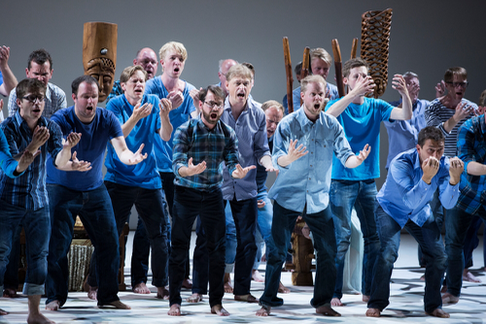 Singers of the Orphei Drängar, photo by Vincent Beaume, courtesy of the Aix Festival
Singers of the Orphei Drängar, photo by Vincent Beaume, courtesy of the Aix Festival
The Salonen pit begged redemption and peace for the soul of Oedipus in thundering exclamations as the lines of singers moved their arms in synchronized motions indicating abstracted, distilled universal participation in this neo-Classical musical world, Oedipus was led across the stage to be placed in a square of light (outlined by four neon tubes) while the chorus shouted praises of the Lord (Psalm 150). In the midst of this celebration Oedipus walked off stage left. The final image of this Symphony of Psalms was Antigone and Ismene embracing downstage right, each comforting the other.
In the aftermath of the tragedy in Nice each of us in Aix and Orange will have seen and felt these magnificent works of art in our own way. These were my perceptions.
Michael Milenski
Casts and production information:
Quatuor Arcanto Violin I: Antje Weithaas; Violin II: Daniel Sepec; Viola: Tabea Zimmermann; Cello: Jean-Guihen Queyras. Conservatoire Darius Milhaud, Aix-en-Provence, July 15, 2016).
Verdi Requiem Soprano: Erika Grimaldi; Mezzo: Ekaterina Gubanova; Tenor: Joseph Calteja; Bass: Vitalij Kowaljow; Chorus: Orfeón Donostiarra. Orchestre National du Capitole de Toulouse, Conductor: Tugan Sokhiev. Projections: Philippe Druillet. Thèâtre Antique, Orange, France, July 16, 2016.
Kalîla wa Dimna kalîla: Ranine Chaar; Dimna: Moneim Adwan; Le Roi: Mohamed Jebali; La Mère du roi: Reem Talhami; Chatraba: Jean Chahid. Music Director: Zied Zouari; Mise en scène: Olivier Letellier; Scenery Philippe Casaban and Eric Charbeau; Costumes: Nathalie Prats; Lighting: Sébastion Revel. Théâtre du Jeu de Paume, Aix-en-Provence, July 17, 2016.
Oedipus Rex / Symphony of Psalms Oedipus: Joseph Kaiser; Jocasta: Violeta Urmana; Créon / Tirésias / Messanger: Sir Willard White; Shepherd: Joshua Stewart; Antigone (spoken): Pauline Cheviller; Ismene (dancer): Laurel Jenkins. Philharmonia Orchestra. Conductor: Esa-Pekka Salonen; Mise en scène: Peter Sellars. Grand Théâtre de Provence, July 17, 2016.
image=http://www.operatoday.com/Oedipus_Aix3.png
product=yes
product_title=The Verdi Requiem in Orange, Kalîla wa Dimna and Oedipus Rex in Aix
product_by=A review by Michael Milenski
product_id=Above: Laurel Jenkins as Ismene, Josseph Kaiser as Oedipus, Pauline Cheviller as Antigone (closest) [Photo by Vincent Beaume, courtesy of the Aix Festival]
July 19, 2016
Jette Parker Young Artists Summer Performance
The JYPA Programme gives young singers, music staff, directors and conductors the opportunity to spend two years as full-time Company members, during which they receive comprehensive coaching in all aspects of the profession. The singers perform alongside leading international singers, taking minor roles and covering larger roles in main house productions. The annual Summer Performance allows them to take centre-stage and this year’s programme comprised five excerpts - from Kát'a Kabanová, Mireille, Eugene Onegin, Leoncavallo’s La bohème and Die Fledermaus.
There was much fine vocal talent on display, but the singers had to contend with some unhelpful direction and design. Director Richard Gerard Jones, a JPYA since 2015, and Lighting Designer Nick Havell decided to give all the scenes a ‘modern’ spin with a ‘radical’ edge. An eight-foot black wall served as a set and props were minimal - a transistor radio for Varvara and Kudrjáš to bob along to, a wheel-chair for Mireille to slump into, an armchair to support the fast-fading Mimi, a microphone for a karaoke-rendition of the Champagne Aria. Certainly, stagings need not be lavish to make their mark - companies such as Opera Holland Park and Bampton Classical Opera repeatedly prove that invention can triumph over budgets - but the grungy grimness of these designs was dispiritingly unimaginative. Lighting was of the extreme chiaroscuro type with naked bulbs (starlight for the lovers’ nocturnal tryst in Kát’a ) and dazzling strip-lights (glaring painfully from the lowered lighting rig at the close of Onegin) serving to blind rather than illuminate. Too often characters were half in darkness, which I suppose did fit in with the general ‘twilight zone’ ambience.
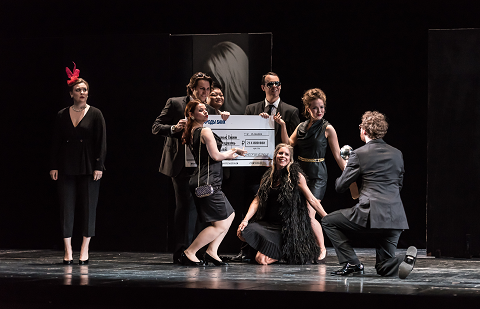 Jennifer Davis (far left) as Tatyana; Act III Eugene Onegin. Photo credit: Clive Barda.
Jennifer Davis (far left) as Tatyana; Act III Eugene Onegin. Photo credit: Clive Barda.
The settings, and costumes, were dubious, too, in that they didn’t seem to take heed of anything that the protagonists might be singing about. The tender romance of the night-time rendezvous in Kát’a was blunted by Varvara’s far too revealing hot-pants. Mireille did not seek her wounded lover in the church of Sainte-Maries-de-la-Mer, but found herself in a mental asylum, dressed in a white sack and dumped, fairly unceremoniously, in a wheelchair while two medics looked on aghast at the vocal antics of this would-be suicide. Prince Gremin’s ball was a flashy charity fundraiser complete with paparazzi to snap the posing celebrities, and the somewhat coarse ambience was at odds with the grave sincerity of Gremin’s subsequent avowal of love for Tatyana. Café Momus was a pole-dancing club - or so the animated neon silhouettes which prefaced the final scene from La bohème suggested: they drew an initial whoop but the flickering images, on a loop, quickly became nothing but a distraction. Worse still, they reappeared half-way through Orlovsky’s ball, though there was nothing riotous, or anything festive, about the revelling.
However, despite the fact that the black wall, which radically foreshortened the ROH stage, made the acoustic unsympathetic to the voices the singers displayed considerable talent, with the ladies perhaps just having the edge.
Vlada Borovko, who the evening before had sung the role of Xenia in the ROH’s Proms performance of Boris Godunov ( review), was an impassioned Kat’á Kabanová, demonstrating great power at the top and a lovely gleaming timbre. Kat’á’s innocence and love were equally credible. Borovko received praise when she made a role début when she stepped into Violetta’s shoes at short notice in March this year, and I look forward to hearing her sing Mademoiselle Jouvenot (Adriana Lecouvreur) and Giannetta ( L'elisir d'amore) next season. Emily Edmonds was a vivacious Varvara and as Prince Orlovsky she got the party going with a swing. Edmonds won acclaim in her native Australia before joining the JPYA Programme in 2015 and one can see why: her mezzo is full and sensuous, and she has sparkling stage presence. Her performances next season, which include Kate Pinkerton (Madame Butterfly) and Tebaldo ( Don Carlo) will be keenly anticipated.
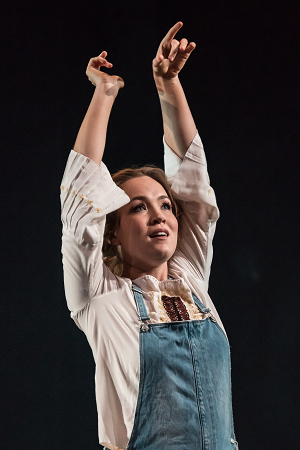 Emily Edmonds as Varvara. Photo credit: Clive Barda.
Emily Edmonds as Varvara. Photo credit: Clive Barda.
There is currently a quartet of Australian JPYAs, and soprano Lauren Fagan shone as Gounod’s Mireille, despite having been cast as a deluded, self-harming depressive. Her stunningly rich tone and vibrant timbre rose above the incongruous design and later, as Mimì, she showed that she has range of colour too. She deserved praise for showing forbearance with the directorial quirks in the latter excerpt too, whipping an oxygen mask from a carrier bag and convulsing violently during in Mimì’s death throes. Despite a pre-curtain announcement that Jennifer Davis was under-the-weather, there was no obvious effect on her singing and she was an open-hearted Tatyana, her soprano unforced and rounded, and a bright Adele in Fledermaus. Davis is cast as Ines in next season’s Il trovatore and as Arbate in Mitridate, re di Ponto.
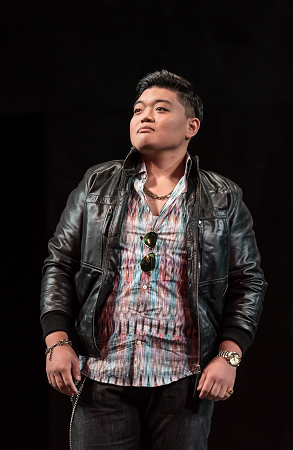 David Junghoon Kim as Kudrjáš. Photo credit: Clive Barda.
David Junghoon Kim as Kudrjáš. Photo credit: Clive Barda.
Among the men, Australian baritone Samuel Dale Johnson stood out as a firm-voiced Rodolfo and was joined in the ‘garret’ by David Shipley’s Schaunard and Samuel Sakker’s Marcello for a tacky take-away beside a needle-light Christmas tree and a feeble electric bar-heater. Sakker, the fourth of the Australians, also had his moment in the spotlight during the run of Traviata earlier this year, stepping in as Alfredo when Albanian tenor Saimir Pirgu was struck down by a last-minute illness. He has a resonant tenor and appealing tone but he’s not a natural stage animal and took a while to settle as Boris in the scene from Kát’a Kabanová. In contrast, David Junghoon Kim was an ebullient and strongly characterised Kudrjáš. Kim and Sakker share the role of Ruiz in the double-cast Il trovatore next season.
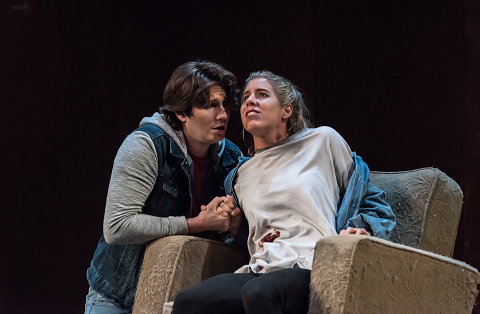 Samuel Dale Johnson (Rodolfo) and Lauren Fagan (Mimì). Photo credit: Clive Barda.
Samuel Dale Johnson (Rodolfo) and Lauren Fagan (Mimì). Photo credit: Clive Barda.
James Platt - who, like Borovko, sang in the previous evening’s Prom performance (Border Guard) - injected some much needed gravitas into the Eugene Onegin excerpts. Tall and imposing, he was an impressive Prince Gremin and had the low notes for Gremin’s declaration of love, descending smoothly to the bottom. No wonder Tatyana threw her arms around him in a tight bear-hug. Yuriy Yurchuk has a sonorous baritone but his brief turn as Onegin didn’t afford much opportunity to show it off. I admired Yurchuk’s performance as Angelotti in January this year ( review) noting that he used ‘his lovely tone to garner our sympathy’, and his moment came in Die Fledermaus, as the elegant Dr Falke calmly invited Orlovsky’s revellers to treat each other as ‘Brüderlein und Schwesterlein’. There will be several chances to hear Yurchuk at Covent Garden next season, as he performs Schlemil (Les Contes d'Hoffmann), Baron Douphol (La traviata) and Prince Yamadori ( Madame Butterfly).
The fine singing was complemented by the crisp playing of the ROH Orchestra conducted by Paul Wynne Griffiths, Paul Wingfield and Jonathan Santagada (the latter two are former and current JPYAs respectively). Fledermaus’s Adele tells us that ‘Champagne washes down all sorts of things sometimes, So wise monarchs never let, their people go thirsty’. On this occasion it was the fantastic music-making which was the spoonful of sugar.
Claire Seymour
Jette Parker Young Artists Summer Performance
Janáček: Kát’a Kabanová, Act II, scene 2
Katěrina (Kát’a): Vlada Borovko; Varvara: Emily Edmonds; Boris Grigorjevič: Samuel Sakker; Váňa Kudrjáš: David Junghoon Kim; Conductor: Paul Wynne
Griffiths; Celeste: Colin Scott.
Gounod: Mireille, Act IV aria
Mireille: Lauren Fagan; Conductor: Paul Wingfield; Organ: Colin Scott.
Tchaikovsky: Eugene Onegin, Act III, scenes 1 and 2 (excerpts)
Tatyana: Jennifer Davis; Eugene Onegin: Yuriy Yurchuk; Prince Gremin: James Platt; Guests: Vlada Borovko, Lauren Fagan, Emily Edmonds, David Junghoon Kim,
Samuel Sakker, Samuel Dale Johnson and David Shipley; Conductor: Jonathan Santagada.
Leoncavallo: La bohème, Act IV
Mimì: Lauren Fagan; Musetta: Emily Edmonds; Marcello: Samuel Sakker; Rodolfo: Samuel Dale; Johnson; Schaunard: David Shipley; Conductor: Paul Wynne
Griffiths.
Strauss: Die Fledermaus, Act II finale (excerpt)
Rosalinde: Vlada Borovko; Adele: Jennifer Davis; Ida: Lauren Fagan; Prince Orlofsky: Emily Edmonds; Gabriel Eisenstein: Samuel Dale Johnson; Dr Falke:
Yuriy Yurchuk; Colonel Frank: James Platt; Guests: David Junghoon Kim, Samuel Sakker and David Shipley; Conductor: Paul Wynne Griffiths.
Royal Opera House, Covent Garden, London Sunday 17 July 2016
image=http://www.operatoday.com/JPYA%20Summer%20Performance.png image_description=JPYA Summer Performance, ROH product=yes product_title=JPYA Summer Performance, ROH product_by=A review by Claire Seymour product_id=Above: The finale of Act II Die FledermausPhoto credit: Clive Barda
July 18, 2016
Prom 2: Boris Godunov, ROH
Last year saw him at the helm of Grange Park Opera’s performance of Fiddler on the Roof, as the deep-thinking Russian dairyman, Tevye, whose Jewish cultural traditions are threatened by both his daughters’ nuptial plans and the Tsar’s political strategy to expel the Jews from the Anatevka shtetl (review). This year he returned as Boris Godunov, the guilt-racked Tsar plagued by his conscience, superstition and insecurities, driven to despair and death by deceit and doubt.
The Royal Opera House de-camped to the west side of town for this concert performance of Richard Jones’ production of Musorgsky’s opera, seen at Covent Garden in March (review), conducted by Antonio Pappano. There was no attempt to ‘semi-stage’ the work, other than a few token gestures. For example, the newly crowned Boris made his first appearance in the organ console, behind and above his adulating people - a magnificent sight in ceremonial crème and gold, but less successful vocally as Terfel struggled to project from this distant placement. But, the decision to avoid too much stage business was probably a sensible one, especially given the 1869 version performed here focuses less on the conflict between Boris and his people than on the tortures within his own mind. With the protagonists delivering their long orations and narratives from the front of the stage, an intense immediacy was created as they seemed to be speaking directly to the Prommers before them, overcoming the Albert Hall’s capacious dimensions.
Nicky Gillibrand’s costumes and make-up were retained but Jones’ and Miriam Buether’s designs were largely dispensed with, and there were both gains and losses from the omission of the visual symbolism and the choreographic dimension - with the gains perhaps in the ascendant.
On the down side, the involvement of the Chorus in the dramatic denouement was lessened. This was in no way a consequence of the quality of the choral singing, which was superlative. The Royal Albert Hall has witnessed countless choral apotheoses over the years, but the power and passion of the Russian populace’s acclamation of their new Tsar, as Boris emerges from the Cathedral of the Assumption in the opening scene, must have equalled the best of them. Although they were seated behind the ROH Orchestra, quite distant from the action, it was evident that each individual member of the Chorus was deeply alert to the musico-dramatic arguments being presented by the various soloists.
However, the Chorus’s engagement with the drama was inevitably somewhat ‘at a remove’, and this was especially noticeable in the fourth Act where unrest grows among the people who gather in the square before the Cathedral of St Basil the Blessed, and in desperation and hunger beg the shocked Tsar to give them bread. The result was that Boris seemed less concerned about the popular dissent that his past crime may have caused and more obsessed with his inner struggles and suspicions; while this sharpened the psychological portrait of the Tsar, the tender lyricism of the people’s folk-song appeal for alms was less poignant.
The iconic replication of the Tsar Bell of the Kremlin had been a powerful emblem in Buether’s designs; here the duplications in embossed granite and the dark projections which hung in the belfry about Pimen’s cell in the Chudov Monastery were reduced to an ultramarine frieze behind the performers. The carillons which clang in joyful cacophony during the Coronation Scene resounded from the RAH Gallery, but they were both too detached from the drama - Prommers were distracted from the stage as they swivelled to see where the clarion was coming from - and rather too loud.
There were a couple of places where I wondered whether projections might have been used to substitute for elements of Buether’s design that had had great impact at Covent Garden. For example, the story-board chronicle of Russian history which is a back-drop for Pimen’s narration - and upon which portraits of three former Tsars are followed by an unfinished likeness of the red-haired, murdered Dmitri - and the huge map which dominated the Tsar’s apartments upon which the Russian territories were signalled red, as if the land is bathed in blood, might have been recreated in this way. But, on the plus side, out went the repetitive intrusion of the mimed murder of Dmitri and the profusion of spinning tops.
So much depends upon the Tsar’s grandeur and guilt, and although Bryn Terfel, as I remarked in March ‘may not be able to summon the sonorous darkness of a basso profundo’, he once again excelled and showed what a fine singing-actor he is. This time round his Tsar was even more isolated, trapped within the claustrophobic torment of his own mind and drawn only momentarily from his anguish by the presence of his children Fyodor (a sweet-toned Ben Knight) and Xenia (Vlada Borovko).
If the Tsar’s psychological loneliness lessened the dramatic weight of these familial scene, then it deepened our understanding of Boris’s despair and decline. Left alone in the Tsar’s apartments, Terfel’s desperate, hallucinatory reflections on his five-year reign - he is blamed for everything, even the death of Xenia’s fiancé and the poisoning of his own sister - revealed a lack of proportion and reason which will push him into an inexorable physical and mental deterioration.
And in the final scenes this deterioration was laid bare: grey, dishevelled and lurching wildly, this was a man on a precipice. Terfel used every aspect of his voice to growl with fury at the Simpleton, and bellow at the duplicitous Shuisky, whom he both distrusts and fears, while the soft articulation of the higher-lying passages conveyed the Tsar’s affection for his son, and his psychological fragility.
Terfel was joined by an outstanding cast, many of whom were reprising their roles. Estonian bass Ain Anger was once again marvellous as Pimen. He delivered his account of his country’s past ills and wonders with such magisterial authority that one longed to hear what intensity he might bring to the role of Boris.
David Philip Butt conveyed Grigory’s haughty and somewhat gauche idealism effectively, while John Graham-Hall injected his smooth tenor with a sinister nuance as the obsequious but self-serving Shuisky, though the lack of staging meant that dramatically his role had less clear direction and he often seemed to be just hanging around in the side-lines.
The smaller roles were just as strongly performed. Jeremy White’s Police Officer hurled out brusque insults to the cowering populace; Kostas Smoriginas sang Andrei Shchelkalov’s announcement to the people that Boris has refused to become Tsar with a noble, legato line.
John Tomlinson’s grotesque comic turn as Varlaam had been one of the highlights of the Covent Garden performances, but he was absent here and the scene at the Lithuanian border was weakened by the lack of visual context and contrast. Rebecca de Pont Davies’ was a blowsy gregarious Innkeeper, though, and the two wandering monks, Varlaam (Andrii Goniukov) and his drinking buddy Missail (Harry Nicoll) added a dash of japery, including a deft percussive contribution on the musical spoons.
Even though the Simpleton was denied the opportunity to play directly to the populace, Andrew Tortise was again excellent as he foretold of forthcoming disaster and defamed Boris before a crowd of mischievous urchins.
I enjoyed the opportunity, too, to see Antonio Pappano guide the Orchestra of the Royal Opera, rather than simply hear the results. Peering into the ROH pit I’ve sometimes wondered how the baton-less Pappano’s hyperactive ‘hand-pumping’ and vigorous arm-swinging is interpreted by the players, but now it makes perfect sense. Pappano is like an electricity generator, ceaselessly pumping out energy which surges through each and every performer. I think that some of the orchestral subtleties were lost in the vastness of the RAH, but the crafting of the over-arching tensions was brilliant and the climaxes were by turn grandiose and suffused with anxiety.
This was a captivating performance: two hours of compelling narrative in which magnificent musical peaks communicated the sheer psychological force of Boris Godunov’s inner conflicts. Witnessing his death, we truly understood his tragedy.
Claire Seymour
Musorgsky: Boris Godunov
Boris Godunov - Bryn Terfel, Prince Shuisky - John Graham-Hall, Andrey Shchelkalov - Kostas Smoriginas, Grigory (Pretender Dmitri) - David Butt Philip, Pimen - Ain Anger, Varlaam - Andrii Goniukov, Missail - Harry Nicoll, Yurodivy (Simpleton) - Andrew Tortise, Xenia - Vlada Borovko, Xenia’s Nurse - Clarissa Meek, Hostess of the Inn - Rebecca de Pont Davies, Mityukha - Adrian Clarke, Border Guard - James Platt, Nikitich - Jeremy White, Fyodor - Ben Knight, Boyar - Nicholas Sales; conductor - Antonio Pappano, Royal Opera Chorus (chorus-master - Renato Balsadonna), Orchestra of the Royal Opera House.
Royal Albert Hall, London; Saturday 16th July 2016.
image= http://www.operatoday.com/Boris%20Chris%20Christodoulou.png image_description=Boris Godunov, ROH at the Proms product=yes product_title=Boris Godunov, ROH at the Proms product_by=A review by Claire Seymour product_id=Above: Bryn Terfel as Boris GodunovPhoto credit: Chris Christodoulou
July 16, 2016
Des Moines’ Gluck Sets the Standard
The answer would be found in Des Moines Metro Opera’s incandescent production of Orphée et Eurydice. Under Chas Rader-Schieber’s inspired direction and Gary Thor Wedow’s stylish baton, the plentiful artistry on display gives plenty of cause for celebration.
First and foremost, what a treat it is to see DMMO take a chance on a piece that many opera enthusiasts may know of, but never get a chance to experience. This operatic game changer is best known for the mezzo’s set piece Che faro senza Euridice, excerpted from the Italian version. This production, presented in the French version is a reminder, nay revelation of Gluck’s musical genius, and proves a powerful souvenir of a golden age of explosive creativity.
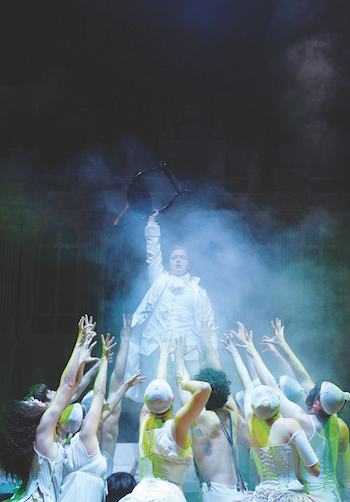 Jennifer Johnson Cano and the Furies
Jennifer Johnson Cano and the Furies
Mr. Rader-Schieber has endowed the staging approach with a striking, yet delicate balance of sobering introspection and mythical whimsy. The stage configuration of Simpson’s College’s Blank Performing Arts Center can prove a challenge, bisected as it is by the orchestra pit. The main stage is connected to the thrust by walkways on either side of the lowered pit. The director addresses this limitation by exploring a wide variety of performer placement and continually morphing choral groupings.
In an awesome display of subtlety and nuance, he managed to create well-motivated movement that kept the pictures in flux so that all three side of the horseshoe seating were engaged and visually satisfied. Jacob A. Climer’s handsome, evocative, and frequently dazzling sets and costumes perfectly matched and amplified the director’s artistic sensibilities.
The picture of Mr. Climer’s cool, white cemetery building with decaying wrought iron fence was intersect by a pick-up-sticks like scattering of slender white trees, slightly akimbo. On the thrust is a rectangular grave with a mound of fresh dirt, studded with votive candles. As a white clad, grieving Orphée keens his opening aria, he at first claws at the dirt, then wipes his hands on his clothing, as if wanting to desperately connect with the earth that covers his beloved wife. This was just the opening salvo in several rounds of powerful imagery.
This grave recedes downward and when the trap raises again it bears a writhing chorus of Hades demons who remain submerged waist-level until dancers ooze-crawl onto the stage and proceed to enact a ritual of death. An unsuspecting and unwilling mortal gets roughly stripped of his clothes (read: life) and gets passed, all but naked, down the mosh pit of choristers to death’s realm. The characterful, stylish dances and movement were choreographed with insightful skill and elegance by Jillian Foley.
The festive serenity of the Elysian fields is realized in a hot red palette that could not have been further from the restive handsome cemetery. The chic black court attire is here accented with headwear (and a touch of red) cleverly suggesting deer, rams, goats, and the like. Set pieces were limited to matching red-trees in weighted boxes that could be configured (and re-) to vary the playing area. These stylized bucolic gestures were a perfect complement to the radiant, fairy-princess-perfect gown that adorned Eurydice in gradations of pink.
After her husband breaks his vow and looks upon her, the effect of Eurydice’s death, was brutally blunt and stunning. She was positioned with her back to us upstage on a platform facing Orphée, collapsed onto him, and then sunk into death as she tumbled backwards and downwards on the red stairs. But the evening’s coup de theatre was yet to come. The graveyard façade flies back in separating Orphée from Eurydice once more as it isolates him to sing his famous lament.
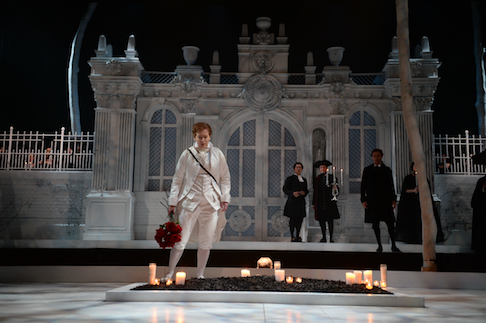
Partway through the aria, red rose petals began to fall into the open grave on the thrust. Then they escalate to a flurry as the original rectangular grave reappears, this time covered with a mound of petals. Well, when the winged Amour (clad in eye-popping, shiny gold) brings the heroine back to life one final time, he does so by reaching deep in the mound of petals and drawing out the actress in a matching red gown as the petals cascaded all ‘round. Yes, there were audible gasps. All of this stage magic was flawlessly enhanced by Nate Wheatley’s superb lighting design, and Brittany Crinson’s well-judged make-up and hair design (for Elsen and Associates).
In the pit, Maestro Gary Thor Wedow infused the musical reading with passion and immediacy. Performances of this genre can sometimes become precious, reverential, or worse, irrelevant. But Mr. Wedow encouraged a rendition full of buoyant freshness and dramatic vitality. His instrumentalists responded with equal doses of plangency and panache. Lisa Hasson’s wondrous chorus sang with a full arsenal of well-calculated effects from full-throated joy, to satisfied contentment, to sympathetic bereavement, to satanic vitriol. Bravi tutti. With the title role soloists, we were blessed to have two singers at the top of their game and on the cusp of their fame.
In a time that many young singers sound polished but somewhat monochromatic, no one seems to have told Jennifer Johnson Cano to play it safe. Ms. Cano’s highly individual Orphée was a star turn of significant proportions. Her burnished mezzo has it all: size, color, agility, evenness and individuality. She effortlessly tossed off coloratura with elan as well as meaning, filled the house with refulgent phrases, and drew us into her despair with barely audible vocal effects. She tears into the part with such abandon that occasionally a bit of huskiness intrudes in her powerful lower voice, but oh my, this was a towering, personalized performance.
Susannah Biller is every bit her equal as a radiant, golden-toned Eurydice. Ms. Biller finds every modicum of charm, grace, and poise in her characterization, and is mightily impressive as her elation inexorably turns into heart-wrenching despair. Her secure, gleaming soprano encompassed a wide range of musical colors and she was able to ply her voice to create any number of admirable dramatic effects.
Rounding out the principals, Cree Carrico’s clear, shining soprano was an ideal match for the requirements of the small but indispensible role of Amour. Her poised, focused tone vocally matched her winning, spunky personality. Ms. Carrico made the most out of every second she was on, exuding an infectious and charismatic stage presence.
James Sohre
Cast and production details:
Orphée: Jennifer Johnson Cano; Eurydice: Susannah Biller; Amour: Cree Carrico; Dancers: Jillian Foley, Isaac Lerner, Megan McCarthy, Tariq Mitri; Conductor: Gary Thor Wedow; Director: Chas Rader-Schieber; Set and Costume Design: Jacob A. Climer; Lighting Design: Nate Wheatley; Choreographer: Jillian Foley; Make-up and Hair Design: Brittany Crinson for Elsen Associates
image=http://www.operatoday.com/DSC_1992.png image_description=Jennifer Johnson Cano, Susannah Biller and Cree Carrico as Amour [Photo courtesy of DMMO] product=yes product_title=Des Moines’ Gluck Sets the Standard product_by=A review by James Sohre product_id=Above: Jennifer Johnson Cano, Susannah Biller and Cree Carrico as AmourPhotos courtesy of DMMO
Des Moines: Jewels in Perfect Settings
Now in its third year, DMMO has endeavored to make these smaller gems more immersive experiences by matching subject matter of the operas to an appropriate venue. To that end Philip Glass’s Galileo Galilei was housed in the Des Moines Science Center. Last year’s Rappaccini’s Daughter about a misguided gardener was set in the Botanical Gardens.
This is an idea that was obviously sewn on fertile ground, for performances I attended each year were packed out. The quality of the experience and the opportunity to hear unique repertoire are proving to be a potent lure.
The production of Galileo Galilei could hardly have been bettered, starting with a mesmerizing musical realization of the Glass ‘formulaic’ score. You pretty much know what you are going to get from this composer: repetitive arpeggiated phrases, accented rhythms challenged by other percussive stings, staccato commentary, sustained chords serving as a different kind of cantus firmus.
Under the steady baton of Michael Sakir, every calculated effect was carefully allowed its proper place. There is a different Glass sound to this score, the small orchestra comprised disproportionately of lower voices. There is an occasional, welcome brightness from higher winds, but the overall effect was a preponderance of a restless weightiness, in both music and Mary Zimmerman’s text.
That the music-making never became ponderous was a great credit to the poised, polished playing. Maestro Sakir’s concentration never wavered and he led his amassed forces through the complex writing with insight and skill. He was in full command of the most minute shifts of the sound palette, and he found a wonderful build to the final expansive choral statement. I only wished that he had not paused quite so long between scenes. The composer did not put musical “buttons” on many (any?) scenes, and the forward motion of the piece was sometimes interrupted by applause, to fill an uncomfortably odd silence.
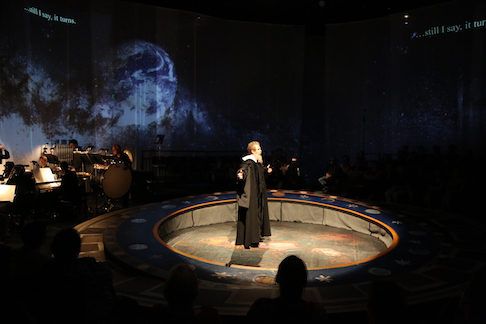 Chris Carr as the Older Galileo
Chris Carr as the Older Galileo
Every single element of the design was top tier. The production was presented in arena style, and set designer Adam Crinson created a playing space that was simple but highly practical. Mr. Crinson used Galileo’s drawing for decorative inspiration of a circular “stage,” consisting of a circular platform/ramp within another circular platform/ramp tilted in opposition to each other. These “rims” enclosed a central “pit” with a mosaic-like painting on its floor. The ramps were of a perfect height for actors to sit on them, and provided a circular walking space around the perimeter of the action.
With the orchestra placed at 12 o’clock, a horseshoe of tiered seating surrounded the stage. The designer encircled the entire space in an ethereal hanging of floor-to-ceiling scrim panels, upon which was projected a non-stop cornucopia of images relating to Galileo’s life and work. Barry Steele’s masterful lighting and projections were a model of excellence.
To add to this embarrassment of riches, Aryana Petrashenko has designed sumptuous costumes that are not only strikingly attractive but which also immediately define the characters. The beautifully judged set pieces were the icing on a very rich cake. This was quite simply one of the most perfectly realized opera designs I have seen in many a moon, in total service to the composition.
Given this true feast for the eyes, we might not be blamed were we to come out “humming the scenery.” But director Octavio Cardenas and his talented cast have accomplished a considerable success in performing this rarity with dedicated passion and precision.
Mr. Cardenas found no end of diverse uses for this space, and its limitations seemed to be liberating as he cleverly place the singers in any number of varied groupings and poses. Every possible entrance was utilized, the height of the ramp versus the depth of the pit was exploited, and a myriad of highly theatrical presentations impressed. The haunting look of the four empty birdcages on sticks, the administering of the ‘irons’ that suspend and punish Galileo, the evocation of three people in a Venetian gondola suggested by two chairs and a paddle, all were magical.
While sightlines were otherwise carefully managed to accommodate the surrounding audience, only the final static choral position blocked the view of “the Galileo’s” in the pit. Perhaps a bit of motion could have remedied that but all told, this was a breathtakingly inventive staging.
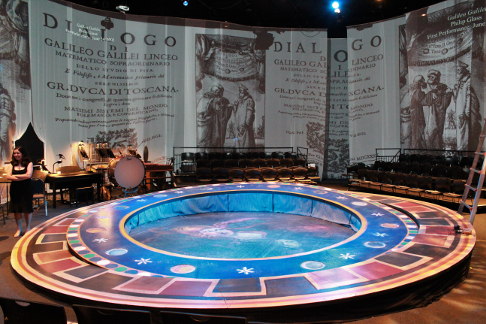 Pre-show image of audience surround of Galileo
Pre-show image of audience surround of Galileo
The singing was of a very high standard. As Old Galileo, Chris Carr’s compact, stirring tenor had a smooth and easy delivery with commendable legato, suggesting the resignation of a mature man. Troy Cook has a fluid baritone of substantial tonal beauty. Mr. Cook informed Younger Galileo with a firmly voiced passion for scientific truth and justice. The two singers complemented each other beautifully as different aspects of the fascinating title character. Rounding out the trio of Galileos (Galilei?), Camron Bennington brought a fine, focused presence to the Child Galileo.
Tony Dillon gave his usual solid performance as Pope Urban and Cardinal Barberini, his rich bass-baritone capable of considerable heft and meltingly beautiful sotto voce effects as required. Bryan Pollock (Cardinal 1/Oracle 1) has an easily produced countertenor which he was able to vary in tone from reedy warmth to edgy body. Other than that, the show was a feast of excellent baritone showcases. Reuben Lillie (Salviati) enlivened the Venetian trio with a memorable turn that was marked by bravado and characterful phrasing. His virile sound was well-served by a reliable technique.
Conor McDonald (Servant/Oracle) impressed with a steady, forward-placed baritone, especially as he intoned a relentless solo passage circling around the action on auto-pilot. Baritone Spencer Reichman (Servant/Oracle 2) has a pleasant, burnished delivery that not only produced some highly charged solo passages, but greatly enriched ensemble work. Rounding out the men was a noteworthy contribution from baritone Reuben Walker with his assured, musical singing as Cardinal 2.
On the distaff side, there was also much to admire. Ashly Neumann pretty much nailed her first extended solo as Maria Celeste, vanquishing the demands of the high tessitura with a ferocity and laser-focused soprano. At times, it was perhaps a little too focused as a hint of steeliness crept in. Ms. Neumannn’s later, more introspective singing was marked by a more pleasing and rounded sound. Emily Tweedy’s Duchess Christina is also required to come on like gangbusters, which may have infused her resonant soprano with a somewhat generous amount of vibrato. As she (and the music) relaxed into her assignment, Ms. Tweedy contributed passages of genuine beauty and control.
Melisa Bonetti is possessed of a warm, supple mezzo that struck all the right impressions, first as a self-assured Scribe, and later as a rather imperious Maria Maddalena. Cree Carrico’s turn as Sagredo was infectious and appealing, her bright, well-schooled soprano sporting zing and polish. I wish Ms. Carrico had put just a bit less weighty effort into being “important” as Eos as her lower voiced singing tended to harden under pressure. Andrea Baker made the most of her stage time with a cleanly voiced Marie de’Medicis.
James Sohre
Cast and production details:
Older Galileo: Chris Carr; Younger Galileo: Troy Cook; Pope Urban/Cardinal Barberini: Tony Dillon; Simplicio: Matthew Scollin; Cardinal 1/Oracle 1: Bryan Pollock; Cardinal 2: Reuben Walker; Cardinal 3/Priest: Conor McDonald; Servant/Oracle 2: Spencer Reichman; Maria Celeste: Ashly Neumann; Duchess Christina: Emily Tweedy; Scribe/Maria Maddalena; Melisa Bonetti; Salviati: Reuben Lillie; Sagredo/Eos: Cree Carrico; Marie de’Medicis: Andrea Baker; Child Galileo: Cameron Bennington; Conductor: Michael Sakir; Director: Octavio Cardenas; Set Design: Adam Crinson; Costume Design: Aryana Petrashenko; Lighting and Projection Design: Barry Steele; Make-up and Hair Design: Brittany Crinson for Elsen and Associates
image=http://www.operatoday.com/3X3A1073.png image_description=Troy Cook as the Younger Galileo [Photo courtesy of DMMO] product=yes product_title=Des Moines: Jewels in Perfect Settings product_by=A review by James Sohre product_id=Above: Troy Cook as the Younger GalileoAll photos courtesy of DMMO
First Night of the Proms 2016
Music, especially avowedly political music, has associations, though, and what many, but not all, English and French listeners might understand as solidarity following the previous night’s carnage in Nice, might sound rather different to a listener from, say, the Maghreb. Nationalism is, after all, a big part of the problem - as London has rediscovered with a vengeance over the past few weeks. The issue of ‘national anthems’ is fraught too; ours, in the (Dis)United Kingdom is about as divisive as it could be, eliding membership of a nation with monarchism and thus necessarily defining republicanism as a foe within. French revolutionaries, insisting on national sovereignty, offered a not entirely dissimilar binary opposition: that, ultimately, led to the execution of Louis XVI, who, having a veto, could not be part of the nation, which, in a time of emergency, led to one particular conclusion. It also led to - well, we know the rest. Returning to the Royal - yes, Royal - Albert Hall, applause at the end heightened the oddness. If the opening number were a sign of respect, however problematical - and that is how I took it, standing like everyone else - then why would one applaud? Might an aestheticised version of the anthem, for instance that of Berlioz, not have been another option? I felt conflicted, then, but I seem to have been in a minority; many were clearly inspired by the hope and solidarity they felt had been afforded.
Tchaikovsky’s Romeo and Juliet sounded, in this context, especially dark in its fatal opening bars. The introduction took its time, pace gathering with a proper harmonic foundation; Sakari Oramo is far too musical a conductor to whip up artificial ‘excitement’. The Allegro sounded turbulent indeed, counterpoint nicely Berliozian (should that not be too much of a paradox). The BBC Symphony Orchestra played the ‘Love’ theme gorgeously, without a hint of vulgarity. On more than one occasion, the harp stole our hearts, although so, to be fair, did the BBC woodwind. Tension between programme and material was productively explored, so to enthral and indeed to move all the more. There could certainly be no doubting the strength of the partnership between the BBC SO and Oramo.
Sol Gabetta joined them next for the Elgar Cello Concerto, with equally fine results. In the first movement, the Moderato material proved very much the child of the preceding Adagio, transition emotionally as well as technically seamless, whilst remaining a transition nonetheless. Much the same might be said of the transition between first and second groups; although the mood lifted in some respects, it remained dependent (secondary, one might say) upon what had come before. It was not all doom and gloom, by any means; Elgar’s Mendelssohnian inheritance came sparklingly to life at times. Underlying sadness, however, remained inescapable. The background of German, even Leipzigerisch, Romanticism was also present in the scherzo; it sometimes came into the foreground too, albeit without banishing unease entirely. Elgar’s modernity, even modernism, was as unquestionable as its roots. (Applause and bronchial outpourings were most unwelcome at the movement’s close.) There was nothing morose about the Adagio, although it certainly sounded deeply felt. It was, rather, passionately songful, with wonderfully hushed tones too to relish, both from Gabetta and the orchestra. Dialogue and incitement were the generative order of the day in the final movement. Light and shade were expertly judged, likewise harmonic motion. Kinship with Elgar’s symphonies was clear, although, by the same token, this was decidedly later music too, almost an English cousin to Ravel’s Le Tombeau de Couperin. Ultimate weight was placed on the finale, and rightly so. Gabetta returned to the stage, following justly warm applause, to perform Pēteris Vasks’s Dolcissimo, her solo vocal as well as instrumental; this was an auspicious Proms debut indeed.
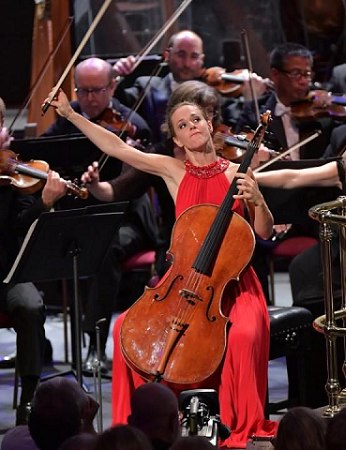 Sol Gabetta. Photo Credit: Chris Christodoulou.
Sol Gabetta. Photo Credit: Chris Christodoulou.
The second half was given over to Prokofiev’s Alexander Nevsky Cantata, based on the composer’s score for Eisenstein’s film of that name. Its nationalism can hardly fail to make one uneasy too; Stalin is quoted in the Proms programme as having declared to the director, ‘Sergey Mikhailovich, you’re a good Bolshevik after all!’ Not that Stalinism by this stage had so very much to do with Bolshevism, but anyway … Prokofiev, awkwardly for many of us who admire him, often, although not always, seemed to flourish in such circumstances. Those who would have us believe that art is somehow removed from politics could not be more wrong; more to the point, their protestations could not be more pernicious. However much one might want to wish away awkward questions, such as over the Marseillaise, one cannot - and should not.
The opening orchestral number, ‘Russia under the Mongolian Yoke’, was cold yet colourful, just as it should be. The ‘Song of Alexander Nevsky’ revealed choral forces (both the BBC Symphony Chorus and the BBC National Chorus of Wales) both weighty and clear. Prokofiev’s homophonic writing helps in the latter respect, of course, but only helps. The ‘patriotism’ and militarism of the words - ‘Ah, how we fought, how we hacked them down!’, ‘Those who invade Russia will meet death,’ etc. - is all the more perturbing when performed with such musical conviction as here. An impeccably post-Mussorgskian orchestral opening announced ‘The Crusaders in Pskov’, the dissonances of course quite Prokofiev’s own, harking back to The Fiery Angel and forward to Romeo and Juliet. Even here, in ‘socialist realist’ land, there is some of the bite of the more youthful composer’s acerbity - and so there was in performance. Echoes of Boris Godunov sounded all the more strongly as the number progressed. One could hear what must have attracted Claudio Abbado to this music.
The following chorus, ‘Arise, Russian People’, provided a not un-Mussorgskian contrast. Motor rhythms in particular rendered the composer’s identity unmistakeable. Glockenspiel and xylophone offered the most enjoyable of rejoicing later on. ‘The Battle on the Ice’ is the longest number in the cantata; here it proved very much the musical and emotional heart too. Its introduction was not only atmospheric, but atmospheric in a filmic way. Oramo brought out the glassy violas at dawn to strike a proper chill. Still more chilling was the barbarism of war proper, those motor rhythms and grinding dissonances once again proving the engine of progress; the scherzo of the Fifth Symphony hovered not so far in the musical future, whilst Mussorgsky’s shadow was, once again, rarely far from the aural stage. Eisenstein came to the eyes of our imagination. Olga Borodina walked onto the stage for ‘The Field of the Dead’, seemingly as an angel of death. And yet she sounded, in her ineffably Russian fashion, a note of consolation as well as one of tragedy. This contralto-like rendition held the hall spellbound. The final chorus, ‘Alexander’s Entry into Pskov’, struck a more difficult note. Now is not the time, to put it mildly, for patriotic rejoicing in London, and disconcerting it sounded, even when of a ‘foreign’ variety. It was magnificently done, though, chorus, orchestra, and conductor alike clearly relishing their musical task. Perhaps they had succeeded in putting the words to one side.
Mark Berry
Tchaikovsky - Fantasy Overture: Romeo and Juliet; Elgar - Cello Concerto in E minor, op.85; Prokofiev - Cantata: Alexander Nevsky, op.78. Sol Gabetta (cello)/Olga Borodina (mezzo-soprano)/BBC National Chorus of Wales/BBC Symphony Chorus (chorus master: Adrian Partington)/BBC Symphony Orchestra/Sakari Oramo (conductor). Royal Albert Hall, London, Friday 15 July 2016.
image= http://www.operatoday.com/First%20night%20Photo%20credit%20Chris%20Christodoulou.png image_description=First Night of the Proms 2016 product=yes product_title=First Night of the Proms 2016 product_by=A review by Mark Berry product_id=Above: First Night audience stand for the MarseillaisePhoto credit: Chris Christodoulou.
July 15, 2016
La Cenerentola, Opera Holland Park
One wakes to tentative summer sunshine and then remembers that the social, political, cultural and financial storm-clouds are looming - as this morning’s newspapers, with their reports of the Bastille Day attack in Nice, remind us.
Art can never assuage reality but it can provide a momentary escape, where imagination and fantasy can, for a moment, hold sway. What better than a fairy-tale to show us that sometimes rags really can turn to riches, coal to diamonds, and the poverina truly can become a Principessa.
Oliver Platt’s sparkling new production of La Cenerentola at Opera Holland Park is timely, then. True, Rossini does not indulge in sentiment: it’s out with the glass slipper and in with his-and-hers bracelets. Pumpkins and fairy godmothers are usurped by beggars and philosophers. But while Rossini may ironize tender feeling and romantic display, Platt’s new production surely seduces with its suave stagecraft and deft, but never hyperbolic, wit.
This is a production where - I’ll risk a cliché in relation to a work which relies on formulae, both musical and narrative - director, designers and musical dirigent are all singing from the same hymn sheet, and the cumulative effect is as magnificent as the ‘Wicked Stepfather’s’ nomer.
Neil Irish’s designs are splendid without calling for excessive splendour. The lurid excesses of Angelina’s two sisters, Clorinda and Tisbe, all hot-pink and poisonous-green, are contrasted with cool elegance of Prince Ramiro’s black-and-white retinue, while the courtiers’ classical understatement is attractively alleviated by a flash of glamour in the form of their gleaming hunters’ red-coats. Don Magnifico’s mediocre apartment - the pompous patriarch snoozes under a crumpled brown counterpane while his daughters boast in their brassy boudoirs - is counter-balanced by the glitzy stylishness of Ramiro’s palatial ballroom. Mark Jonathan’s lighting design emphasises both the realistic emotional arguments (cool blue is superseded by warm orange during Angelina’s first meeting with the disguised Ramiro) and the shifts between honest naturalism and fictional caprice.
Shape-shifting and transformation are the essence of fairy-tale so it’s fitting, but still impressive, when the papered panels of Don Magnifico’s bed-chamber swivel to transport us to the luxurious majesty of Ramiro’s court. As with all marvellous magical effects, if you blink, you’ll miss it.
Platt is well aided too by Movement Director Emma Brunton whose choreography - particularly of the OHP Chorus who are in as fine a voice as when I heard them in the opening production of this OHP season (review) - is polished. Individuals and ensembles slide in-and-out through doors and trompe-l’oeil apertures with the slickness, but not the slapstick, of the sharpest farce.
Platt may not delve too deeply into the opera’s incipient moral issues, but then neither does the composer. But, the director does overcome the formulaic inevitabilities of a score which was composed by the 25-year Rossini in just three weeks and which makes considerable use of self-borrowings. Platt gives us witty gags a plenty while never straying into hyperbole. The visual jokes are never laboured, and are frequently side-tickling and clever. The final disillusionment of Magnifico is a gem, a set-piece of punctured pomposity. The storm episode - one of Rossini’s favourite tropes - is a tour de force as twirling brollies enact the progress, ultimately calamitous, of Ramiro’s carriage through the tempest.
Director and designers are superbly partnered by conductor Dane Lam, who exhibits an intuitive feeling for the Rossinian idiom matched by a confident baton technique. Though Rossini and his librettist Jacopo Ferretti cannot avoid some musical and dramatic longeurs as they go through the dramma giocoso motions, Lam keeps the musical momentum swinging. The Rossinian accelerandos are perfectly geared up, the crescendos expertly flared. The left-handed Lam’s confidence gave punch and brilliance to the score and he was well-served by his woodwind players who bubbled along with a sensitive ear open to what was going on behind them. All the details were pin-pointed, but there was never any hint of fussiness, or bombast.
Of the cast, Jonathan Veira’s slightly down-at-heel Don Magnifico led the way. The virtuosic patter of ‘Sia qualunque delle figlie’ was precision-perfect and Veira struck the delicate balance between oppressive bullying and vulnerable charm. He was almost equalled by Nicholas Lester’s arch, stylish Dandini; Lester sang with lots of brio and in his Act 1 number, ‘Come un’ape ne’ giorni d’aprile’, used the text well. The only, small, concern was just how the tall, elegant Lester and the more compact Nico Darmanin would ever have convinced their entourage during the role-swapping of master and servant.
As the eponymous scullery-maid-cum-princess, Victoria Simmonds took a little while to warm up; her identify-defining ‘Una volta c’era un re’ was gentle and sweet but did not quite make the moral mark it should. Subsequently, Simmonds had the notes, if they didn’t always trip along as if on overdrive. But, if her coloratura was not as finely etched as it might have been she grew in confidence when drab bandana was supplanted by diamante ball-gown - the silvery exuberance of her gown trimmed with an ebony glint served to underscore that charcoal and gem are cut from the same seam. La Cenerentola’s showpiece aria, with which the opera concludes, didn’t bring the house down but it was honest and enchanting.
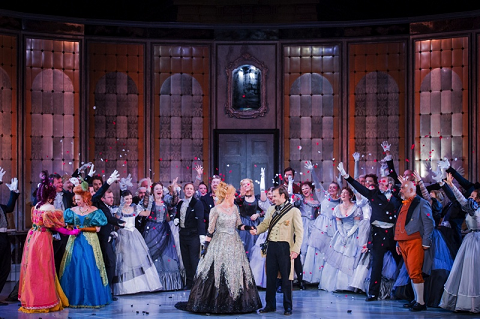 The Ball Scene. Photo Credit: Robert Workman.
The Ball Scene. Photo Credit: Robert Workman.
Maltese tenor Nico Darmanin had enough agility to leap up on high, but not a lot of freedom once he’d arrived; he dispatched his Act II showcase aria, ‘Si, ritrovarla io giuro’, confidently, but his is not a very ingratiating tone. Darmanin was proficient but a bit charmless for Prince Charming.
Barnaby Rea used his resonant bass well as the philosopher Alidore who serves as both tutor to Ramiro and fairy-godmother to Angelina. His one aria ‘La del ciel nell’arcano profondo’ was competent though the intonation strayed at times.
As the ‘ugly’ sisters - who are in fact ‘beautiful’ of voice and visage, but certainly not of virtue and moral compass - soprano Fleur de Bray and mezzo-soprano Heather Lowe were excellent as Cinders’ stepsisters, Clorinda and Tisbe respectively.
Vocally, the ensemble pieces - the Act 1 quintet and Act 2 sextet - didn’t quite hit the musical peaks, although there was some lovely sotto voce singing in the latter to express the collective incredulity and bewilderment as Cenerentola’s real identity is revealed. But, minor caveats aside, this is a terrific production. In unsettled times, we all need to be reassured that it’s still possible, to paraphrase the opera’s subtitle, for Virtue to triumph. Rossini may not give us a fairy-godmother, but if your heart and hopes need a bit of a boost, this show will wave a magic wand.
This production of La Cenerentola is a co-production with Danish National Opera. It will tour in Denmark from 7 October 2016 until 3 December 2016. For more information see this link.
Claire Seymour
Rossini: La Cenerentola
Angelina - Victoria Simmonds, Prince Ramiro - Nico Darmanin, Dandini - Nicholas Lester, Don Magnifico - Jonathan Veira, Alidoro - Barnaby Rea, Clorinda - Fleur de Bray, Tisbe - Heather Lowe Conductor - Dane Lam, Director - Oliver Platt, Designer - Neil Irish, Lighting Designer - Mark Jonathan, Movement Director - Emma Brunton, Chorus Master - Harry Ogg, City of London Sinfonia and Opera Holland Park Chorus.
Opera Holland Park, London; Thursday 14th July, 2016.
image=http://www.operatoday.com/Angelina%2C%20Ramiro%2C%20Dandini%2C%20Magnifico%20credit%20Robert%20Workman.png image_description=La Cenerentola, Opera Holland Park product=yes product_title=La Cenerentola, Opera Holland Park product_by=A review by Claire Seymour product_id=Above: Victoria Simmonds (Angelina), Nico Darmanin (Ramiro), Nicholas Lester (Dandini), Jonathan Veira (Don Magnifico).Photo credit: Robert Workman.
July 13, 2016
A New Opera Company with a True Story of Forbidden Love
Only after that deciding on it's opening opera, did company executives learn of a bittersweet relationship between the mother of Charlottesville citizen Mary (aka Marie-Therese von Degenfeld) Miller and the librettist. Mary grew up in Europe, but married an American diplomat and eventually moved to Yule Farm, just outside of Charlottesville.
Mary’s mother, German Countess Ottonie von Degenfeld, met the librettist at Neubeuern Castle in Southeast Bavaria in 1906. She must have impressed him deeply, because two years later he wrote, “Although I only met her one day in my life, my thoughts kept returning to her.” Ottonie was a widow, but Hofmannsthal was married so the countess kept the correspondence they exchanged a secret up until 1912. It was only after Ottonie’s death in 1970 that Mary found the letters, carefully bound in blue ribbon, among her mother’s papers. By that time von Hofmannsthal’s artistically important letters had already been published.
What the new discovery tells us is that Ottonie was the librettist’s muse during the time he was working on Der Rosenkavalier. Much of what he wrote about the Marschallin and Octavian may have been inspired by his dreams of the lovely countess. He definitely tried to relieve the pain she felt because of the loss of her husband. She was depressed and he tried hard to bring her out of it by his expressions of devotion to her and his recommendations of reading material. They did meet at other times, sometimes on trains, but those assignations had to be short and discreet.
Hofmannsthal tried hard to convince Ottonie to attend the world premiere of Der Rosenkavalier on January 26, 1911, in Dresden, but she did not appear. He left tickets for her at the box office many times after that and she finally did attend a performance, unescorted. He also saw that when she returned to her hotel room it was full of roses. Although the librettist’s shy muse would remain unknown for many years after Dresden, Der Rosenkavalier was soon on its way to becoming a valuable part of the operatic repertoire.
Victory Hall Opera offers a pioneering new model for an opera company. It places the creative reins in the hands of the one who knows opera best: the singer. By featuring a core ensemble of exceptional masters of their craft, this company endeavors to develop a new opera aesthetic resulting in performances that are personal, vital, and relevant to every member of the audience.
"Victory Halls" were community theaters built all over the world after WWI to encourage touring musicians to perform concerts in regional towns. Victory Hall Opera harkens back to this time and seeks, once again, to bring the best the opera world has to offer back home to Charlottesville, VA.
Co-founders of Victory Hall Opera are: Maggie Bell, Miriam Gordon-Stewart and Brenda Patterson. Charlottesville native Maggie Bell worked extensively in opera productions throughout the United States before becoming the dramaturg at Berlin’s Volksbühne. Internationally acclaimed Australian soprano Miriam Gordon-Stewart, who specializes in the music of Wagner and Strauss, gained recognition across four continents for her powerful voice and dramatic ability. Virginia-raised mezzo-soprano Brenda Patterson is noted for her roles in contemporary American opera. She spent several years at Hamburg State Opera before continuing at La Scala and the Metropolitan Opera.
About the premiere performances:
Victory Hall Opera presents a chamber version of Someone Younger (Der Rosenkavalier) on August 14, 17, and 20 at The V. Earl Dickinson Theater, Piedmont Virginia Community College, 501 College Drive, Charlottesville, VA. For more information, please visit www.victoryhallopera.org.
Maria Nockin
References:
[1] The Poet and the Countess: Hugo von Hofmannsthal’s Correspondence with the Countess Ottonie von Degenfeld. Edited by Marie-Therese Miller-Degenfeld. Camden House, 2000. Hugo von Hofmannsthal letters to Ottonie Gräfin von Degenfeld-Schonberg and Julie Freifrau von Wendelstadt, 1908-1918.
[2] Memoirs of Marie Therese Miller-Degenfeld, An International Life in the 20th Century. Marie-Therese Miller-Degenfeld. Trafford, 2006.
image=http://www.operatoday.com/SomeoneYoungerCropped.png image_description=Someone Younger [Image courtesy of Victory Hall Opera] product=yes product_title=A New Opera Company with a True Story of Forbidden Love product_by=By Maria Nockin product_id=Above: Someone Younger [Image courtesy of Victory Hall Opera]July 9, 2016
Il trionfo del tempo e del disinganno in Aix
The Triumph of Time and Disillusion was composed in 1707 in Rome by the 22 year-old German composer Georg Friedrich Händel. Opera was banned in Rome, the pontifical city firmly in the grips of the artistic terrors of the Counter Reformation, i.e. opera was banned. So Rome, never left wanting for the finer things, was reduced to bootleg opera, called oratorio. Some of its librettos were supplied by Cardinal Benedetto Pamphili (quite a few of his librettos not surprisingly are about Mary Magdalene). Note that Alessandro Scarlatti set the Cardinal’s The Triumph of Truth and Grace a few years before Händel tackled that of Time and Disillusion.
Just like opera seria, distraught with the terrors of its heroes and heroines vacillating between inexorable forces (love and duty mostly), Roman oratorio provided polar opposing forces (pleasure versus truth as example) with no possible compromise. In the early 18th century resolution could only be death in opera seria while in oratorio the resolution was eternal life. Once the Counter Reformation dissipated opera seria did begin finding happy endings here on earth.
In the program booklet Polish theater director Krzysztof Warlikowski expresses his outrage at the dogmatism of this libretto (Time and Disillusion [essentially Truth] banish Pleasure while Beauty repents). With the orchestral overture stage director Warlikowski concocted on a full stage video scrim (screen) the sordid world of drugged youth’s indiscriminate sexual appetites. On stage for the next three hours a beautiful young woman struggles to emerge from this world. Bludgeoned by Truth she gives in to repentance. But, like opera seria where there is no eternity we watch her symbolically die. It is spiritual death at the hands of dogmatism.
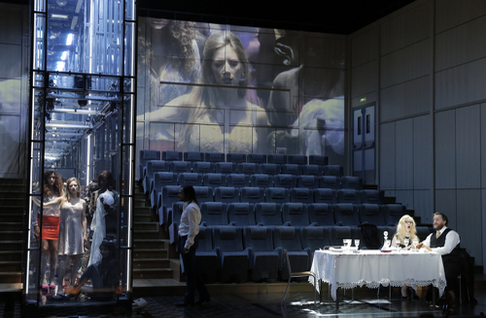 Beauty (in box), Pleasure (in shadow), Truth and Time (at table)
Beauty (in box), Pleasure (in shadow), Truth and Time (at table)
Watching this were 1500 or so mostly Christian souls seated in Aix's bishops' palace (the Archevêché) facing the stage that was in fact a theater staring directly back at us, i.e. mirroring us. From time to time a bevy of young women in lurid party attire emerged from a transparent box (surely an abstracted disco-tech) to file into these stage seats to watch with us the battle taking place on the stage apron.
Like Warlikowski the young Handel was entranced by this battle and thus gave it the most beautiful music ever composed for the human voice. Time stood still while we reveled in beauty. Truth and pleasure fused into that sublime moment that was only dreamt of on the stage by Beauty. It was the triumph of art.
Director Warlikowski did take a moment to remind us that all of this artistic grandiosity is a bit silly. This was the intermission feature. Once again the full stage scrim fell and we watched a video of a most worldly man in supercilious discussion with a most wide-eyed young woman about ghosts (this video a comment on Pleasure’s just uttered fear that Beauty would believe in the purely imaginary heroes of truth, i.e. ghosts). [No doubt the actors were well known to the largely French audience, I had no clue].
Once again in this summer’s Festival, Aix has triumphed in its casting. Beauty was young French soprano Sabine Devielhe of pristine physical beauty, her face marred by clown face tears. She possesses a voice of riveting purity, platinum colored (i.e. an extravagant silver), a range that extending well above the staff upon occasion. Her final aria of repentance was spellbinding (as were all of her arias) in the splendid bleakness of its despair.
Matching in effect was a sassy Pleasure, sung by Argentine counter tenor soprano Franco Fagioli who as well soared above the staff in his final aria of banishment. Leaning against the transparent box he sank to the floor delivering wrenching tones of tragic loss, descending well below middle “C” into tenor range though never losing counter tenor color. The brash young Handel demanded the ultimate from his opera seria singers, the high Baroque in full force. This Trionfo's arias exploited the extremes of range and demands on technique that are seldom encountered in his London operas.
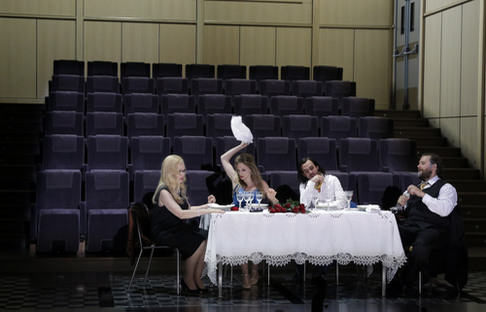 Sara Mingardo, Sabine Devielhe, Franco Fagioli, Michael Spires
Sara Mingardo, Sabine Devielhe, Franco Fagioli, Michael Spires
American tenor Michael Spires showed off his resplendent tenorino as Time, bringing throaty authority to his tone, soaring to threatening insistence in his high “D”’s. He was dramatically matched by the powerful voice of Italian contralto Sara Mingardo who brought a blatant irony of false authority to Disinganno (Truth), the attribute that so intrigued stage director Warlikowski.
All four singers converged in the magnificent quartet early in the second act that were it more widely known by the opera public would be known as one of the great monuments of operatic quartets, rivaling, even surpassing the rank and fame of the Rigoletto quartet.
Of equal stardom in this extraordinary evening was the French early music orchestra Le Concert d’Astrée and particularly its founder and leader Emanuelle Haïm whose sculpted conducting forcefully and fully rendered the muscular, quite architectural components of Handel’s Baroque orchestral score. Of deep complicity were the several duets that violinist David Plantier, cellist Felix Knecht and oboist Patrick Beaugiraud effected with the singers. The large, un-conducted continuo offered kaleidoscopic colors to the recitatives and scenes, recalling somewhat the concept of Monteverdian and Gluckian accompanied speech.
See for yourself — Il Trionfo del Tempo e del Disinganno on www.culturebox.fr.
Michael Milenski
Cast and production information:
Bellezza: Sabine Devieilhe; Piacere: Franco Fagioli; Disinganno: Sara Mingardo; Tempo: Michael Spyres. Orchestra: Le Concert d’Astrée. Conductor: Emmanuelle Haïm;
Mise en scène: Krzysztof Warlikowski; Sets and costumes: Malgorzata Szczesniak;
Lighting: Felice Ross; Chorégraphie: Claude Bardouil; Vidéo: Denis Guéguin. Théâtre d’Archevêché, Aix-en-Provence, July 6, 2016)
image=http://www.operatoday.com/Trionfo_Aix1.png
product=yes
product_title=The Triumph of Time and of Disillusion
product_by=A review by Michael Milenski
product_id=Above: Sabine Devieilhe as Beauty [All photos copyright Pascal Victor / Artcomart courtesy of the Festival d'Aix]
July 5, 2016
Pelleas et Mélisande in Aix
It was inevitable. The Aix Festival has been grooming British theater director Katie Mitchell to take on the foggy atmospheres of this Debussy thriller for years. Dinner table after dinner table, bedroom after bedroom, slick theater to be sure (Written on Skin [2012], The House Taken Over [2013], Trauernacht [2014], Alcina [2015]), Mme. Mitchell is greatly admired for finding all human tension to be present in a domestic tea service.
Pelleas et Mélisande is undoubtably meant to be her masterpiece. She found Maeterlinck’s murky, hazy universe in the dream, rather nightmare of a bride alone in a hotel room. It was not always clear how these pre-conscious meanderings fit together (but of course the first thing you learn about dreams is that they don’t and that’s the fun). Like Maeterlink’s Mélisande we did not know how or why this bride got there. But there she was, center bedroom in her dream for three and one half hours (yes, right there for every second of those long, very long hours).
Given it was the Mélisande psyche that imagined her own particular universe she was rather more pro-active than Maeterlinck’s symbolic lost soul. Mme. Mitchell’s Mélisande made the men in her life react to her and watched the men in her life react to her (she was a double image [yes, there were two of them], herself and she who sees herself). It is possible, maybe probable that the three men in her dream [Arkel, Pelleas and Golaud] were all one man — her absent groom, and maybe there never was one anyway.
Certainly Mme. Mitchell with her dramaturg, Martin Crimp had all this worked out to the nth detail. Mme. Mitchell’s universe is very precise indeed. Including the a vista genitalia of Pelleas.
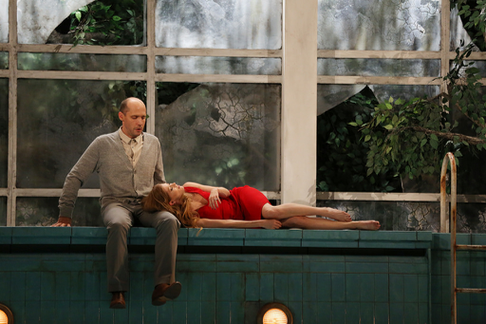 Stéphane Degout as Pelleas, Barbara Hannigan as Mélisande
Stéphane Degout as Pelleas, Barbara Hannigan as Mélisande
The greatest of the many glories of the Aix Festival (besides, well, going for broke in many of its stagings) is the casting. Shapely Canadian soprano Barbara Hannigan was the Mélisande (the one who sang), existing much of the evening in her bra and panties, executing some spectacular physical theater moves from time to time (among other impressive accomplishment by Mme. Mitchell’s movement collaborator Joseph W. Alford), like a backwards summersault that left her contorted derrière aloft for extended moments, jumping animal-like onto Golaud’s back, etc. Her light and bright soprano illuminating her dreams in perfect French with impeccable musicianship. A total, spectacular performance.
Matched in every way by the Pelleas of French baritone Stéphane Degout and the Golaud of French bass-baritone Laurent Naouri. Both artists are of similar physical types that could make believable Maeterlinck’s half-brothers. Very male, handsome and physically fit both men were vocally very fit as well, the dark hued voice of Pelleas well able to scale the extreme range and emotional heights of this enigmatic force (Mme. Mitchell endowed him with the autistic nervous tic — at least in Melisande’s perception). Golaud in a black hued voice exuded every excited nuance of Maeterlinck’s most human and balanced and obsessive male force, creating in this staging finally a beautifully sculpted, deep and very moving pathos.
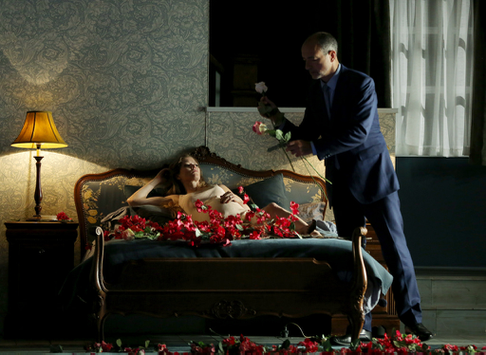 Barbara Hannigan as Mélisande, Laurent Naouri as Golaud
Barbara Hannigan as Mélisande, Laurent Naouri as Golaud
Parallel to Mme. Mitchell’s dream was Esa-Pekka Solonan’s descent into the sonic depths of Debussy’s masterpiece of orchestration. London’s Philharmonia Orchestra is one of the world’s fine ensembles, well able to manufacture a suave elegance for Debussy’s woodwinds, well able to ascend gracefully to fortissimo heights, and achieve shattering moments with no loss of sonic composure. It was an absolutely magnificent orchestral evening, seats in the mid section of the flawed Grand Théâtre de Provence offering a balanced if sometimes harsh sound, the voices on stage disarmingly amplified by the round shape of the theater.
The Philharmonia Orchestra is known for the warmth of its strings, and indeed they are, and the elegance of its winds. Conductor Salonen finds everything he needs to create the frigid warmth of his symphonic sound. His operatic emotions are well defined and highly considered, his great big moments are absolutely contained. Salonen’s lush symphonic poem ignored the unanswered questions and the mysteries of the story, remaining abstractly one dimensional.
This gifted maestro did not seem to care what occurred in those little scenic boxes up there on the stage. Nor did many of us.
Michael Milenski
Cast and production information:
Pelléas: Stéphane Degout; Mélisande; Barbara Hannigan; Golaud: Laurent Naouri; Arkel: Franz Josef Selig; Geneviève: Sylvie Brunet-Grupposo; Yniold: Chloé Briot; Le Médecin: Thomas Dear. Cape Town Opera Chorus (unseen). Philharmonia Orchestra. Conductor: Esa-Pekka Salonen; Mise en scène: Katie Mitchell; Décors: Lizzie Clachan; Costumes: Chloé Lamford; Lumière: James Farncombe. Grand Théâtre de Provence, Aix-en-Provence, July 4, 2016.
image=http://www.operatoday.com/Pelleas_Aix1.png
product=yes
product_title=Pelleas et Mélisande at the Aix Festival
product_by=A review by Michael Milenski
product_id=Above: (bottom to top) Melisande double, Laurent Naouri as Golaud, Barbara Hannigan as Melisande [All photos by Patrick Berger / Artcomart, courtesy of the Aix Festival]
Siegfried, Opera North
Perhaps I shall find out some day how it all turned out. Very well, I should expect, at least performatively. For, if I did not find that this Siegfried quite attained the heights of the Walküre two nights previously, Opera North’s remained an achievement that put a good number of larger companies to shame.
It helped, of course (to put it mildly!) to have Richard Farnes continue his excellent work, not in the pit, but at the podium. As with the Walküre, I found some of the first act a little on the subdued side, the music only really igniting during the final scene, and only truly blazing with the extraordinary Second Act Prelude, in which the Orchestra of Opera North once again showed that it had nothing to fear from the most exalted of comparisons. Perhaps that is Farnes’s way, wanting to leave something in reserve. However, in this particular drama, especially when seen and heard without a full staging, something more immediately arresting would not have been a bad thing. I also felt that the intensity of the third act might have been more consistently maintained. It was certainly not a case of failing to understand, or indeed to communicate, its contours. However, between the Prelude to the Third Act - the Prelude to the Ring’s very peripeteia - and a shiver-inducing final duet, there was, at least for my taste, perhaps a little too much placidity. That said, Farnes’s conducting and the orchestral playing will, I am sure, long be spoken of warmly, both in London and in the earlier venues of the Opera North tour.
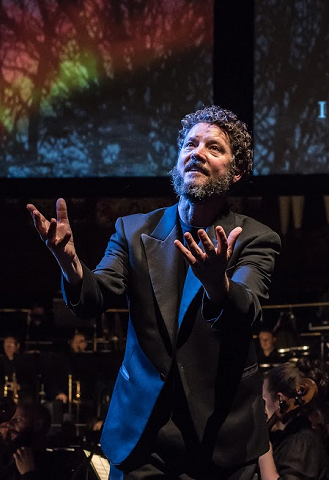 Richard Roberts as Mime. Photo Credit: Clive Barda.
Richard Roberts as Mime. Photo Credit: Clive Barda.
Béla Perencz’s Wanderer sounded suitably resigned, without that implying any lack of attention to the particularities of words and music. If I have heard more imposing portrayals, there was a humanity here that most would have warmed to - and I did. Jo Pohlheim’s Alberich was a definite strength of the Rheingold three nights earlier, and so again it was here. Less pitch-black than some, this was a dwarf who very much retained character of his own. So too did Richard Roberts’s Mime, especially noteworthy for fine acting within the constraints (or should that be liberation?) of a ‘concert staging’. Mats Almgren proved a properly stentorian Fafner. Lars Cleveman offered laudable staying power in the title role, at least until the earlier stages of the final scene. (It is quite understandable that he should have been tiring then!) However, his voice was decidedly less than ingratiating; such, alas, is the way with almost all Siegfrieds. It was nevertheless a committed performance, and that is worth a good deal. Ceri Williams’s Erda was again somewhat insecure. However, the other two ‘female’ roles were superbly taken, Jeni Bern a veritable breath of fresh air as a lively Woodbird, and Kelly Cae Hogan fully living up to the promise of her Walküre Brünnhilde in a blazing performance at the close. Again, if only I knew how it all turned out …
If only the nuances of verbal meaning had not too often been ironed out in translation. (Sometimes, it was spot on; at other times, overly generalised. Surely Wagner’s poems deserve near-literal translation in such circumstances, for this was not a singing translation. Fafner’s Proudhonian ‘Ich lieg’ und besitz’ loses far too much, indeed almost everything, as ‘What’s mine is mine’. Possession, one might say, is if not nine tenths, then at least half, of the rentier meaning. But such niggles, and ongoing concern-cum-irritation over increasingly screensaverish projections, remained just that, niggles, in the face of Opera North’s magnificent achievement. More Wagner soon, please!
Mark Berry
Richard Wagner, Siegfried
Siegfried: Lars Cleveman; Mime: Richard Roberts; The Wanderer: Béla Perencz; Alberich: Jo Pohlheim; Fafner: Mats Almgren; Erda: Ceri Williams; Brünnhilde: Kelly Cae Hogan; The Woodbird: Jeni Bern. Concert Staging, Design Concept, Lighting, Projection: Peter Mumford; Associate Director: Joe Austin. Orchestra of Opera North/Richard Farnes. Royal Festival Hall, London, Friday 1 July, 2016.
image= http://www.operatoday.com/The%20Ring%20-%20Siegfried%2003.png image_description=Siegfried, Opera North product=yes product_title=Siegfried, Opera North product_by=A review by Mark Berry product_id=Above: Béla Perencz as Wanderer and Ceri Williams as Erda
Photo credit: Clive Barda.
July 4, 2016
Götterdämmerung, Opera North
Peter Mumford, who tackles staging, design, concept, lighting and production, emerges triumphant. The three huge screens behind the orchestra are multi-function, translating the text, giving stage directions to help along the theatre of the imagination, and conjuring up a multitude of natural images, often of a primordial slant as befits atemporal myth, from forest scenes to well-timed ravens. Opera North’s Ring is also an immersive experience, with a plethora of satellite events. Particularly enjoyable amongst these for this final instalment was a talk on The top five things you need to know about tonight’s instalment in the Clore Ballroom which at one point had the audience, sitting in a pretend forest, hollering out the braying horns of the vassals.
Held in the current atmosphere of political uncertainty, aspects of Wagner’s Ring become naturally highlighted (particularly the back-stabbing, literal in Siegfried’s case). Yet Wagner’s genius towers over and cuts through such local concerns, his over-reaching vision sucking us into this dark World inexorably. Richard Farnes guides us through Wagner’s huge score expertly. His conducting style is precise, never over-emotive; the smallest gesture seems to register on his players, and there is a true sense of flow to his conducting. While I enjoyed Das Rheingold (the only other of the four I was able to catch), it was eclipsed by some way here. Farnes is not one to dawdle, yet the result is forward movement rather than rushed; the bright orchestral sound for Siegfried’s Rhine Journey seemed exactly right, and while the final act Funeral March was fluent, it held great dramatic weight. Farnes encouraged the best from his brass players, too, the great, trill-encrusted crescendo preceding Siegfried’s second act entrance a case in point.
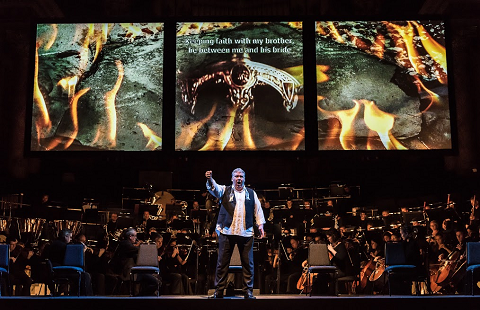 Mati Turi as Siegfried. Photo Credit: Clive Barda.
Mati Turi as Siegfried. Photo Credit: Clive Barda.
Interesting to see that First Norn was Yvonne Howard, who had so successfully taken the role of Fricka in the Rheingold. Actually, all three Norns were cast from strength, their voices very different, three distinct characters weaving the rope of destiny, entering clad in black veils, re-veiling themselves once the singing was over. The orchestra’s radiant Dawn led naturally to Siegfried and Brünnhilde’s massive duet. The Siegfried here was Mati Turi (Lars Cleveman had taken the role for Siegfried itself), a singer with a strong low register, and a top that can stand its own against a Wagnerian orchestra. His retelling of the story in the final act was his high-point. Yet his delivery did seem to be all at around the same dynamic level, with occasional forays from the prevailing forte to a fortissimo. His Brünnhilde, Kelly Cae Hogan, was more than his equal, her “O heilige Götter!” splendidly done, sailing easily over the orchestra, her final high C of the Prologue truly spine-tingling. She was perfectly chosen: it is Brünnhilde who closes the entire cycle (bar a couple of words from Hagen, of course) and Hogan was fully in her element and in her voice. Right from the off, her voice was fully open and free. This was a major assumption of the role, culminating in a beautifully variegated “Immolation”. Her voice piercing through the orchestra like a crystal point, she found real beauty in those final stages, the lower part of her voice as she seems to imitate Erda (“Alles Weiss ich”) wonderful; and just as wonderful that she still had that openness of voice for “Fliegt Heim, ihr Raben”. Throughout this final twenty minutes or so, Hagen’s reactions as he hovered at the side of the stage were cherishable. The music-drama ended, as is appropriate, with the orchestra bathed in golden light.
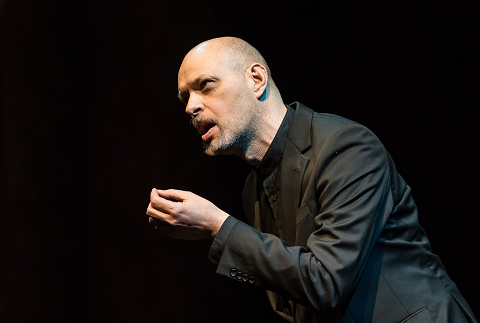 Mats Almgren as Hagen. Photo Credit: Clive Barda.
Mats Almgren as Hagen. Photo Credit: Clive Barda.
Interesting that the singer who was Gunther had taken the role of Donner on opening night, the latter a far smaller part. Here, Andrew Foster-Williams was finally able to showcase his large voice; perhaps his Gutrune, Giselle Allen, was a little weak vocally initially. Another familiar face from Rheingold was Jo Pohlheim’s Alberich, well characterised but perhaps not as black of timbre as one might hope for this role. Mats Almgren (Fafner on opening night) was a terrific Hagen: his Watch (“Hier sitzt ich zur Wacht”) was dramatic, although again one has heard darker voices here. Almgren’s power was never in doubt, though, and the Alberich/Hagen interactions in the second act carried great weight.
One of the finest assumptions of the afternoon/night was Heather Shipp’s Waltraute, her Narration (“Höre mit Sinn”) finding the bull’s eye of Wagnerian concentration; later in the act, she actually sounded believably furious. One must not forget (how could anyone?) the Chorus of Opera North, powerful beyond belief at times; and yet capable of infinite tenderness (“Heil dir Gunther”, in the second act). The Rhinemaidens, counterbalancing perhaps the Norns, made a beautiful appearance in the final act.
And so the great cycle came to a conclusion, the enthusiastic standing ovation completely justified. A magnificent achievement.
Colin Clarke
Wagner: Götterdämmerung (Concert Performance)
Brünnhilde - Kelly Cae Hogan; Siegfried - Mati Turi; Hagen - Mats Almgren; Giselle Allen Gutrune; Gunther - Andrew Foster-Williams; Waltraute - Heather Shipp; Alberich - Jo Pohlheim; 1st Norn - Fiona Kimm; 2nd Norn - Yvonne Howard; 3rd Norn - Lee Bisset; Woglinde - Jeni Bern; Wellgunde - Madeleine Shaw; Flosshilde; conductor - Richard Farnes, Orchestra of Opera North.
Royal Festival Hall, London, 3rd July 2016.
image= http://www.operatoday.com/The%20Ring%20-%20G%C3%B6tterd%C3%A4mmerung%204.png image_description=Götterdämmerung, Opera North product=yes product_title=Götterdämmerung, Opera North product_by=A review by Colin Clarke product_id=Above: Andrew Foster-Williams as Gunther and Giselle Allen as GutrunePhoto credit: Clive Barda
Le nozze di Figaro, Glyndebourne
Set in 1960's Seville, the production is designed by Christopher Oram with lighting by Paule Constable, and featured Gyula Orendt as Count Almaviva, Golda Schultz as Countess Almaviva, Davide Luciano as Figaro, Rosa Feola as Susanna, Natalia Kawalek as Cherubino, Carlo Lepore as Bartolo, Susan Bickley as Marcellina, John Graham-Hall as Don Basilio, Nicholas Folwell as Antonio, Alasdair Elliott as Don Curzio and Nikola Hillebrand as Barbarina. Jonathan Cohen conducted the Orchestra of the Age of Enlightenment.
In an article in the programme book Michael Grandage explained that the 1960's setting for the production came about partly because they were looking for a suitable milieu in which it would be possible for the Countess and Susanna to convincingly swap clothes. Peter Schlesinger's photographs of the beautiful people of the late 1960's provided the inspiration. Another given was the intention to have the action set just in the single day specified in the libretto, so Christopher Oram's designs pair a massive, ancient-looking Moorish palace on a revolve with 1960s people, the whole flowing beautifully from the opening when the Count and Countess arrive early morning during the overture, to the finale in the darkened garden.
I had seen the production when new, when it came to the BBC Proms and also caught it on television, but this was the first time that I had seen it at Glyndebourne. The advantage of the production is manifestly the great beauty of the sets, the lovely contrast between the Moorish-inspired architecture and the 1960s costumes, and the remarkably detailed personen-regie ensuring that the characters were both brilliantly realised and finely in period. And it was both very funny and rather touching.
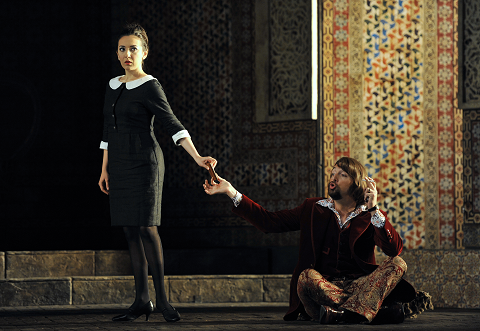 Le nozze di Figaro, Glyndebourne Festival 2016. Susanna (Rosa Feola) and Count Almaviva (Gyula Orendt). Photographer: Robbie Jack.
Le nozze di Figaro, Glyndebourne Festival 2016. Susanna (Rosa Feola) and Count Almaviva (Gyula Orendt). Photographer: Robbie Jack.
My biggest problem with the production remains the depiction of the Count (Gyula Orendt): a selfish playboy prone to bouts of jealousy, he just didn't seem to inspire the sort of fear that would seem to be needed to make the other characters' behaviour believable. A telling point at the performance was that when Orendt's Count went down on one knee at the end of Act Four to beg forgiveness of the Countess (Golda Schultz), there was a small but distinct titter from the audience. In 1960s guise, with his red velvet jackets and tendency to start jiving, this conception of the Count had too many funny moments.
But thinking about the production, as the performances from Davide Luciano as Figaro, and Rosa Feola as Susanna were so strong, it was as if Michael Grandage and Ian Rutherford were refocussing the dramaturgy slightly, making the servants the stronger, more dominant characters as the feckless aristocrats play on around them.
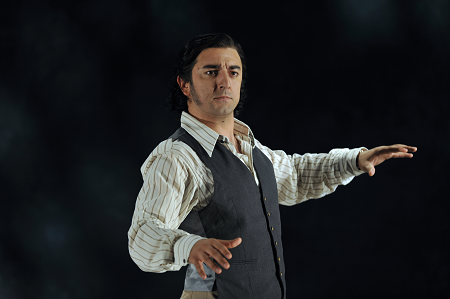 Le nozze di Figaro, Glyndebourne Festival 2016. Figaro (Davide Luciano). Photographer: Robbie Jack.
Le nozze di Figaro, Glyndebourne Festival 2016. Figaro (Davide Luciano). Photographer: Robbie Jack.
It helped that both Luciano and Feola are native Italian speakers, so that the opening scene had great strength and vitality in their use of language. Luciano's strong, rather virile performance reminded me that in the original play Figaro had a number of Revolutionary sentiments (which were stripped out by librettist Lorenzo da Ponte). Here was a Figaro less the charmer and more the schemer, quick to jealousy and full of passion. Luciano's musical performance was to match, singing with a sense of a strong line and with a feeling of suppressed anger. Rosa Feola as Susanna was poised and elegant, again with an inner strength combined with suppleness of line. You felt that Feola could have easily taken on the role of the Countess, and her account of ‘Deh vieni’ gave us some of the finest singing of the evening.
Against this pair, the self-indulgent, rather feckless Almavivas did not stand a chance. Golda Schultz's Countess, floating around in her kaftans, was all elegant charm with no real core to her character. Schultz sang warmly vibrant voice, drawing on a lovely sense of elegant personality in the recitatives and beguiling as she should. But ‘Porgi amor’ seemed to lack a real sense of line and felt a little too much like a series of isolated, albeit beautiful, notes, though her account of ‘Dove sono’ had a touching melancholy about it. Gyula Orendt's Count was beautifully sung, within the confines of the character as conceived in this production. Orendt could spin a beautiful line, yet also be quick to anger and his pacing of the long comic scene which ends Act Two was simply brilliant.
Natalia Kawalek was a piece of relatively late casting as Cherubino. Kawalek made a wonderfully convincing youth, and her impulsively sulking performance really helped ground the drama in the naturalism which Grandage clearly desired. Musically she seemed to take some time to warm up, and ‘Non so piu’ seemed to lack the sort of relaxed refulgence of tone which is ideal in this role, though ‘Voi che sapete’ was sung with great charm.
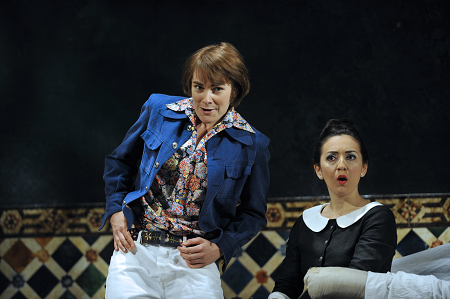 Le nozze di Figaro, Glyndebourne Festival 2016. Cherubino (Natalia Kawalek) and Susanna (Rosa Feola). Photographer: Robbie Jack.
Le nozze di Figaro, Glyndebourne Festival 2016. Cherubino (Natalia Kawalek) and Susanna (Rosa Feola). Photographer: Robbie Jack.
Carlo Lepore was a striking Don Bartolo, rather slickly untrustworthy yet touching when he discovers Figaro is his son. Susan Bickley made a delightful Marcellina, matronly but elegant and full of character, it was a shame that we did not get her aria. Neither did John Graham-Hall's oily Don Basilio get his aria, though Graham-Hall was a complete delight as this odious character. Nikola Hillebrand was a leggily elegant Barbarina, cavorting with Natalia Kawalek's Cherubino and singing her Act Four aria with poise.
The smaller roles were all strongly taken with Alasdair Elliott as Don Curzio, Nicholas Folwell as Antonio, and Julia Hamon and Alison Langer as the bridesmaids. Like the rest of the cast, the chorus clearly had great fun with the 1960s visual details of the production, and helped to bring the ensemble scenes alive. Though I have to confess that I found the choreography (originally by Ben Wright and revived by Kieran Sheehan) relied a little too much on fitting 1960s dance moves to period music, a trope that can easily weary.
From the opening notes of the overture, Jonathan Cohen and the Orchestra of the Age of Enlightenment gave us a crisply vivid account of the score. Cohen used the period instruments to keep the textures light, yet vivid, and to allow the music to move without seeming overly rushed. Individual numbers were shaped finely, but there was an over-arching sense to the performance too, matching Grandage's desire to have the action move seamlessly through the day. There was some lovely continuo playing from Ashok Gupta (forte piano) and Jonathan Manson (cello), responsive and imaginative without overly drawing attention to itself.
All concerned brought out that combination of pathos, humour and tragedy which is the work's hallmark, and if the great moments did not quite move us as much as they could, overall this was a vividly engaging production, with a cast of beautifully realised characters.
Robert Hugill
Mozart: Le nozze di Figaro
Figaro: David Luciano, Susanna: Rosa Feola, Count Almaviva: Gyula Orendt, Countess Almaviva: Golda Schultz, Cherubino: Natalia Kawalek; director: Michael Grandage, conductor: Jonathan Cohen, revival director: Ian Rutherford, designer: Christopher Oram, lighting: Paule Constable, Orchestra of the Age of Enlightenment.
3 July 2016, Glyndebourne Festival Opera
image=http://www.operatoday.com/Le%20nozze%20di%20Figaro%2C%20Act%20III%2C%20Photographer%20-%20Robbie%20Jack.png
image_description=Le nozze di Figaro , Glyndebourne Festival Opera
product=yes
product_title=Le nozze di Figaro, Glyndebourne Festival Opera
product_by=A review by Robert Hugill
product_id=Above: Le nozze di Figaro, Act III
Photo credit: Robbie Jack.
July 2, 2016
Cosi fan tutte at the Aix Festival
Nothing held back, whites raped and brutalized and humiliated blacks in this witty comedy, here moved from the Bay of Naples to the African city Asmara (Mussolini’s new Rome) in Eritrea [a small state that won its independence from Italy’s former colony, Ethiopia in 1991].
Geography apart it was dimly lit comedy —hazy, sinister foreign atmospheres carefully calculated by lighting designer Dominique Bruguière (whose most recent project in Aix was Chéreau’s Elektra). French film set design/decorater Alban Ho Ban created Roman comedy’s cross streets for the first act — a shop front on a huge mud façade, probably a fort, the garrison of Italian soldiers. The final act took place inside the fort in a sort of distressed, mud colored courtyard, Italian flag limply hanging.
However the collaborator most responsible for abusing our sensibilities was conductor Louis Langrée whose overture to Da Ponte’s comedy resonated with the brutality on the stage (soldiers raping a black woman), not to mention the maestro’s very willing collaborators, the magnificent Freiburger Barockorchester whose antique tonalities shouted the roughness and the darkness of the stage atmospheres.
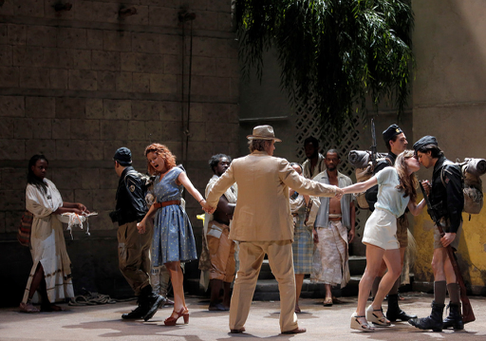 left to right Guglielmo (mostly hidden), Fiordiligi, Don Alfonso, Dorabella, Ferrando
left to right Guglielmo (mostly hidden), Fiordiligi, Don Alfonso, Dorabella, Ferrando
The stage was rude and angry, two simple girls of their time and place, daughters of Italian colonists. Hardly polished examples of a master race, rather they were crude and tarnished examples of humankind’s totem of purity. Conductor Langrée and Kate Lindsey’s Dorabella made “Smanie implacabili” an explosion of ugly sentiment. There was no applause. Rod Gilfrey’s Don Alfonso with Lenneke Ruiten’s Fiordiligi and Dorabella moved as a menacing phalanx towards the audience in a dark and flatly sung “Soave sia il vento,” Mozart’s gentle reverie becoming an anthem to a lost humanity. There was no applause.
And it went from there, stage director Christophe Honoré plumbing the depths of wit, character perception and subtlety in his complex and thorough staging. Only to mention the virtual rape of a handsome noir by Fiordiligi and Dorabella in “Prenderò questo brunettino/Ed intanto io col biondino” and the morphing of Mozart’s more subtle racism (Turks) into blackface. The blond and brunette had become two very black African soldiers [in historical fact the occupying Italian fascist forces employed black mercenaries].
Bass [!] Nahuel di Pierro’s Guglielmo, often accompanied by two thugs (a blanc and a noir), made a tough guy match for rough and nasty Dorabella. Tenor Joel Prieto’s Ferrando who in the first act pressed his uniform on a period (‘30‘s) ironing board before marching off to the feigned war showered a vista before his second act seduction of Fiordiligi, his bronze blackened body reflecting golden light.
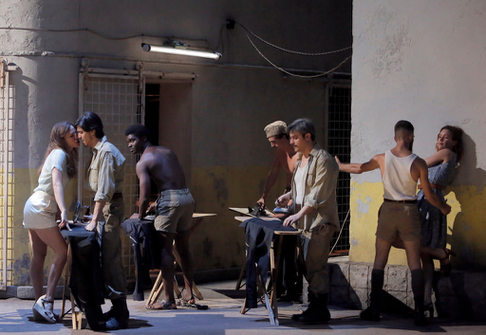 Dorabella and Ferrando (left), Guglielmo, supernumerary and Fiordiligi (right)
Dorabella and Ferrando (left), Guglielmo, supernumerary and Fiordiligi (right)
Above all else was conductor Louis Langrée plumbing the depths of Mozart’s score, finding, amplifying everything we saw on the stage, including — and most of all — the sublime moment when Fiordiligi knew she loved the black soldier, not the white one. This is when the Freiburger Barockorchester took us to a transcendental place we never knew or even suspected existed in this far-fetched, esoteric comedy.
Wow.
Making all this possible was the depth of casting, led by the omnipresence of Rod Gilfry’s Don Alfonso in a tacky white linen suit and fedora. But moreso by the chorus of Cape Town Opera, imported for the occasion, bringing with it the complexities of colonial racism in Africa and indeed racism everywhere.
As a complicit audience we allowed our sensibilities to be exploited. Overheard intermission discussion struggled to make sense of the metaphor and there was offense expressed at the in-your-face exposition of racism. Certainly all of us left the theater more than ever challenged to make sense of art and life.
Still it was Cosi fan tutte, and that means a very long evening of laying out the plot bit by bit and discovering, finally and slowly, its resolution. There were some rough moments between the pit and the stage, the Despina of Sandrine Piau not finding the sense of this music and maybe the production. We may have wished for a stronger portrayal of Fiordiligi, though Mlle. Ruiten did succeed wonderfully in accomplishing the opera’s final redemption.
Michael Milenski
Cast and production information:
Fiordiligi: Lenneke Ruiten; Dorabella: Kate Lindsey; Despina: Sandrine Piau; Ferrando:
Joel Prieto; Guglielmo: Nahuel di Pierro; Don Alfonso: Rod Gilfry. Cape Town Opera Chorus. Freiburger Barockorchester. Conductor: Louis Langrée; Mise en scène: Christophe Honoré; Décors: Alban Ho Van; Costumes: Thibault Vancraenenbroeck; Lumière: Dominique Bruguière. Théâtre de l’Archevêché, Aix-en-Provence, June 30, 2016.
image=http://www.operatoday.com/Cosi_Aix3.png
product=yes
product_title=Cosi fan tutte at the Aix Festival
product_by=A review by Michael Milenski
product_id=Above: Act II, Kate Lindsey as Dorabella and Nahuel di Pierro as Guglielmo plus supernumerary thug, lighting by Dominique Bruguière [All photos copyright Pascal Victor / Artcomart courtesy of the Festival d'Aix]
July 1, 2016
In Parenthesis, Welsh National Opera in London
It’s a troubling question, as Iain Bell’s opera In Parenthesis, presented by Welsh National Opera at Covent Garden the evening before, further underlines. Commissioned to celebrate WNO’s 70th anniversary, Bell’s adaptation of David Jones’ verse-novel In Parenthesis marks this centenary and commemorates the terrible losses among the Royal Welch Fusiliers during the assault on Mametz Wood. Directed by David Poutney, the opera is an act of remembrance which laments losses on all sides, and this is reflected in designer Robert Innes Hopkins’ opening image. Two poppy wreaths lay at the foot of a front-canopy which reads: ‘To the enemy front fighters who shared our pains against whom we found ourselves by misadventure.’
Writer, painting and engraver, David Jones - who was half-English, half-Welsh - was himself a member of the Fusiliers regiment, having enlisted in January 1915. He served on the Western front from December of that year to March 1918. In Parenthesis, first published in 1937 and later described by T.S. Eliot as ‘a work of genius’, fictionalises his experiences and depicts events in the life of a young Private, John Ball, from December 1915 to July 1916, charting his company’s embarkation from England, the trials and horrors of the trenches, and Ball’s involvement in the ill-fated attack on Mametz Wood.
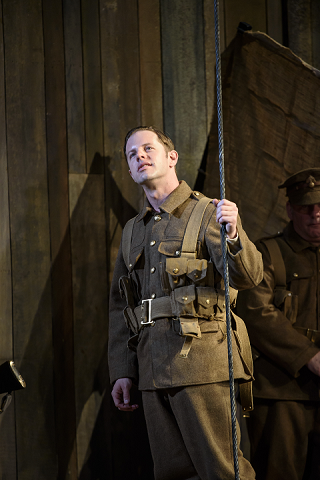 Andrew Bidlack (Private John Ball). Photo credit - Bill Cooper.
Andrew Bidlack (Private John Ball). Photo credit - Bill Cooper.
Jones’ literary epic comprises a blend of free verse and prose; able both to capture its poetry in music and relate its narrative through words, opera seems singularly well-suited to convey the text’s shifting perspectives and often dream-like ambience. Librettists David Antrobus and Emma Jenkins have deftly maintained Jones’s combination of the colloquial with the mythic: ‘Ball is our Orpheus descending into the Wasteland of war and emerging miraculously alive after an ordeal that should have ended in certain death.’
Perhaps, in fact, Bell’s composition is more oratorio than drama. Jones’ text does not have a strong narrative drive but it is infused with Roman Catholic resonances which weave around copious allusions to other literary texts, often centuries old. Antrobus and Jenkins reproduce Jones’ allusive mosaic which mingles fragments from the ancient Welsh heroic epic Y Gododdin, the Song of Roland, Chaucer, Malory’s Morte d’Arthur, Shakespeare’s Henry V, Milton, Coleridge and Lewis Carroll with squaddies’ slang and rugby songs. In the opera, stylised rituals such as the redemptive blessing bestowed by the Queen of the Woods and her attendant dryads sit alongside realist details such as the gleeful unpacking of a Fortnum and Mason’s hamper, which arrives in the trenches to celebrate Commander Jenkins’ 21st birthday and his promotion to Lieutenant. In this way, the human experience of war is seen through a double-lens of distancing myth and intimate actuality.
What the librettists add to the mix is less satisfying. Taking their cue from a later artwork by Jones, Epiphany 1941: Britannia and Germania Embracing (which is dedicated to ‘the enemy front-fighters who shared our pains against whom we found ourselves by misadventure’), they preface the action with an Introduction during which two ‘bards’, Britannia in clerical attire (Peter Coleman-Wright) and Germania in the formal dress of the 1910s (Alexandra Deshorties), take their places before large wooden lecterns and, joined by the female members of the chorus, ask: ‘Do you remember the many men so beautiful who went to war?’ Their question echoes Jones text which itself recalls Coleridge: ‘The many men, so beautiful!/ And they all dead did lie’. These bards - who seem to have strayed in from the set of Britten’s The Rape of Lucretia - wander through the action in various guises - Officer, barmaid - offering a moralising commentary. Both Coleman-Wright and Deshorties were vocally commanding but the bards’ presence and redundant, often sanctimonious, utterings were intrusive.
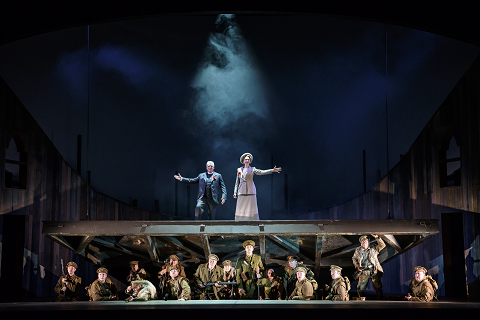 Peter Coleman-Wright (Bard of Britannia), Alexandra Deshorties (Bard of Germania) and Company. Photo credit - Bill Cooper.
Peter Coleman-Wright (Bard of Britannia), Alexandra Deshorties (Bard of Germania) and Company. Photo credit - Bill Cooper.
The set effectively evokes different terrains: a parade ground, a ship’s gang-plank and cabins, a claustrophobic trench, a devastated no-man’s-land and the enemy lines. Later, when the canopy re-descends, we see the German soldiers resting aloft, their tender carol ‘Es ist ein Ros entsprungen’ carrying like a lullaby to the English below who respond with their own song. The spirit of the moment felt familiar. I was put in mind of Kevin Puts’ Pulitzer prize-winning Silent Night which - based upon Christophe Rossignon’s 2005 film, Joyeux Noël, about the WW1 Christmas truce of December 1914 - also depicts the power of music to bring about peace between warring factions, and which I saw at Wexford in 2014 ( review).
The lighting design (Malcolm Rippeth) recreates the multifarious shifts of perspective in Jones’ text - which explores not just Ball’s experience but a collective consciousness - and the hallucinatory worlds into with the poet-dreamer Ball’s mind wanders. Through an oval aperture above the parabolic wooden trench, we peer into a pure azure sky which darkens to indigo. An apricot dawn deepens to blood-crimson, as Ball mounts the ship’s gang-plank and he imagines the fires of hell. As they near the front line, Ball envisions Lieutenant Jenkins as Christ, a shepherd leading his sheep through the wilderness. Rippeth’s disorientating shifts of colour and intensity create a mood that might be termed romantic surrealism, and they are match by Bell’s score which coheres many musical idioms.
The 36-year-old English composer’s technical precision can best be appreciated in the quieter passages (which are also more sympathetic to the voices) where he employs chamber-like textures, the sparseness allowing individual instruments and small groupings to offer eloquent elegiac commentaries. Britten’s The Turn of the Screw and Death in Venice came to mind. The bass-dominant orchestration foregrounds harp - tolling resoundingly and low - and timpani, thudding and sliding, eerily and achingly. The delicacies - which reflect Jones’ prevailing tone of understatement - also make the moments of brutality which annihilate the false peace more shocking, though they are less interesting or inventive musically.
Bell writes sensitively for the voice and the vocal lines are finely shaped and spacious. Jones’ verse is condensed and fragmented but it nevertheless has a strong inner rhythm, particularly in the moments of mythical quasi-incantation, and Bell’s melodic idiom captures this intensity well.
The cast sing committedly and bravely, and though American tenor Andrew Bidlack, as Private John Ball, has the lion’s share of the stage-time, this genuinely is an opera of collective voices. Ball is the epitome of Frost’s soldier-poet: he is impractical, naïve, late for parade, but if he is hapless he is also heroic. Bidlack began with youthful brightness and openness but found the role quite taxing.
The officers and rank-and-file soldiers are resilient of spirit and vibrant of voice. Baritone George Humphreys used his clear, ringing baritone to make Lieutenant Jenkins an inspiring leader of men. Tenor Mark le Brocq was a dynamic Snell; in contrast, Marcus Farnsworth’s lyricism conveyed Lance-Corporal Lewis’s whimsy and wistfulness. In Jones’ text, on the eve of battle Lewis and Ball retreat to a ‘real’ world which now seems incredible, talking of ‘ordinary things [...] of the possible duration of the war. Of how they would meet and in what good places afterwards [...] Of if you’d ever read the books of Mr. Wells. Of the poetry of Rupert Brooke’. In the opera, the friends’ contemplative duet, just moments before the carnage, was a refuge of peace which emphasised the wretched waste and futility of the ensuing slaughter: only Ball, injured in the leg, survives.
Donald Maxwell put in a superb character-performance as the archetypal Dai Greatcoat, arguing trenchantly with Graham Clark’s tetchy Marne Sergeant about their respective ancestries and delivering a boastful post-prandial claim to have fought in every human conflict since the fall of Lucifer: his forebears fought alongside the Black Prince against the French at Crecy, while he himself was by a liege of King Arthur.
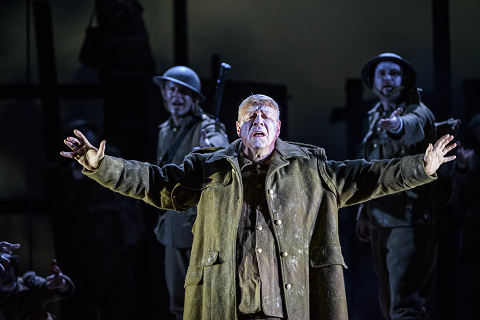 Donald Maxwell as Dai Greatcoat. Photo credit - Bill Cooper.
Donald Maxwell as Dai Greatcoat. Photo credit - Bill Cooper.
The male chorus of soldiers gave a robust rendition of the Llanelli anthem, Sospan bach, but it was the women - as the Chorus of Remembrance or when entertaining the troops in a French bar - who excelled. But, when the devastated Mametz Wood was regenerated by the Queen of the Woods, the Chorus’s transformation into dryadic trees, complete with twig fingers and flower-sprouting hats, was a mythic vision too far. Moreover, there was something about this adaptation of Jones’ poem - sensitive, insightful and assuredly directed though it was - that caused me to ponder the aesthetic depiction of the horrors of war through images which, repeated over time, may fade into familiarity.
In his Preface to In Parenthesis, Jones explains that the ten years which passed between the end of the war and his first attempts to write of his experiences allowed him ‘to appreciate some things which, at the time of suffering, the flesh was too weak to appraise’, and gave those experiences their literary form. In Parenthesis brackets the years 1914-18 within a historic past and as genuine happenings blend with myth, moral ugliness is transformed into aesthetic beauty. Jones is honest and tender; there is no complicity with war, but the men themselves are ennobled by the convergence of past and present, epic and commonplace.
In The Literature of War: Five studies in Heroic Virtue (1978) Andrew Rutherford, praises post-war novelists who have given new shape to the experience of war: ‘honesty, inclusiveness, psychological and moral insight, and the accurate notation of experience are all desiderata in war literature, but they are not sufficient in themselves: they must be combined with the search for an appropriate form and the struggle to articulate through this the author’s complex vision of the truth.’
Jones found that form. Now one hundred years have passed. Is there anything more to add to the words of man described by Stephen Spender as ‘like Thoreau, Melville and Hopkins … one of literature’s saints who speak with an authority that comes more from religion than from the world of letters’. Perhaps I am troubled by the thought that in our desire to keep the experiences of men like Jones alive in our cultural memory, as of course we must, we are in danger of diminishing the impact of such men’s honesty. But, perhaps it was just the coincidence of events - centenary, referendum, performance - that prompted my reflections. Bell’s opera is well-crafted, WNO’s performance well-drilled, and both will bring Jones’ voice to a wider public.
Claire Seymour
Iain Bell: In Parenthesis
Libretto: David Antrobus and Emma Jenkins
Private John Ball - Andrew Bidlack, Bard of Britannia/HQ Officer -Peter Coleman-Wright, Bard of Germania/Alice the Barmaid/The Queen of the Woods -Alexandra Deshorties, Lieutenant Jenkins -George Humphreys, Lance Corporal Lewis -Marcus Farnsworth, Sergeant Snell -Mark Le Brocq, Dai Greatcoat -Donald Maxwell, The Marne Sergeant - Graham Clark, Private Watcyn - Joe Roche, Private Wastebottom - Martin Lloyd, German Soldier/Runner - Simon Crosby Buttle; Director - David Pountney, Conductor - Carlo Rizzi, Designer - Robert Innes Hopkins, Lighting designer - Malcolm Rippeth (realised on tour by Ian Jones), Fight director - Kevin McCurdy, Welsh National Opera Orchestra and Chorus.
Royal Opera House, Covent Garden, London; Wednesday 29th June 2016.
image=http://www.operatoday.com/WNO%20In%20Parenthesis.%20Photo%20credit%20-%20Bill%20Cooper%20925.png image_description=In Parenthesis, Welsh National Opera product=yes product_title=In Parenthesis, Welsh National Opera product_by=A review by Claire Seymour product_id=Above: In Parenthesis, Welsh National Opera at Covent GardenPhoto credit: Bill Cooper.